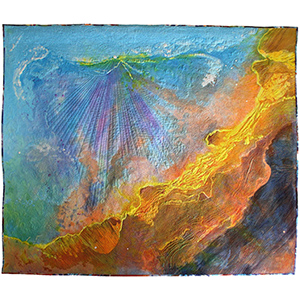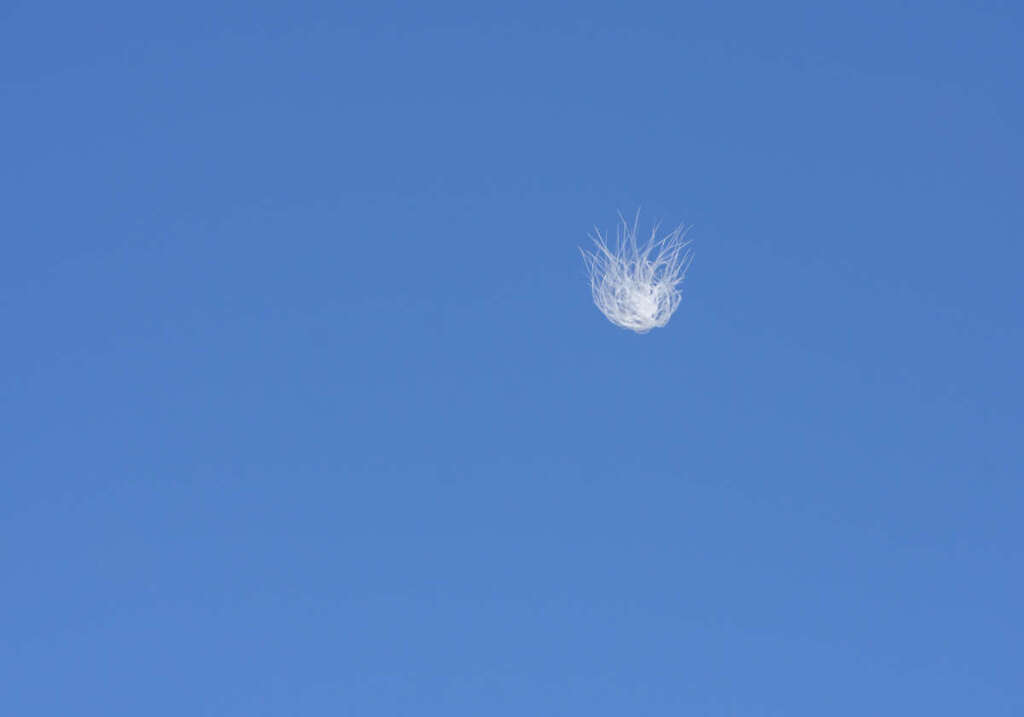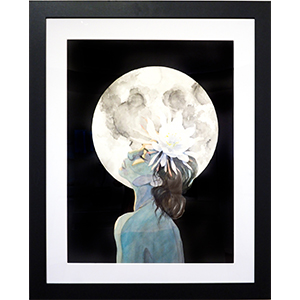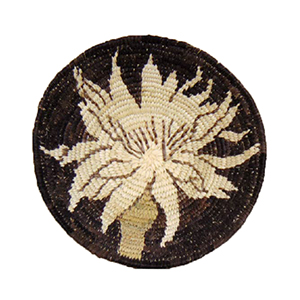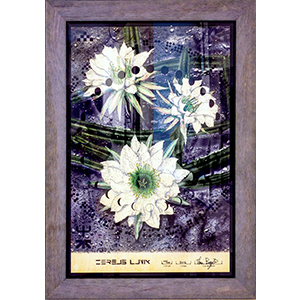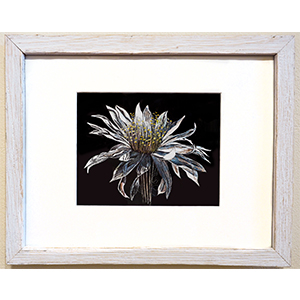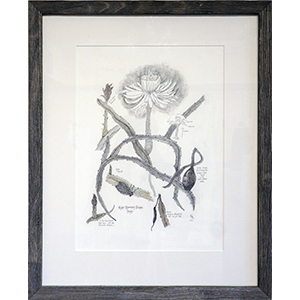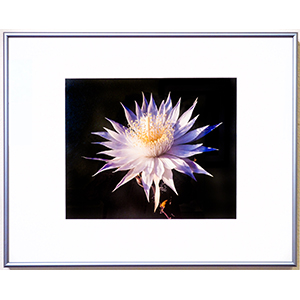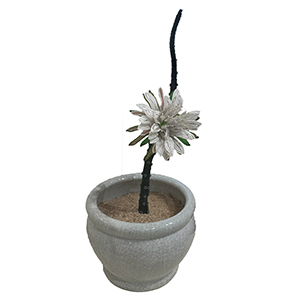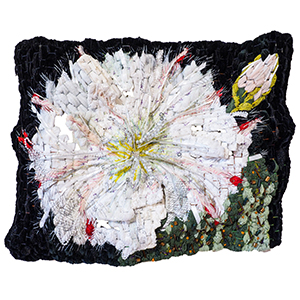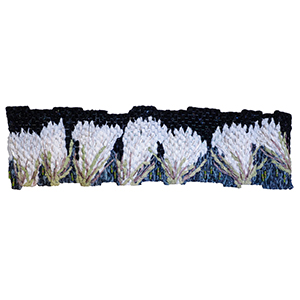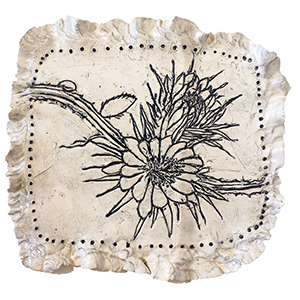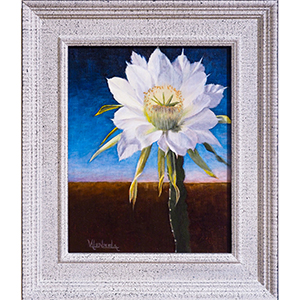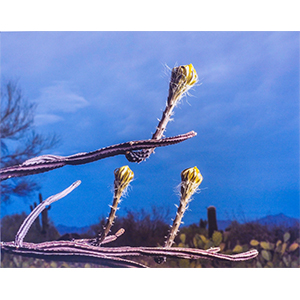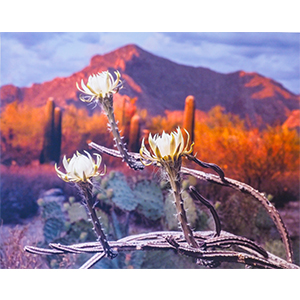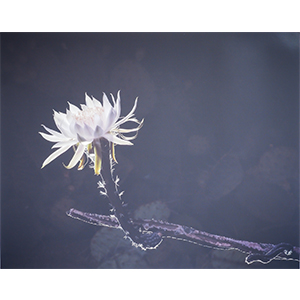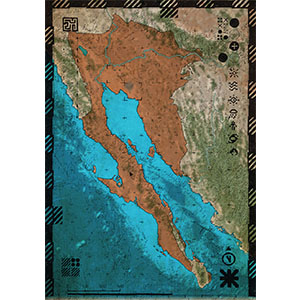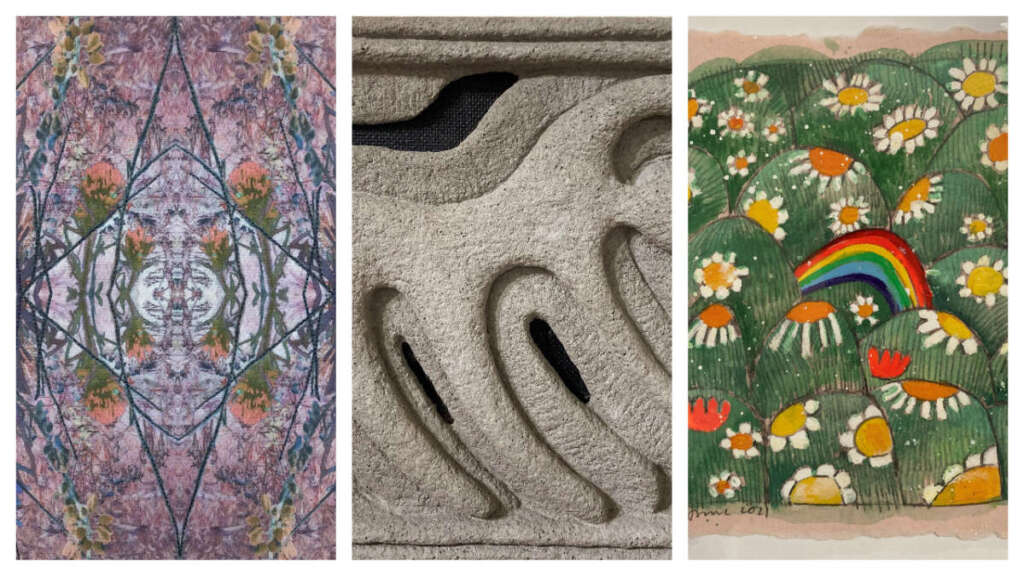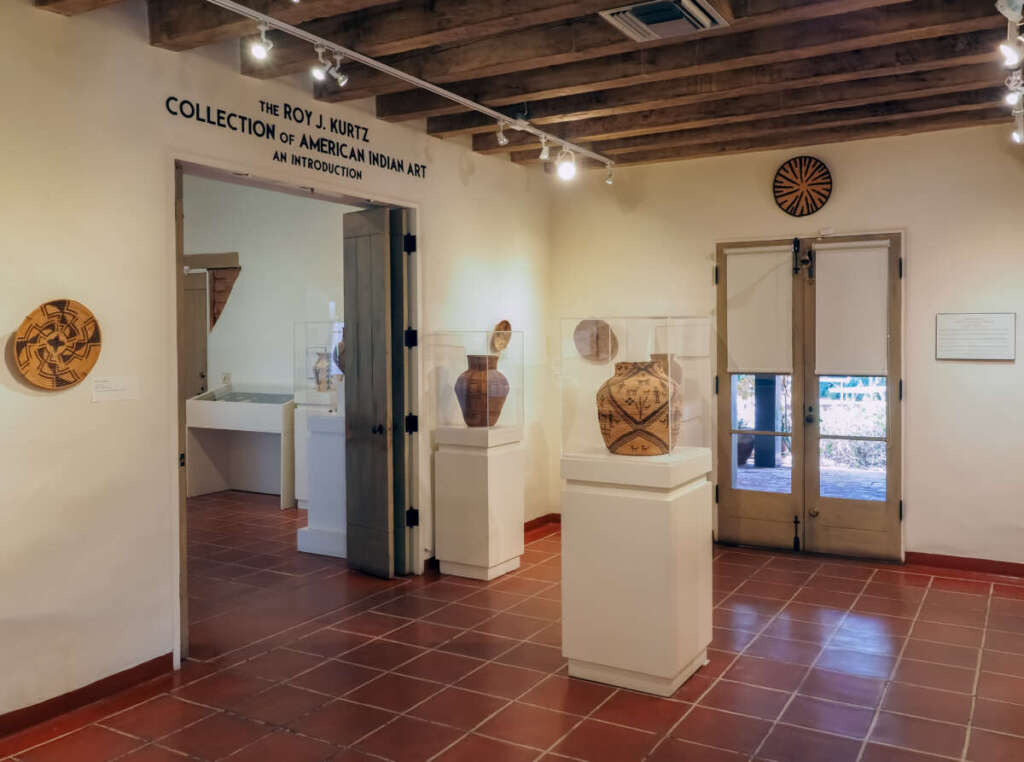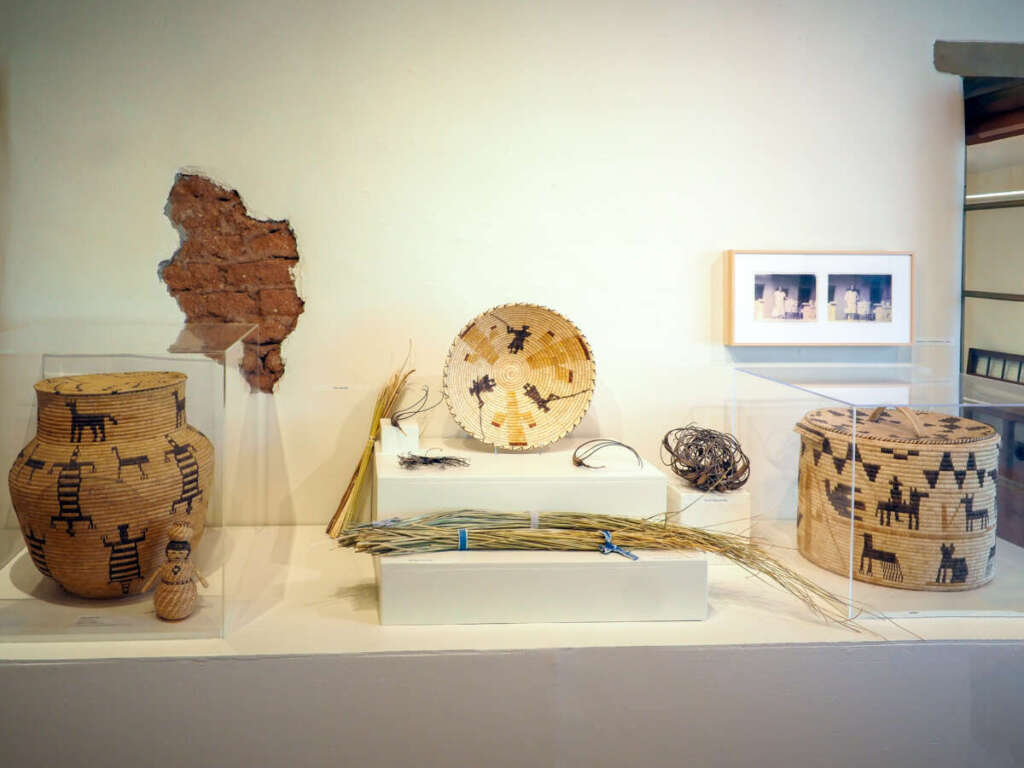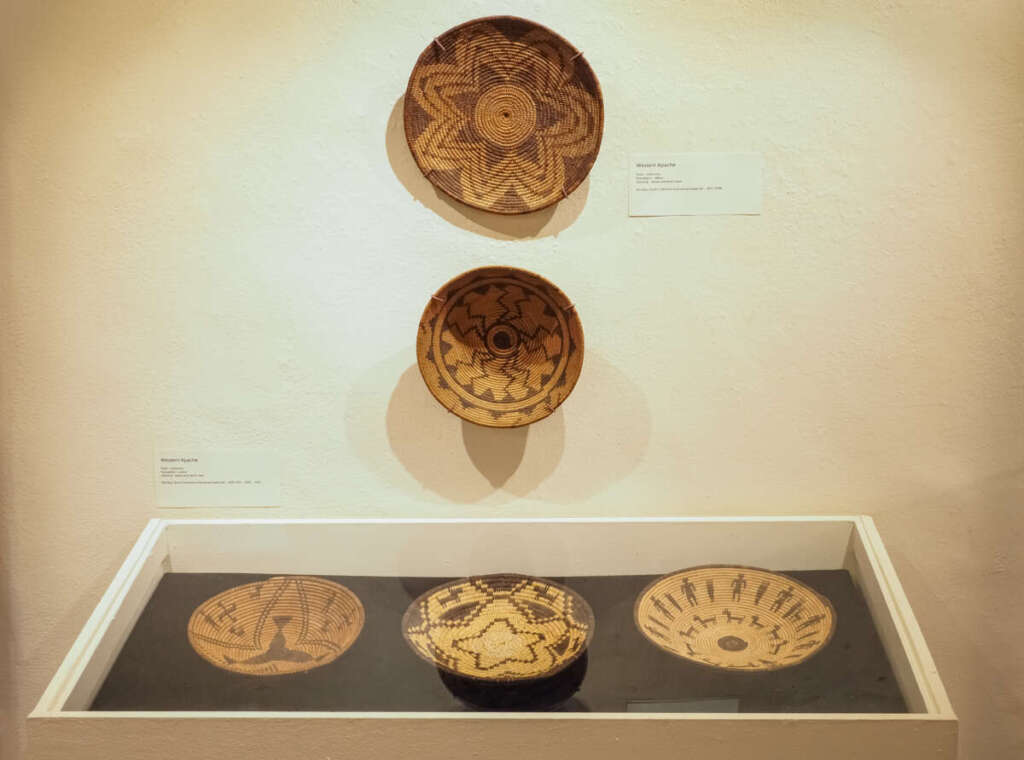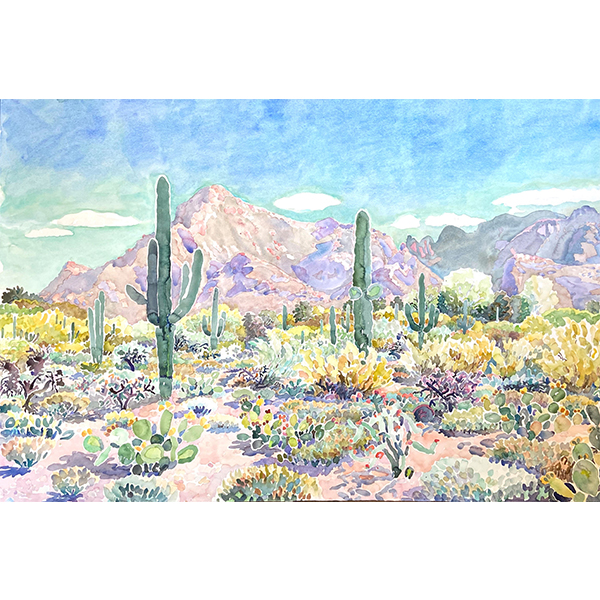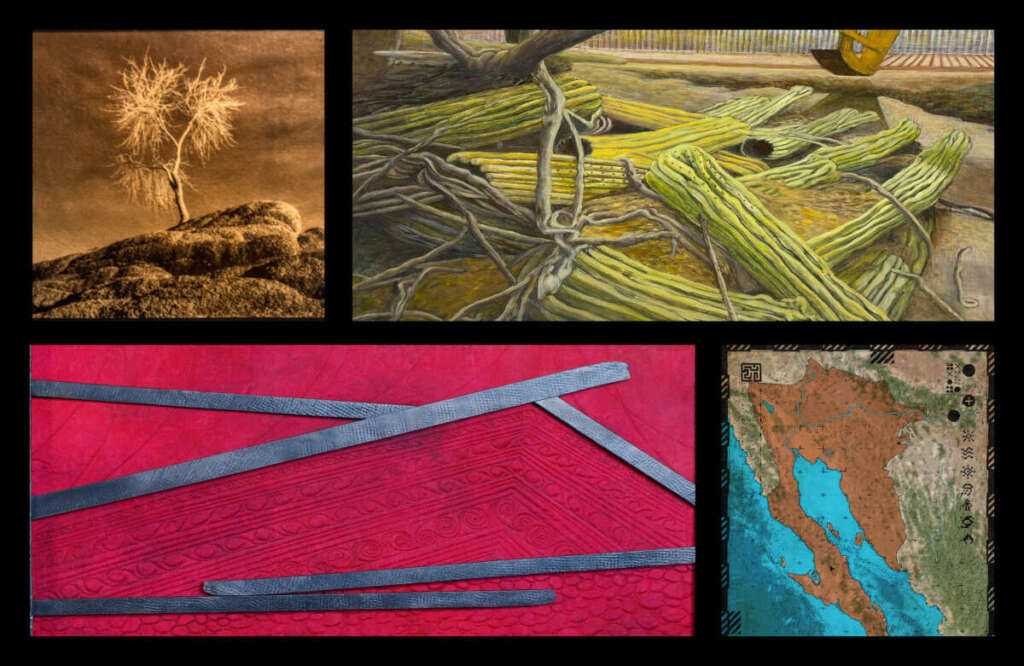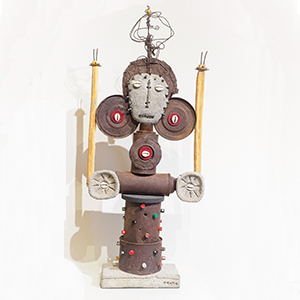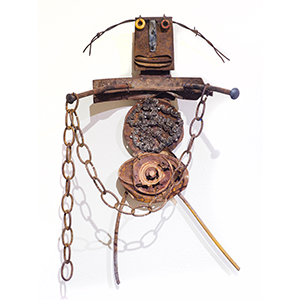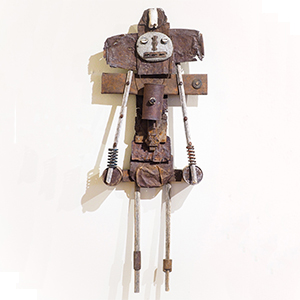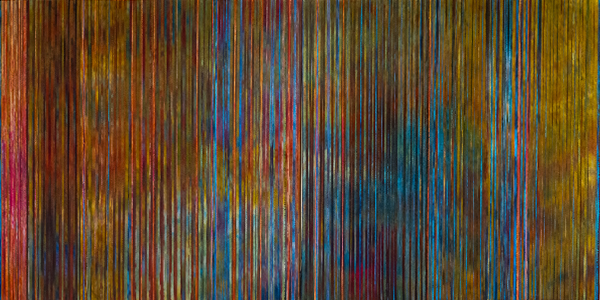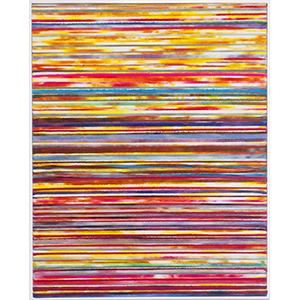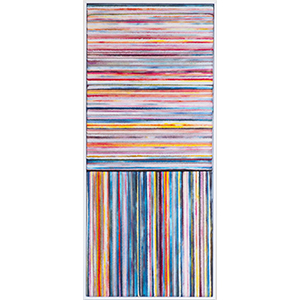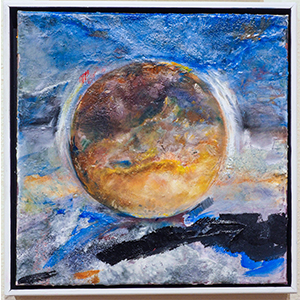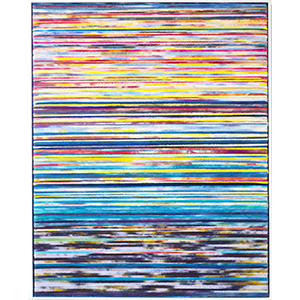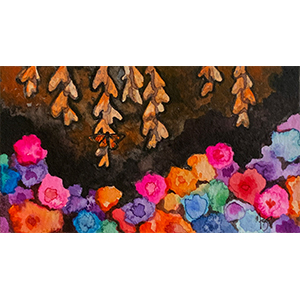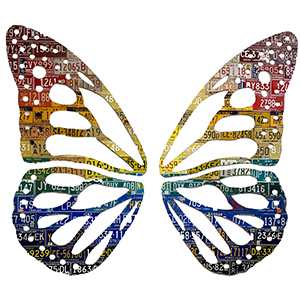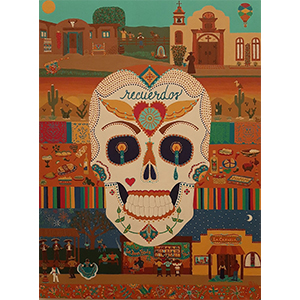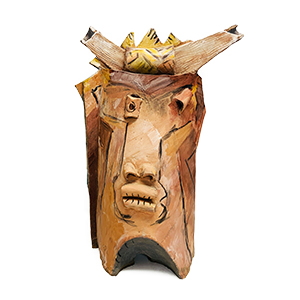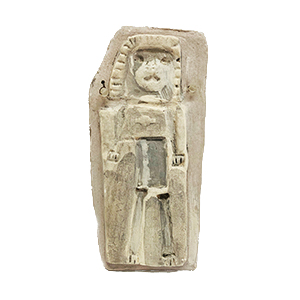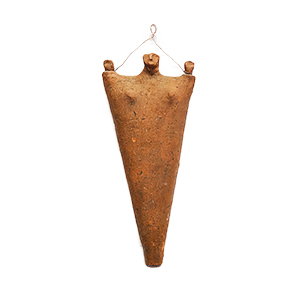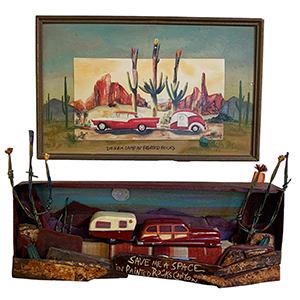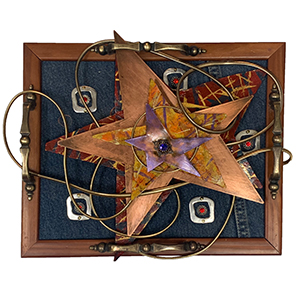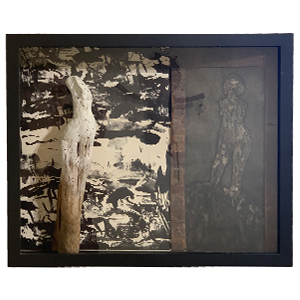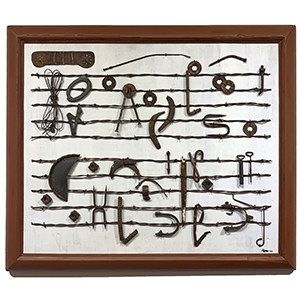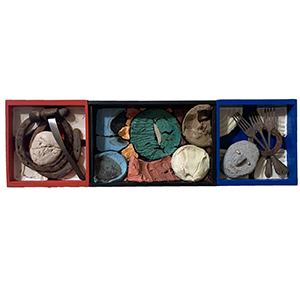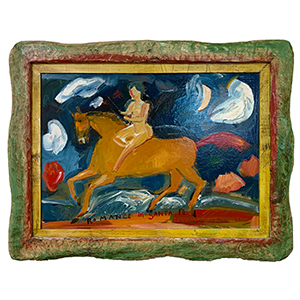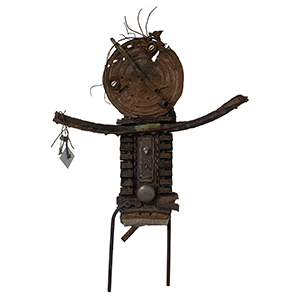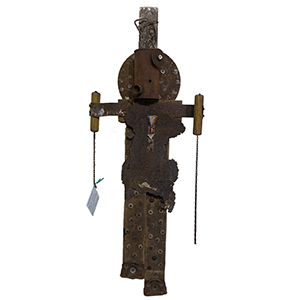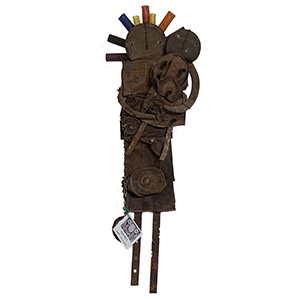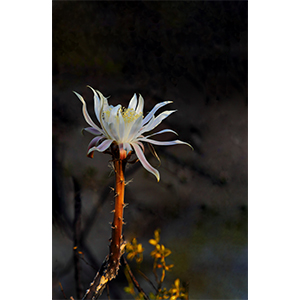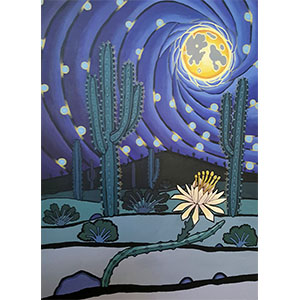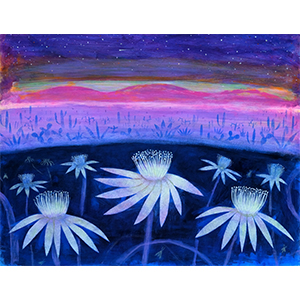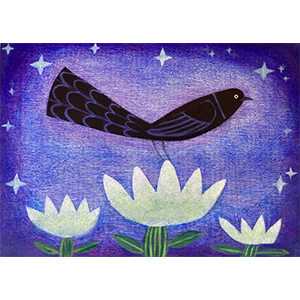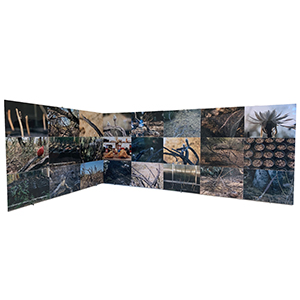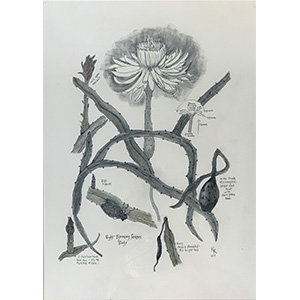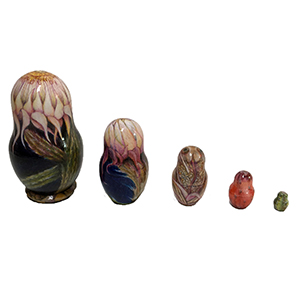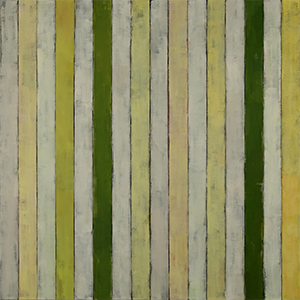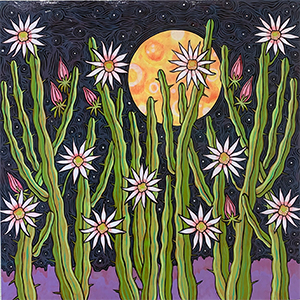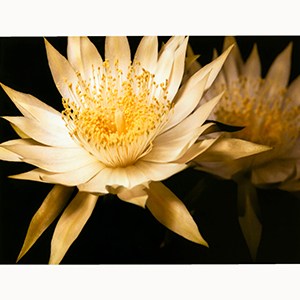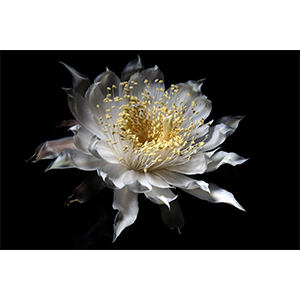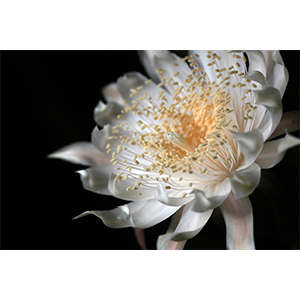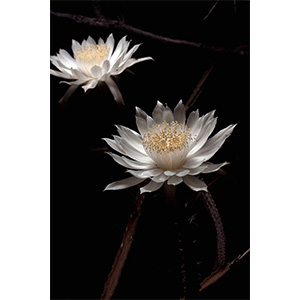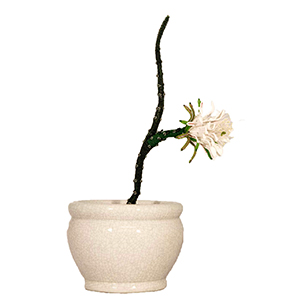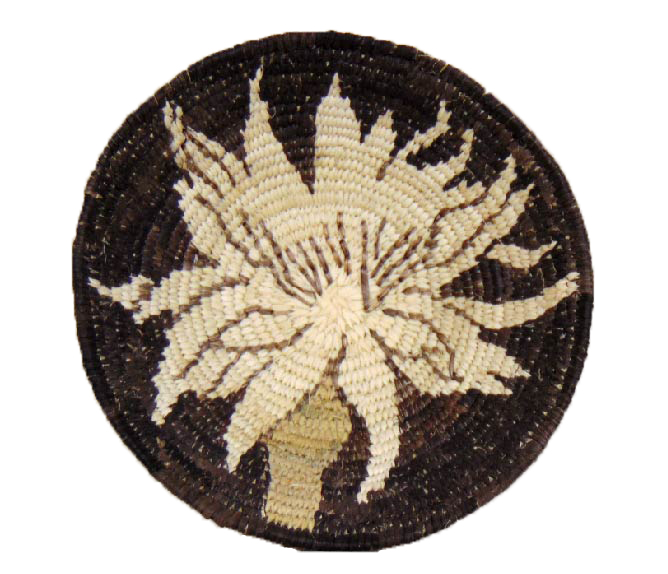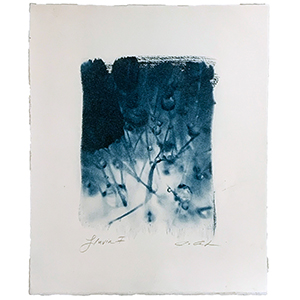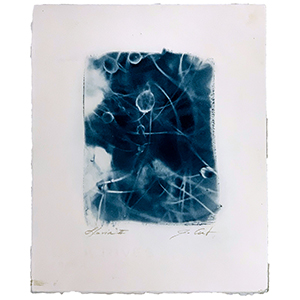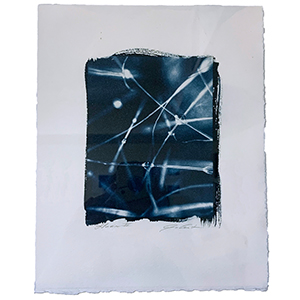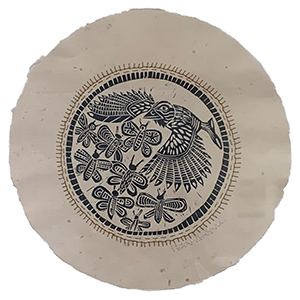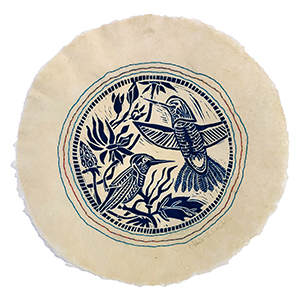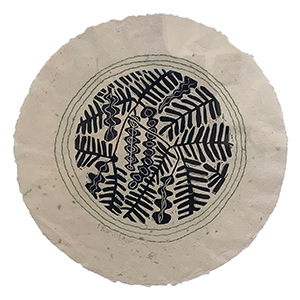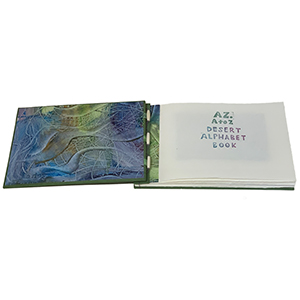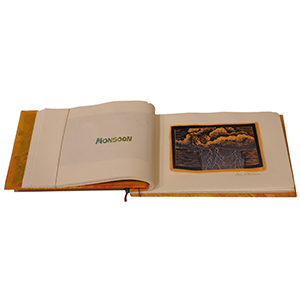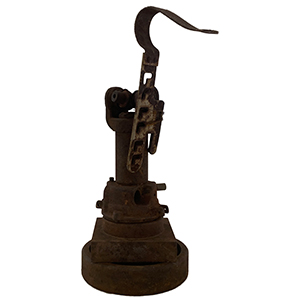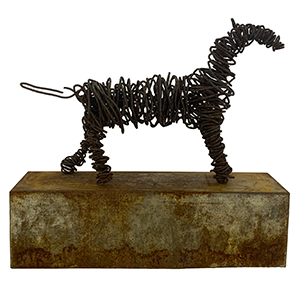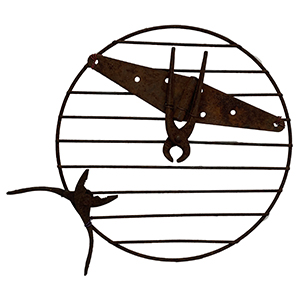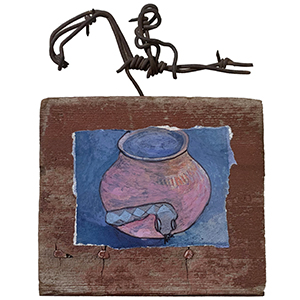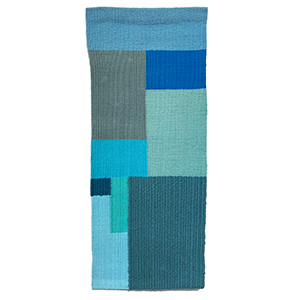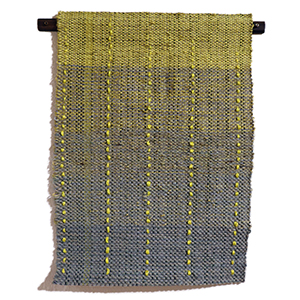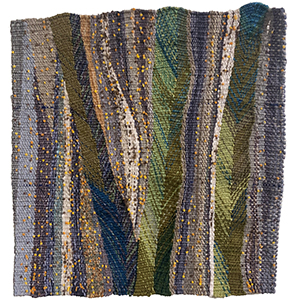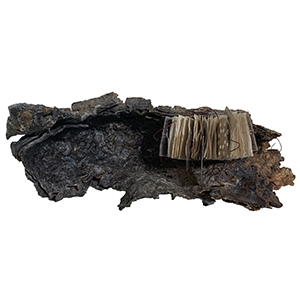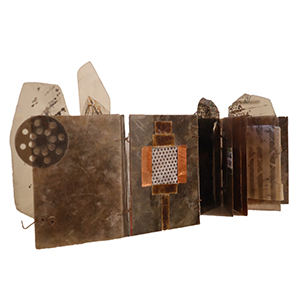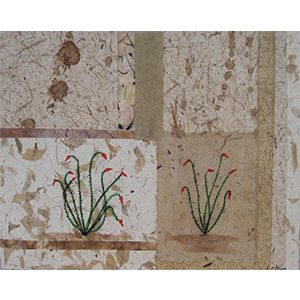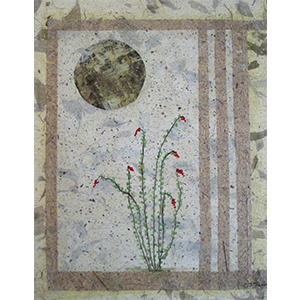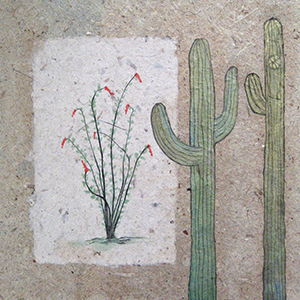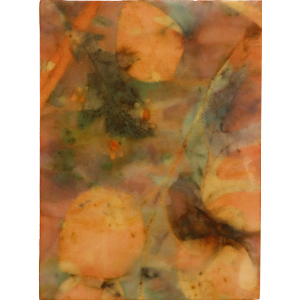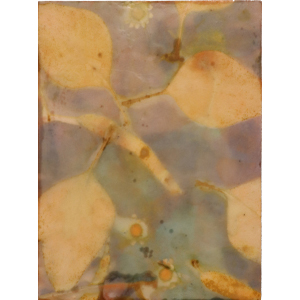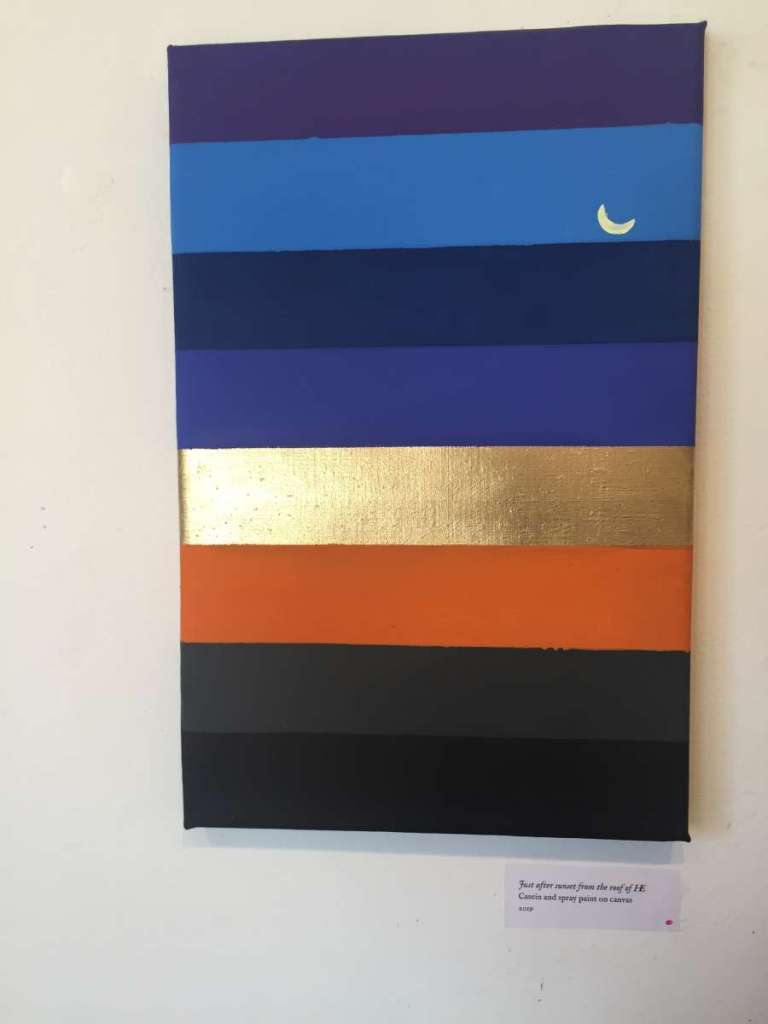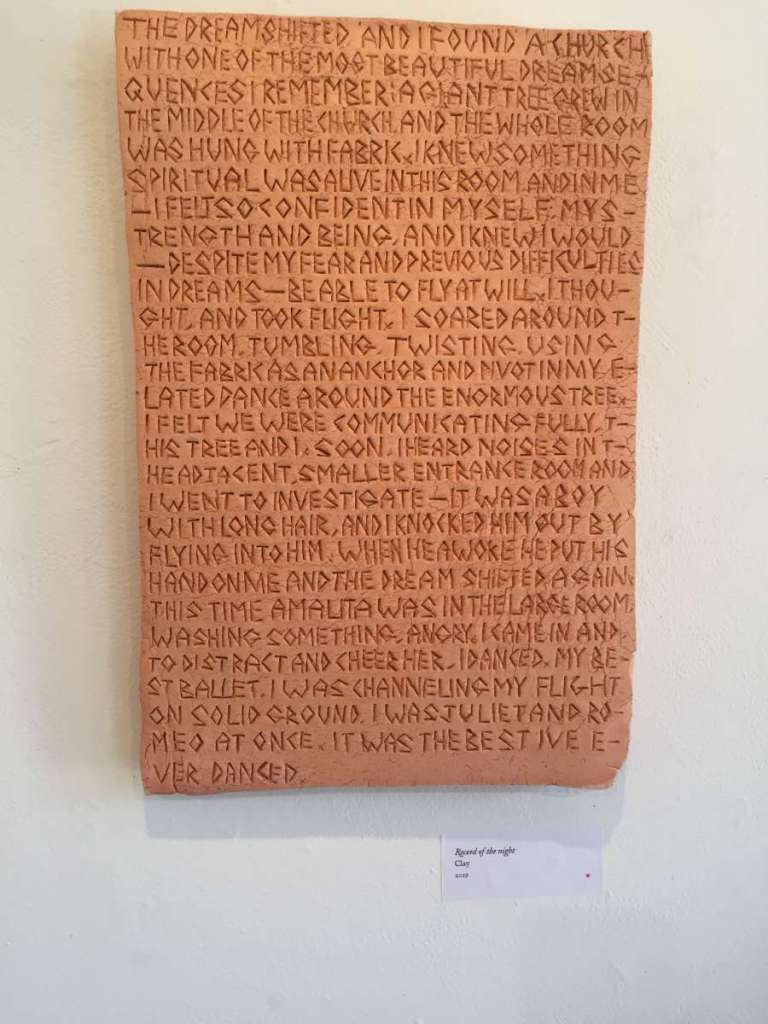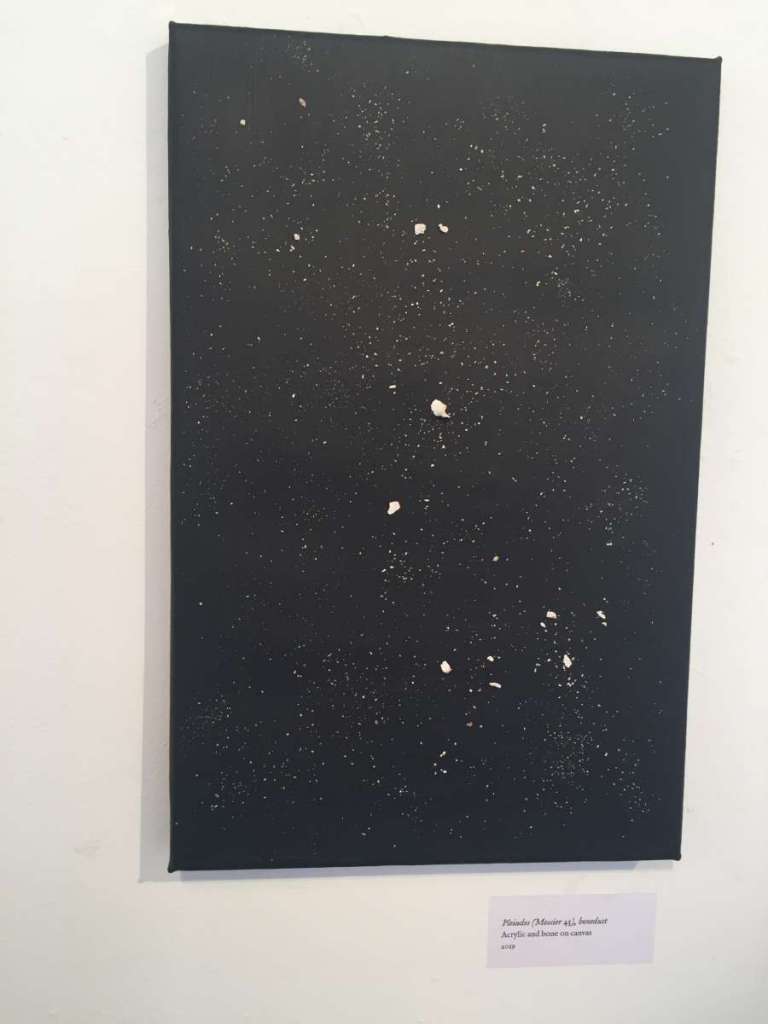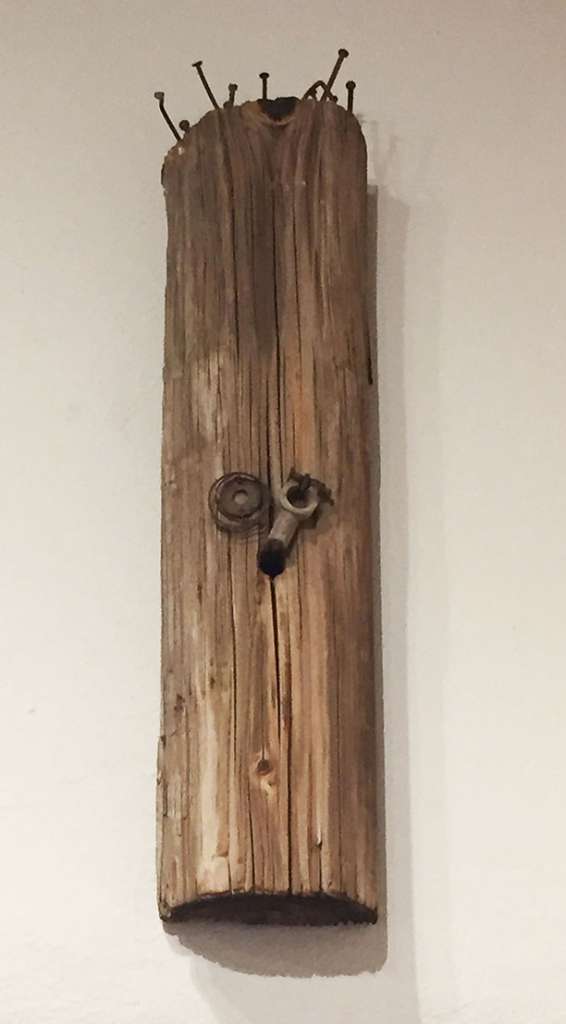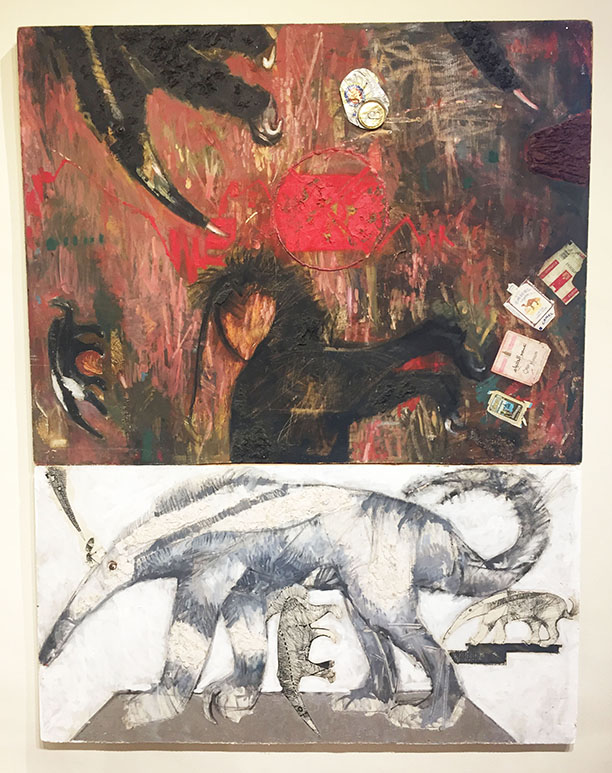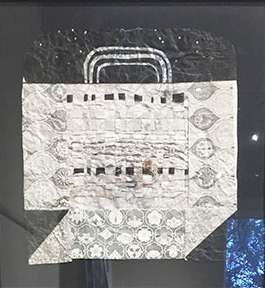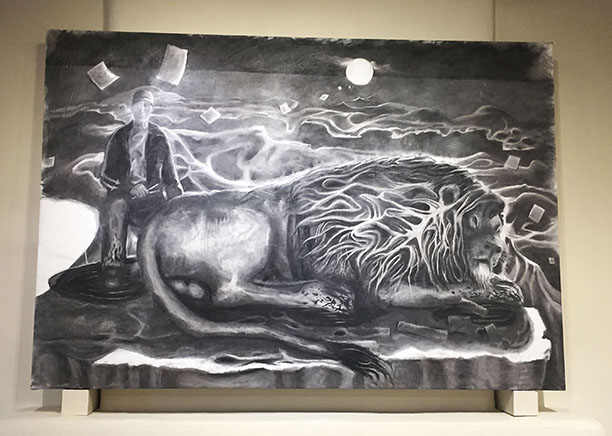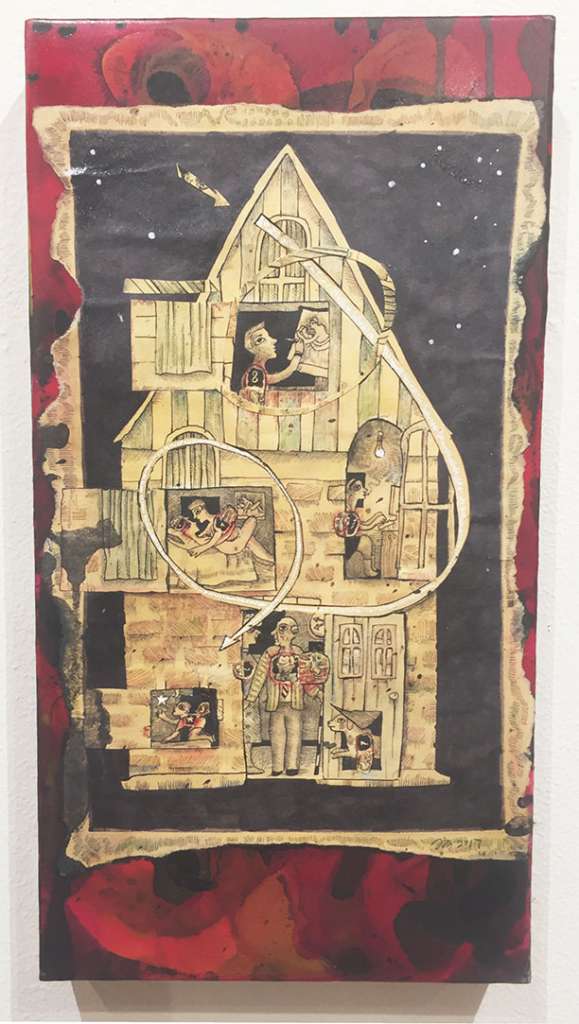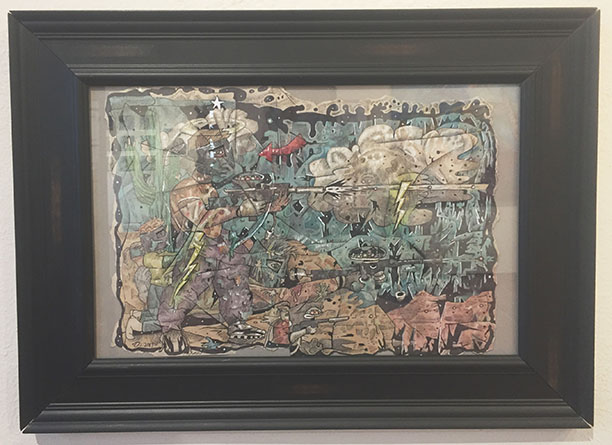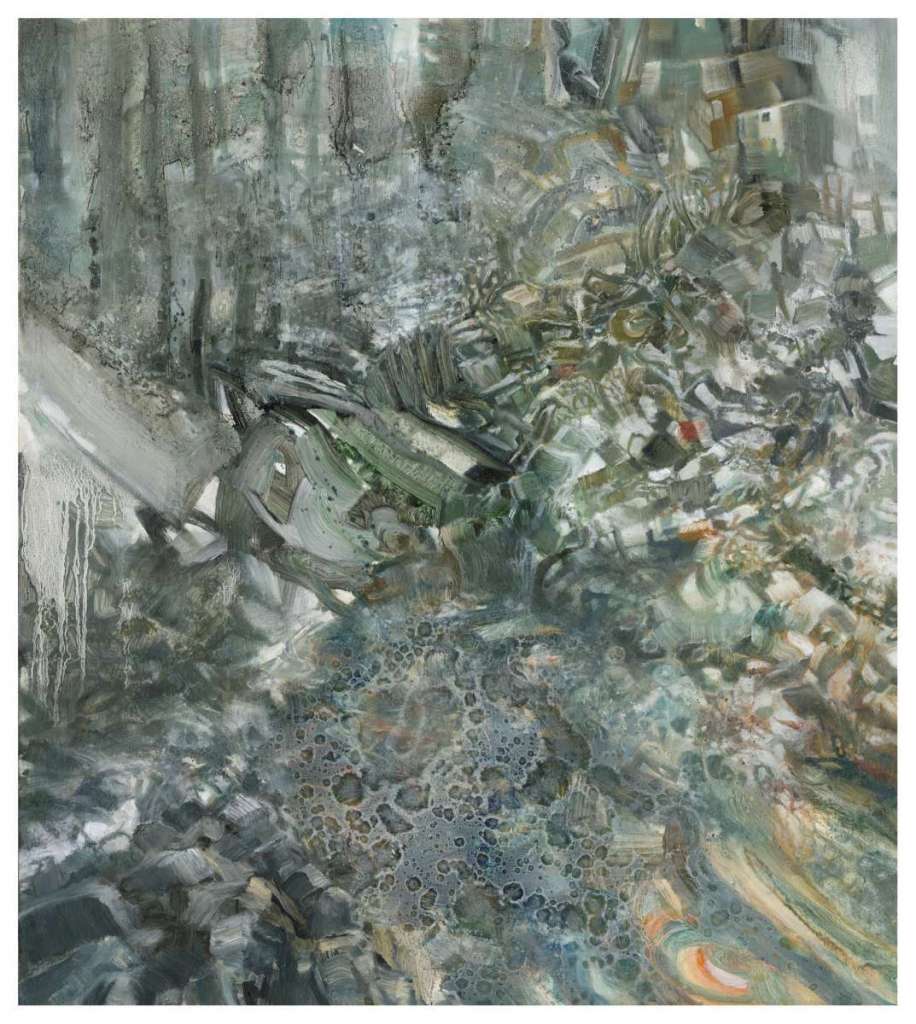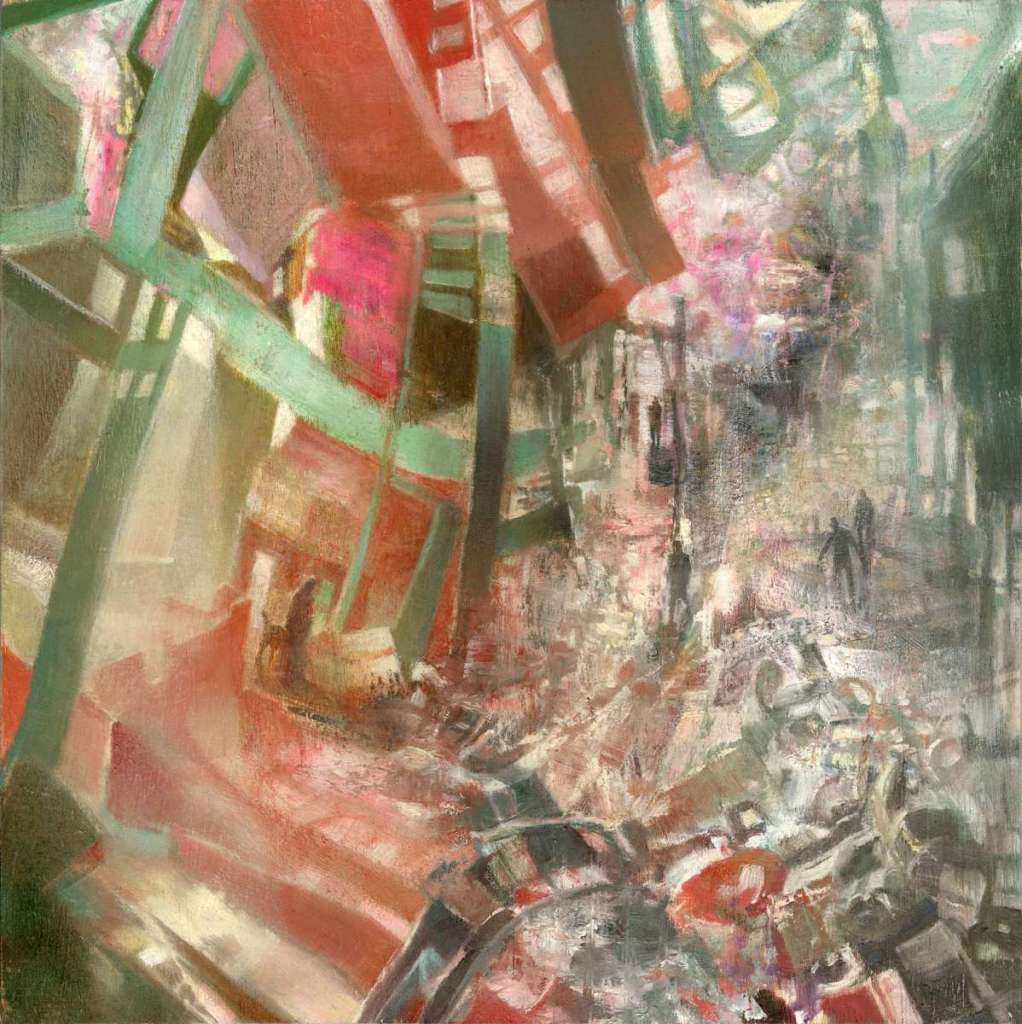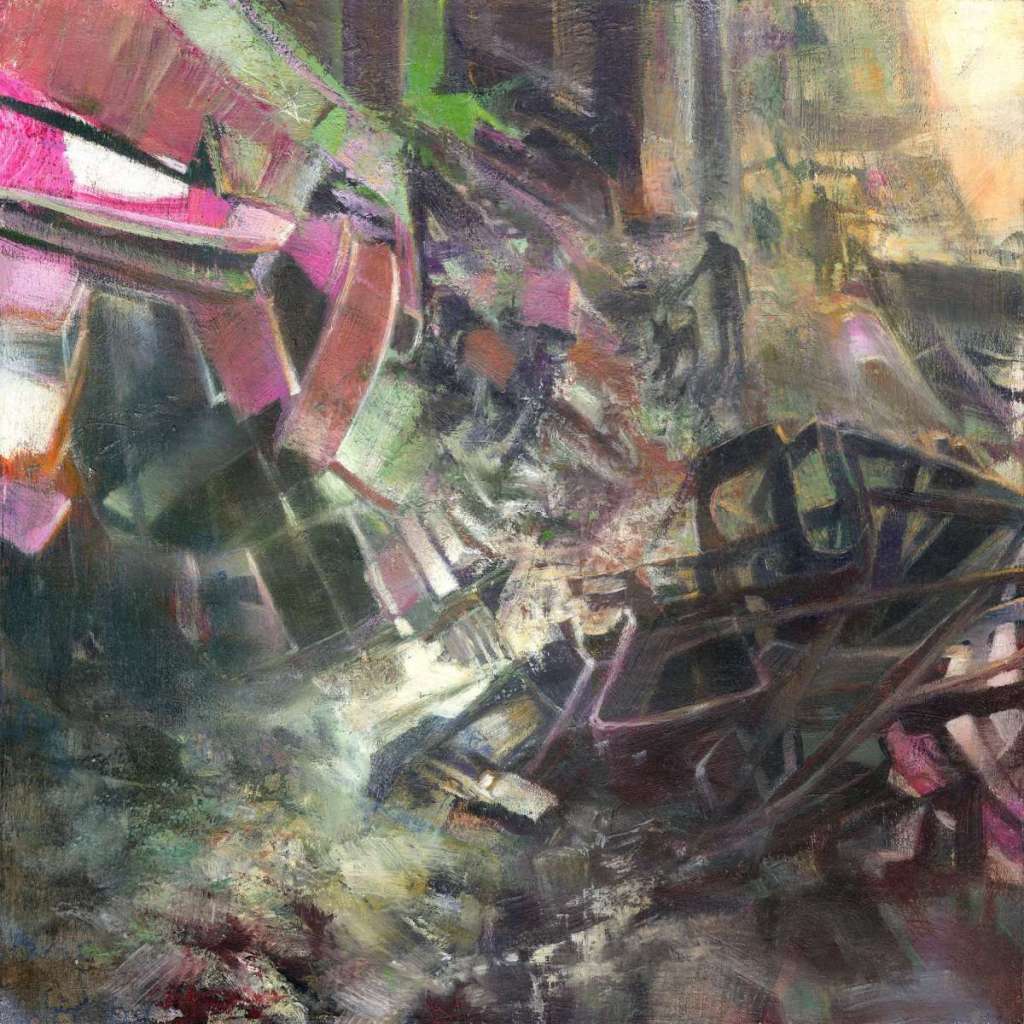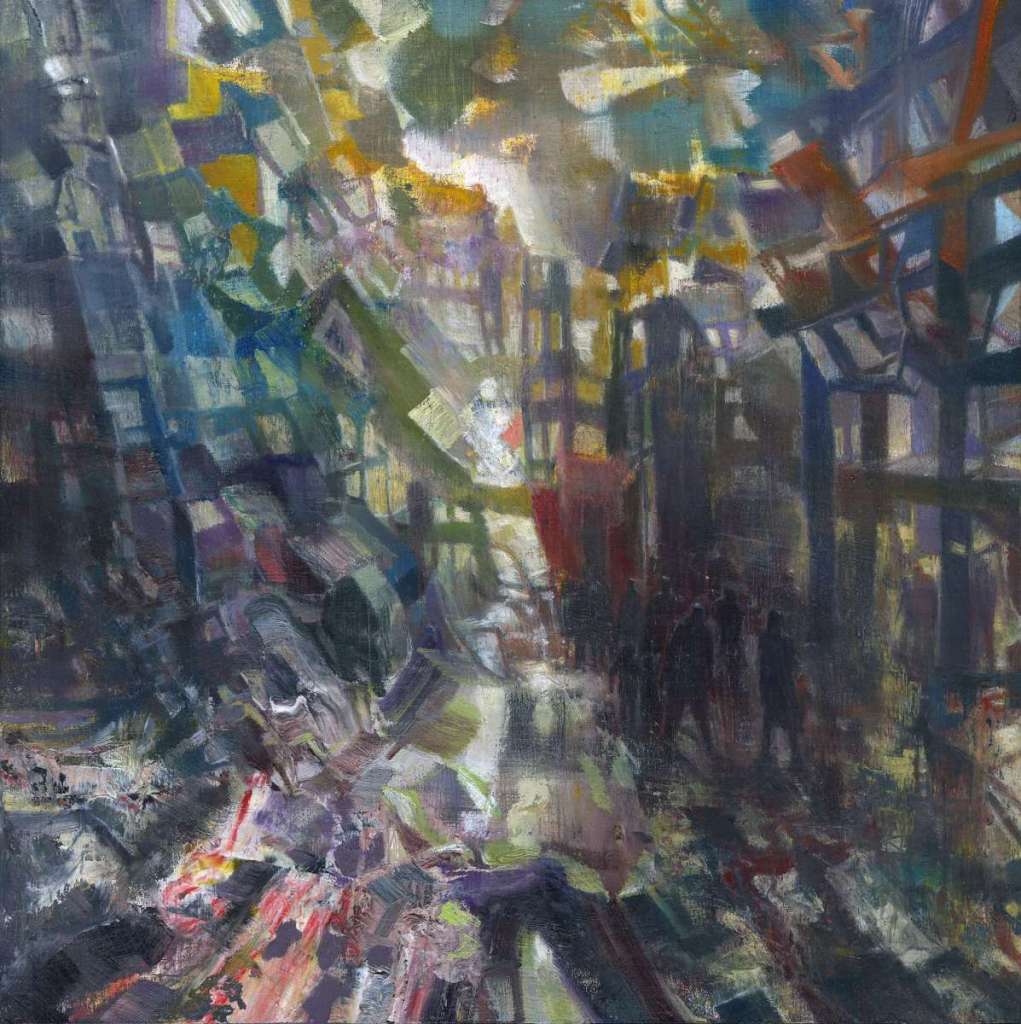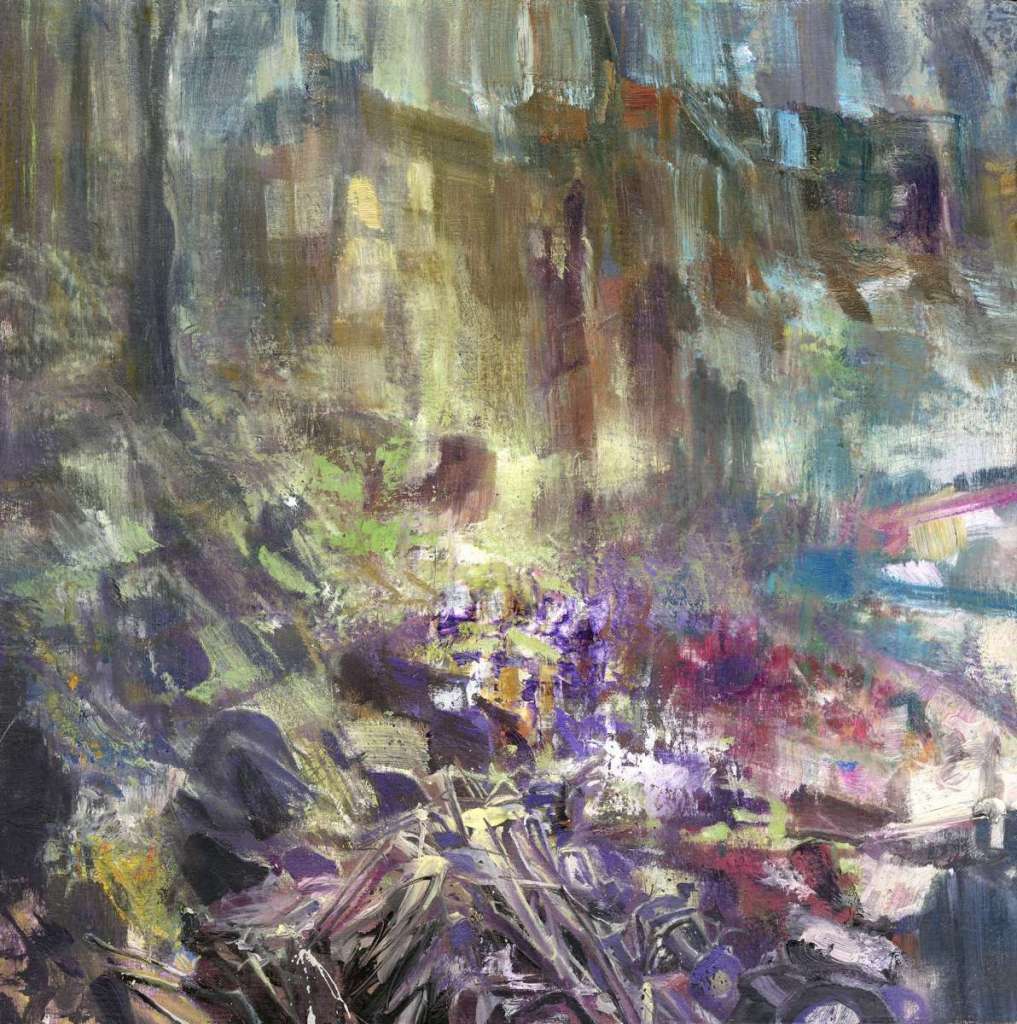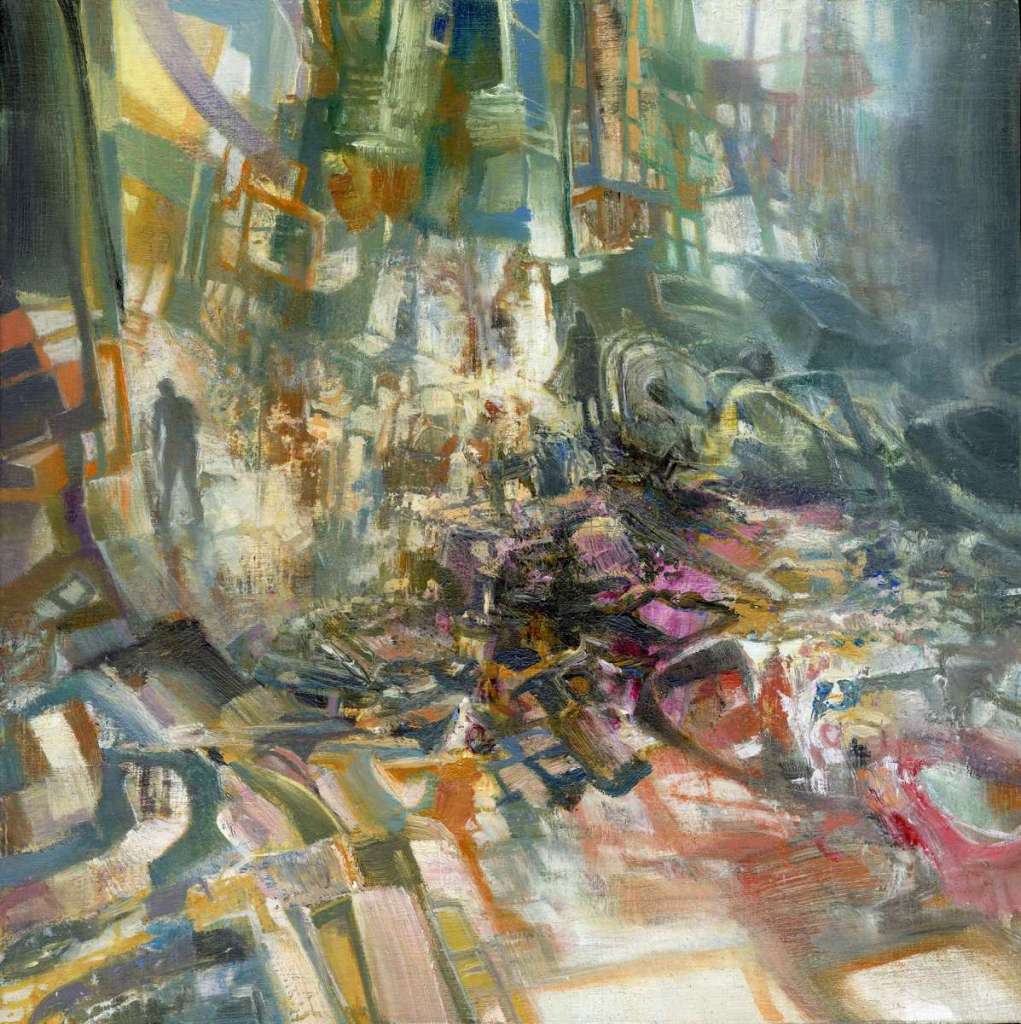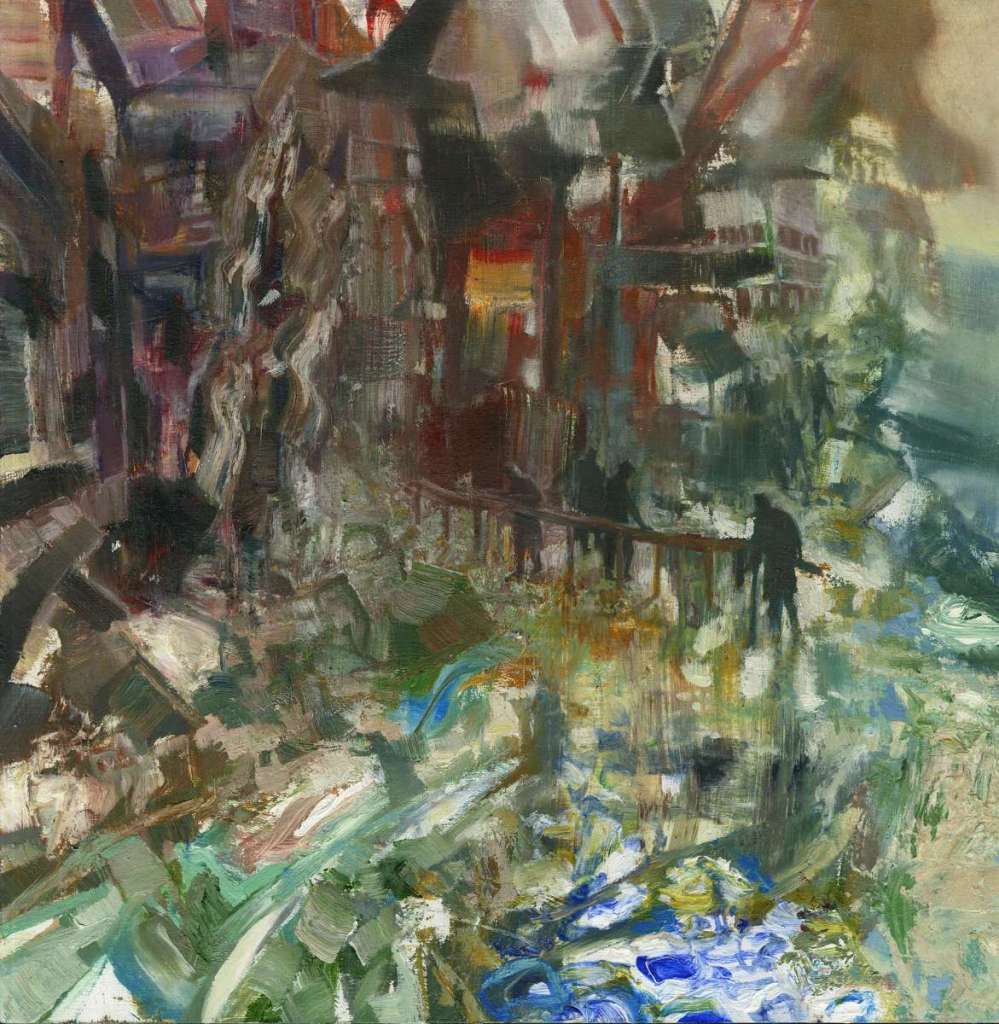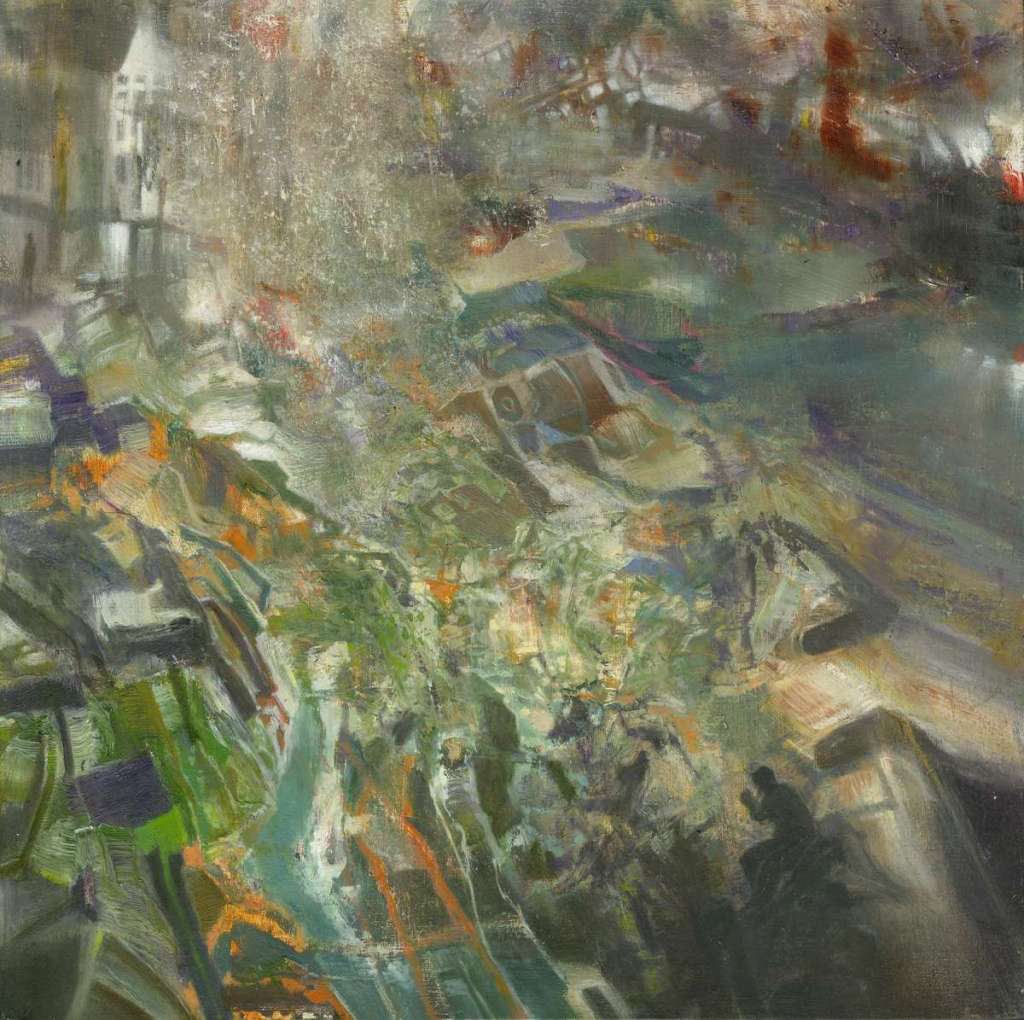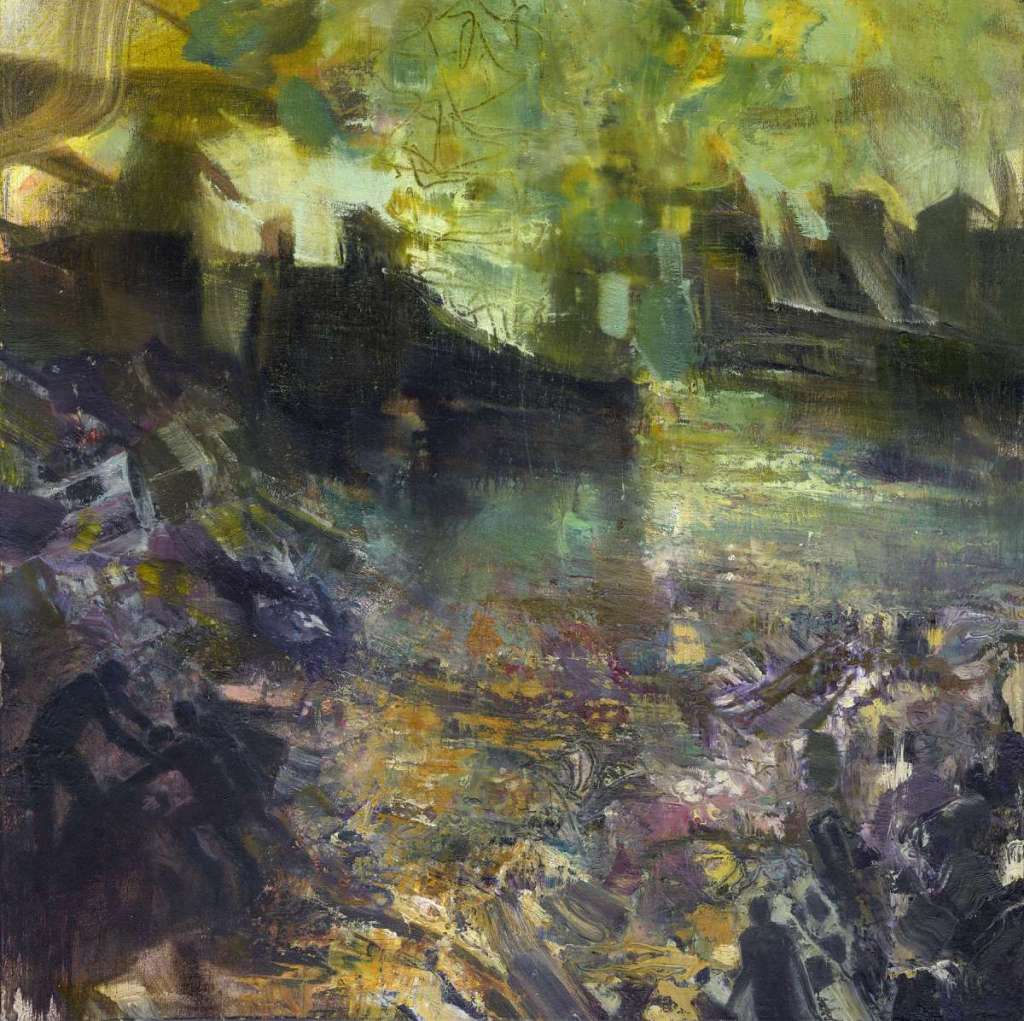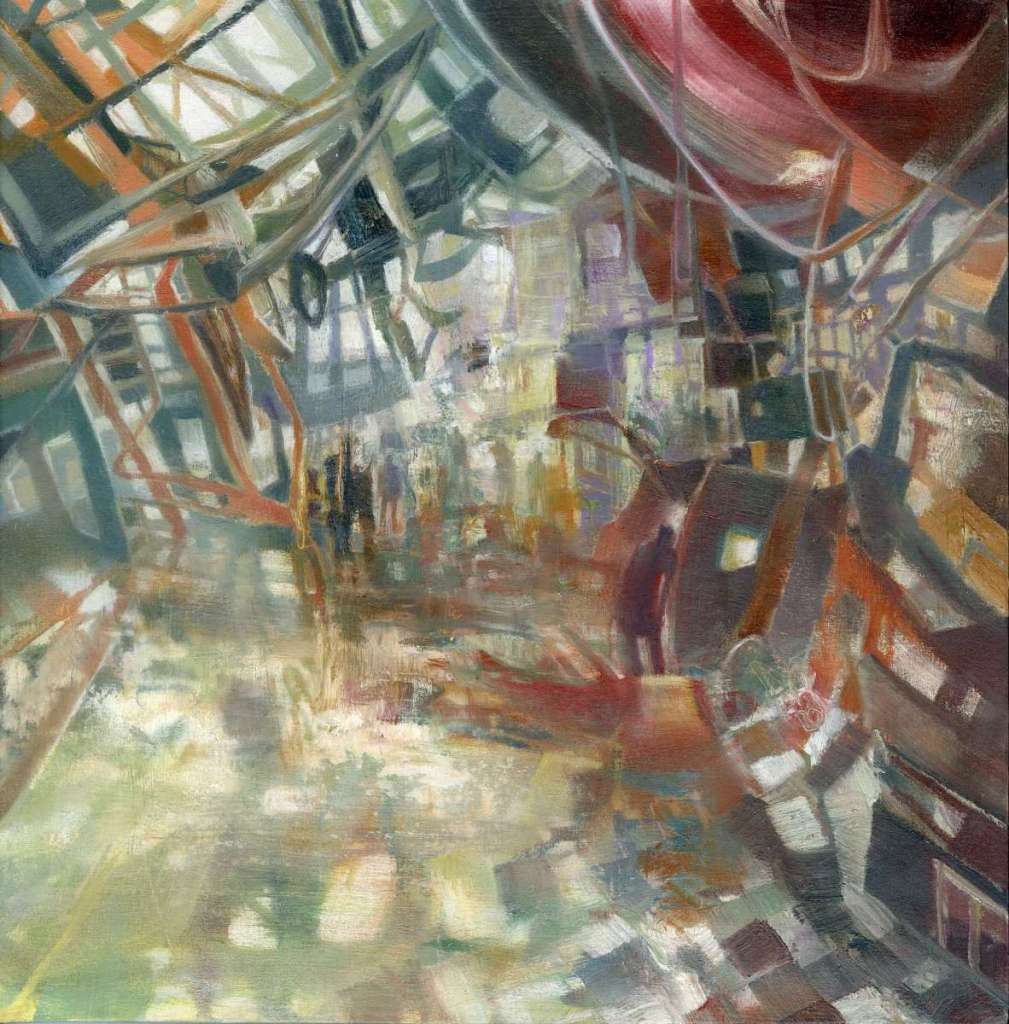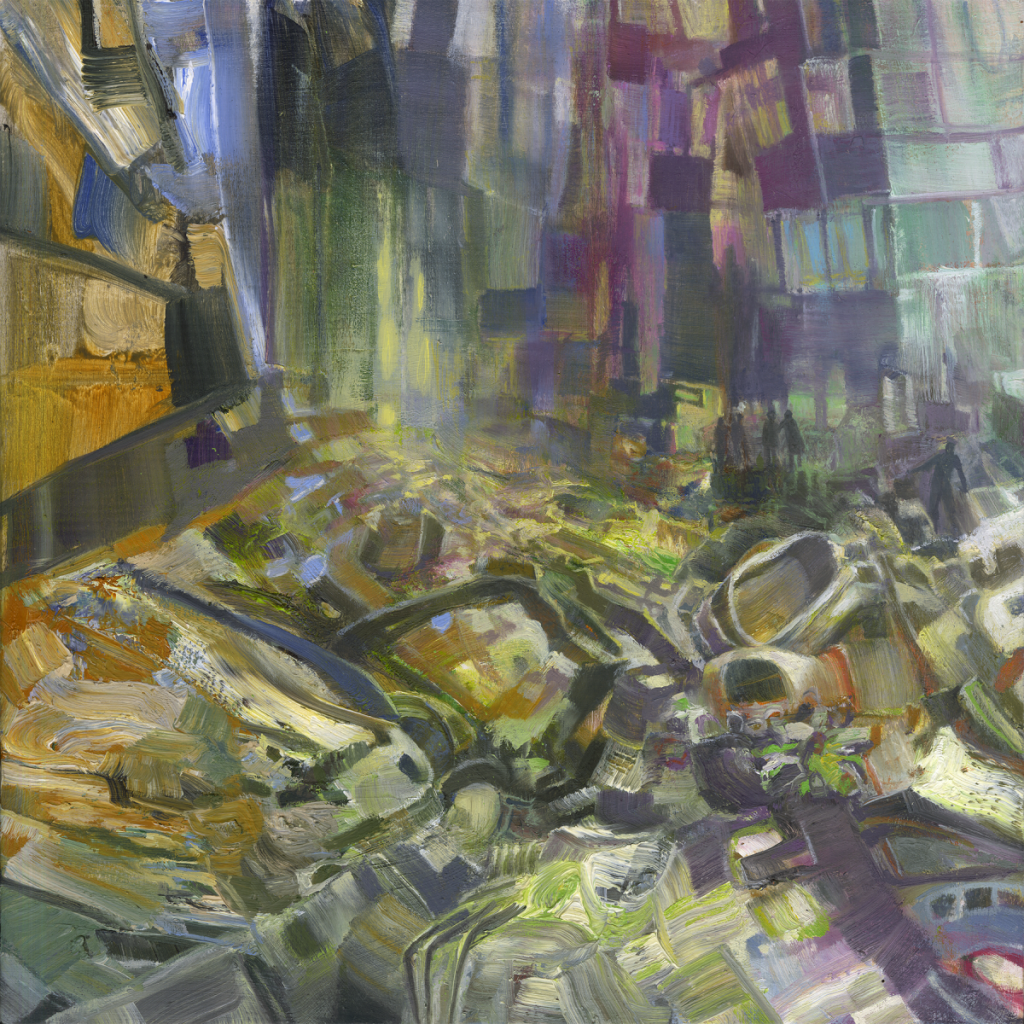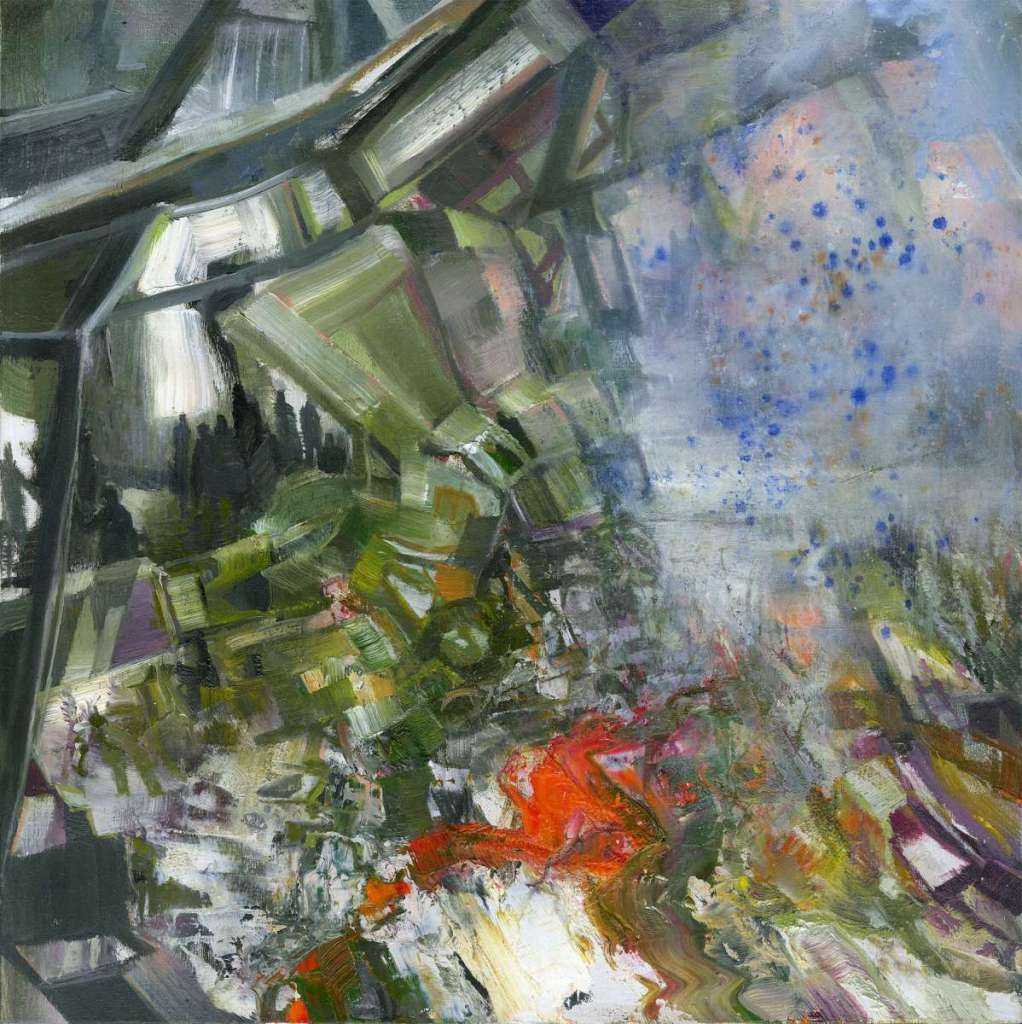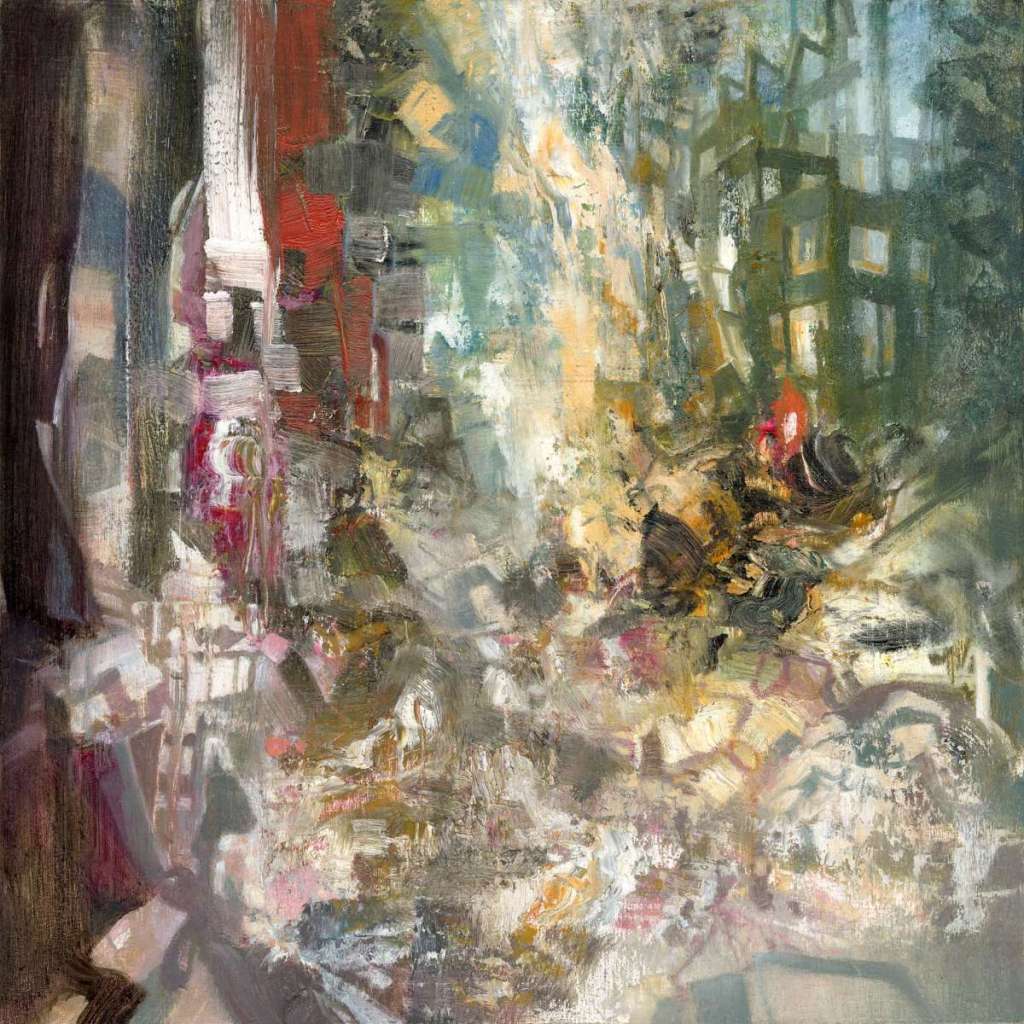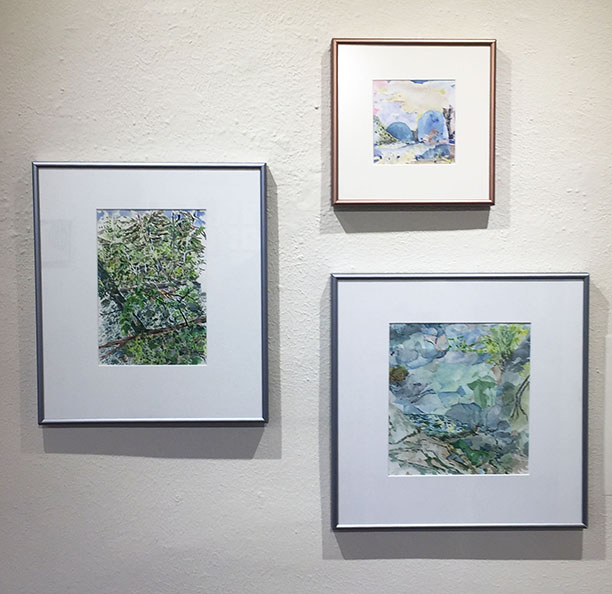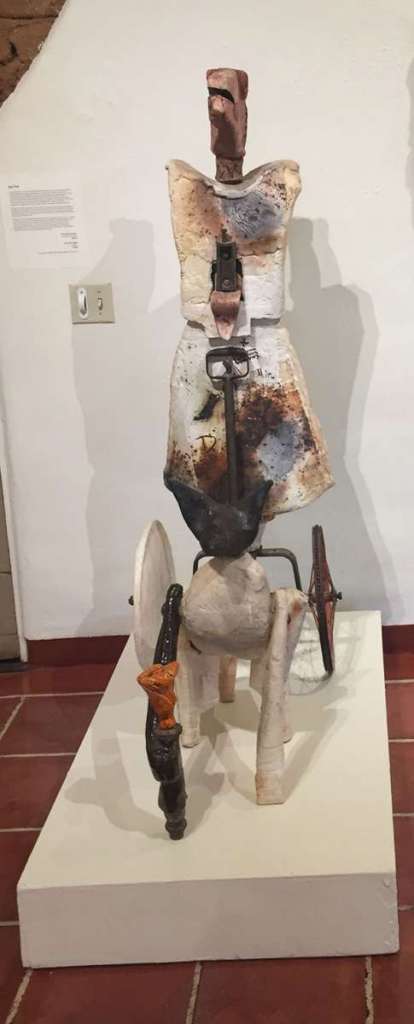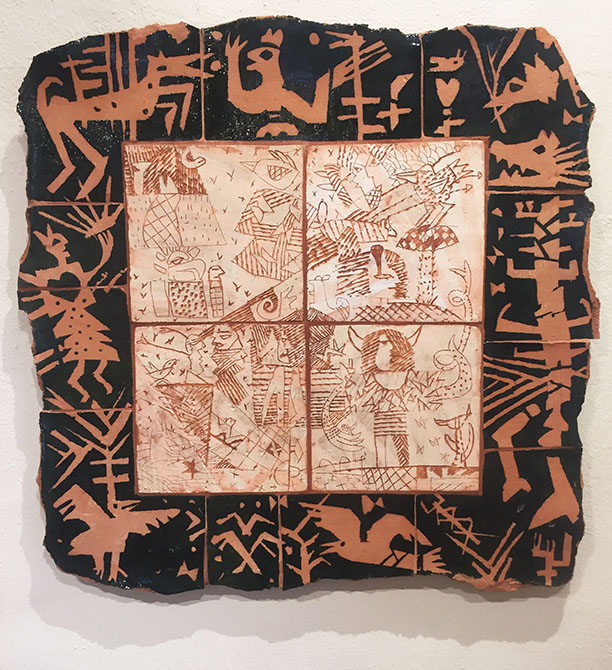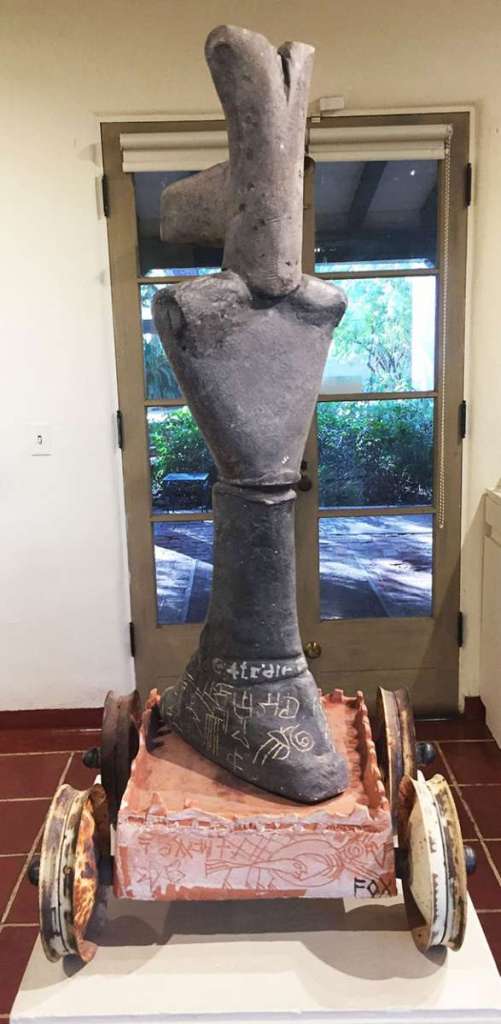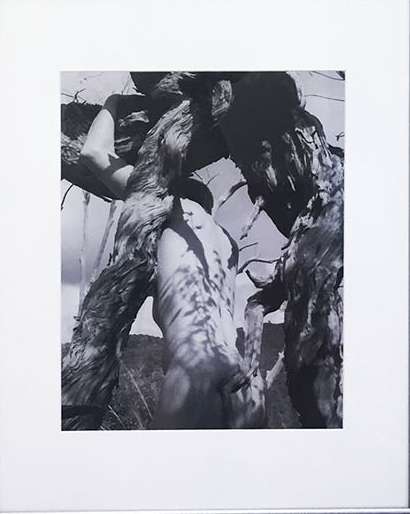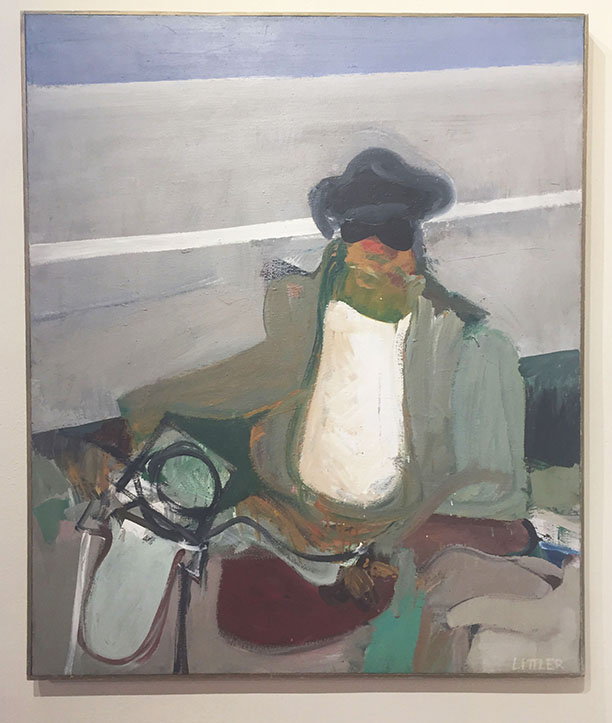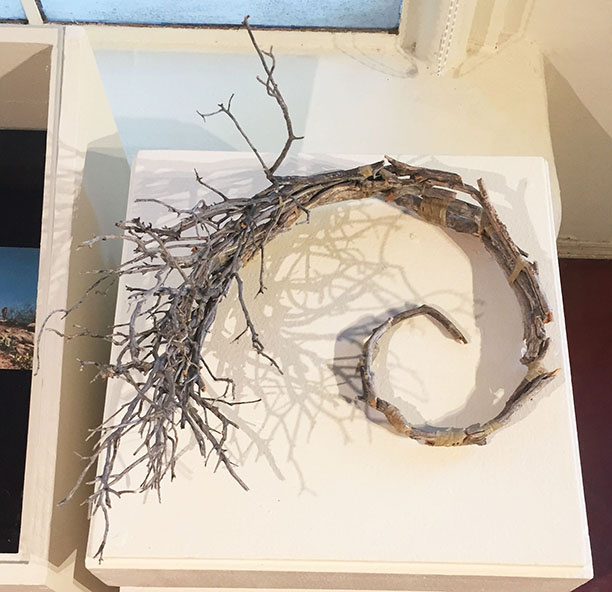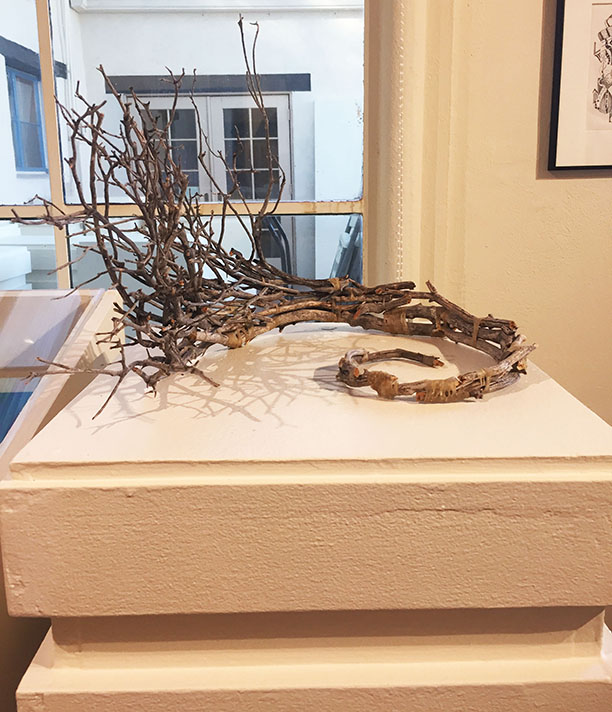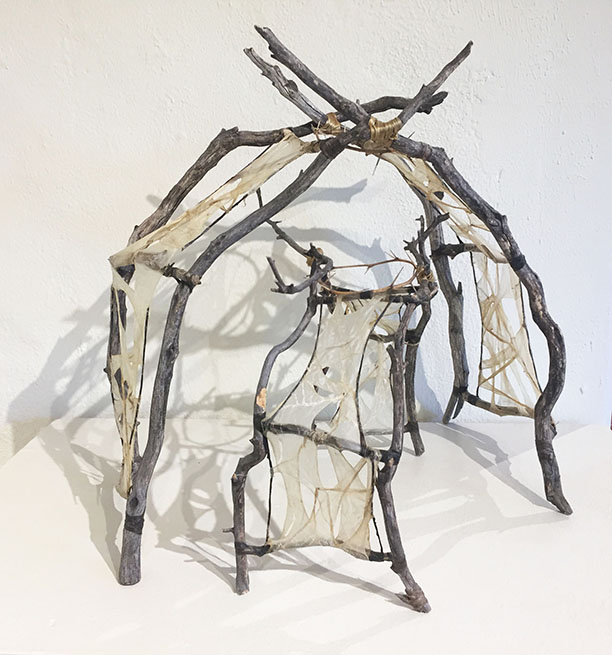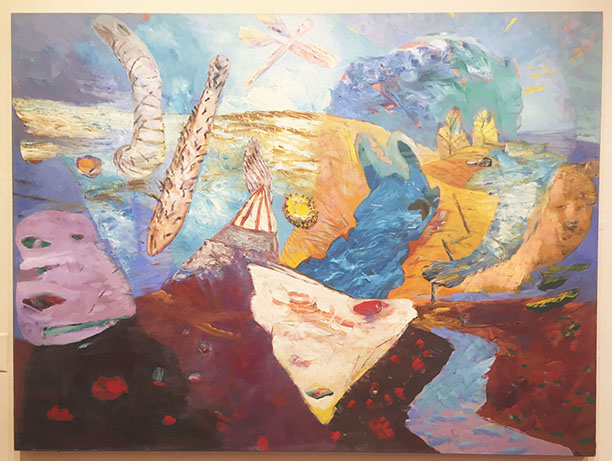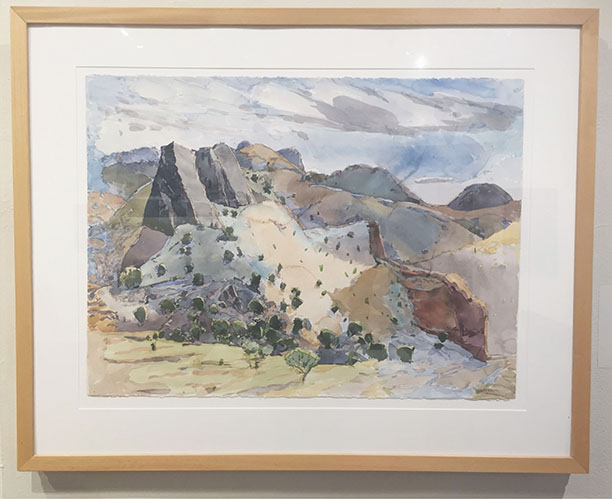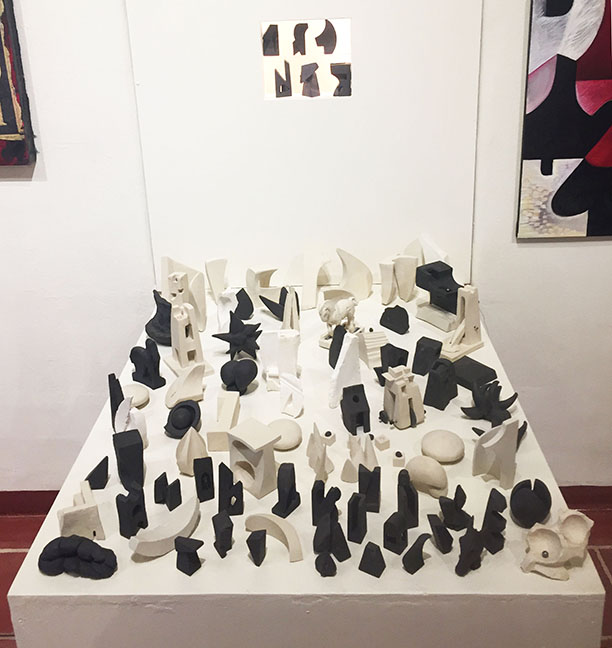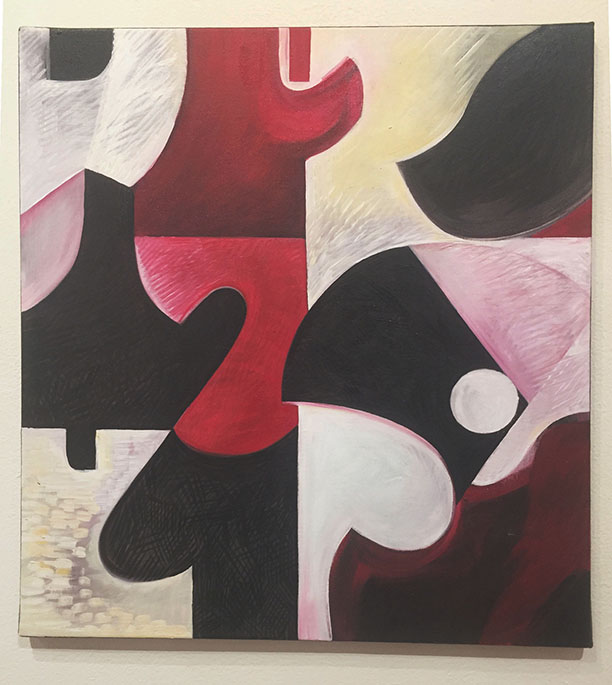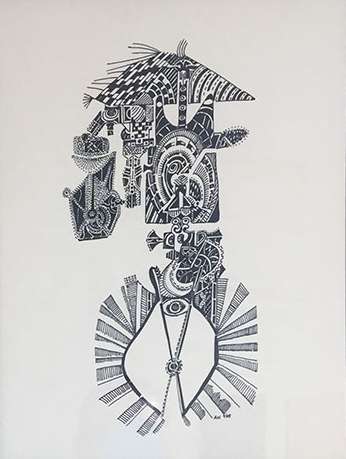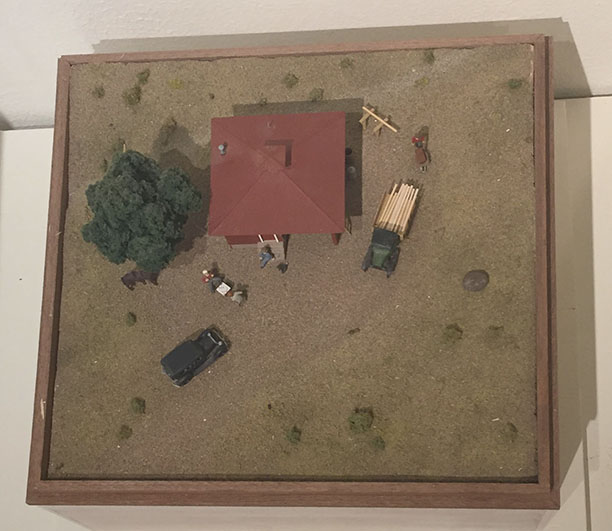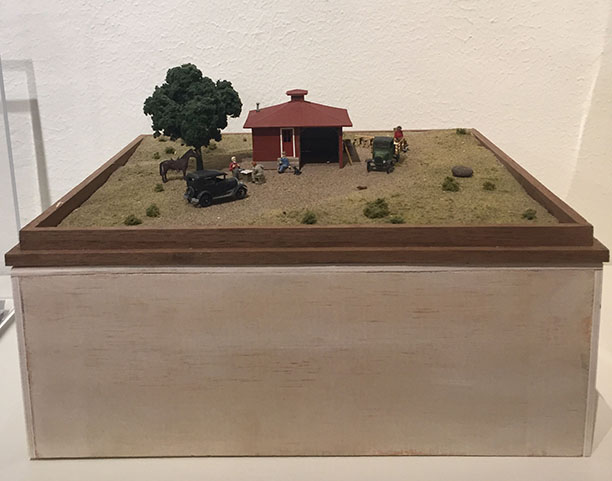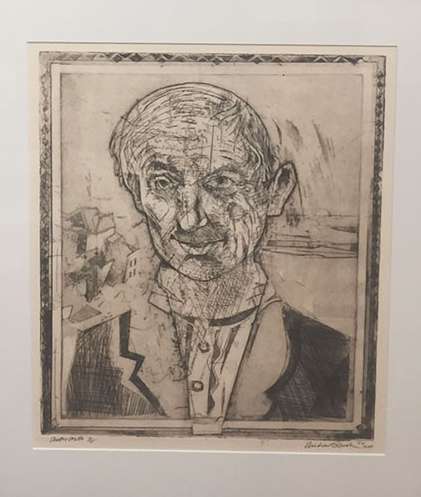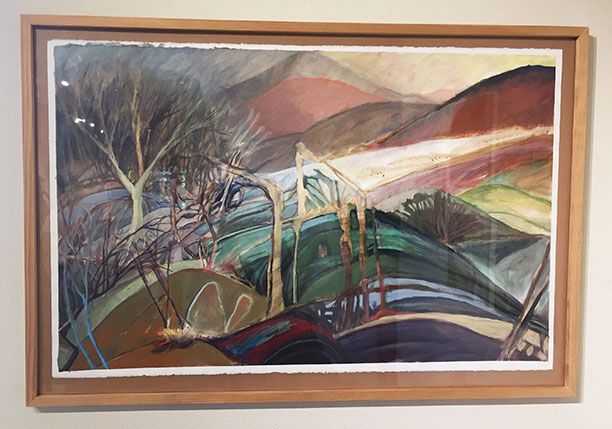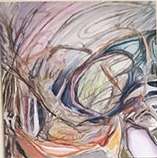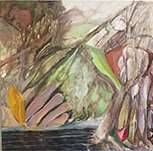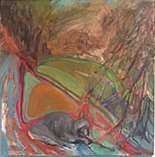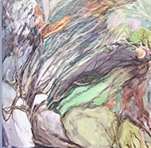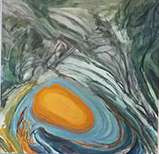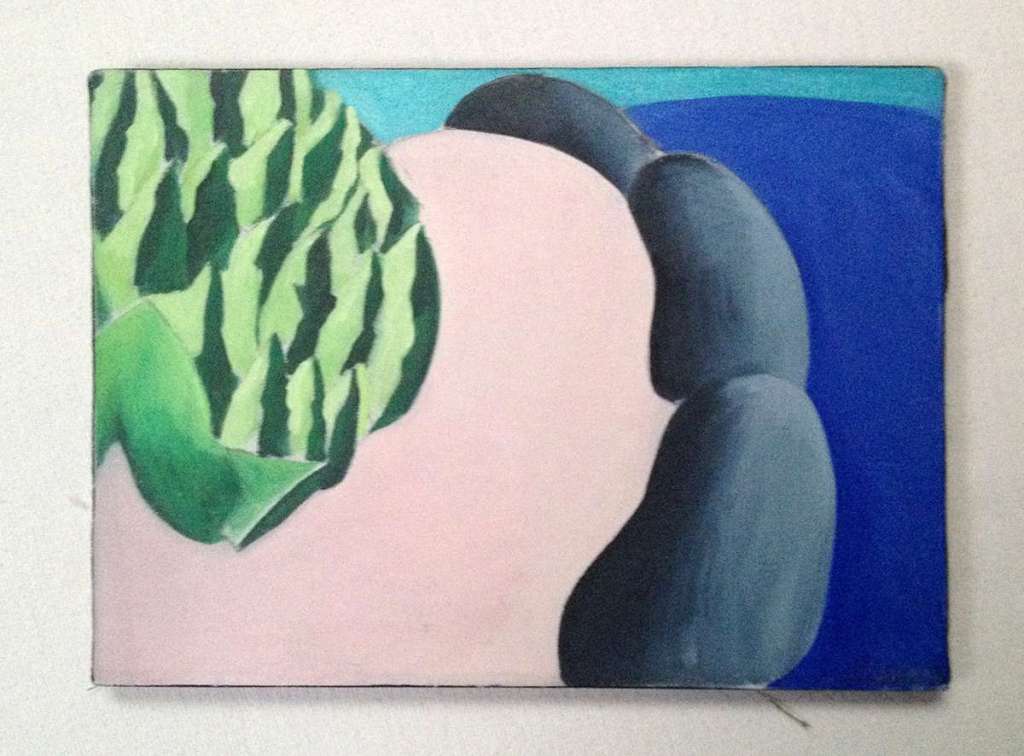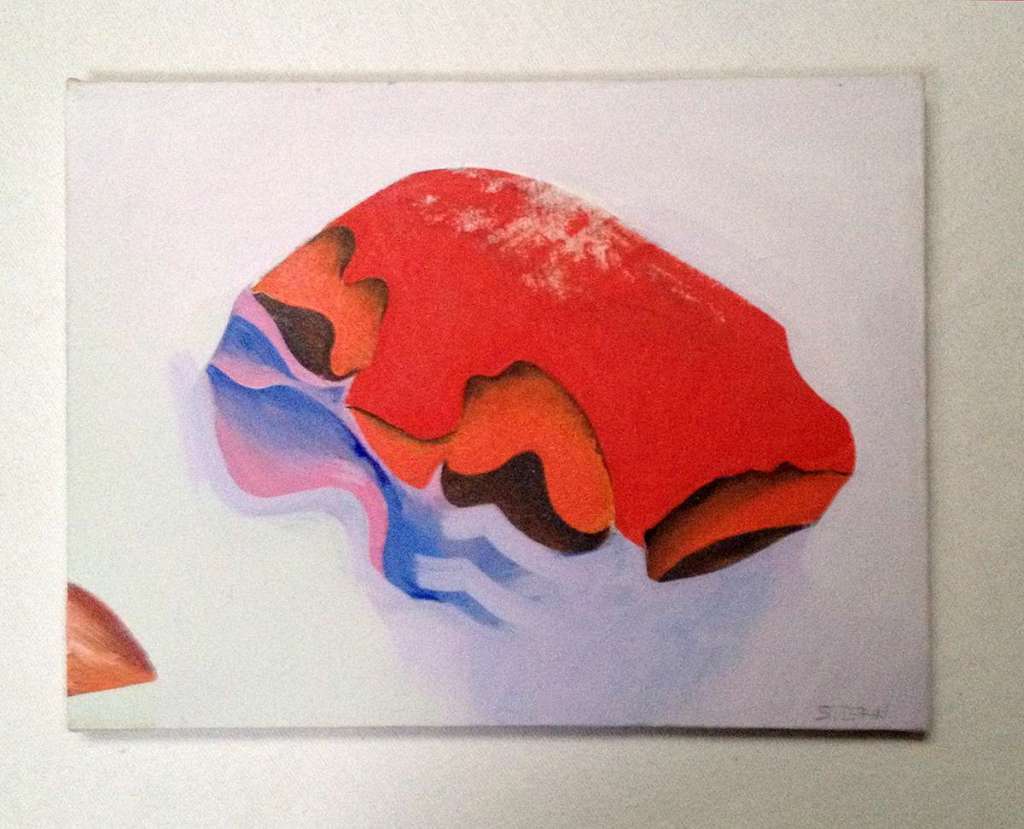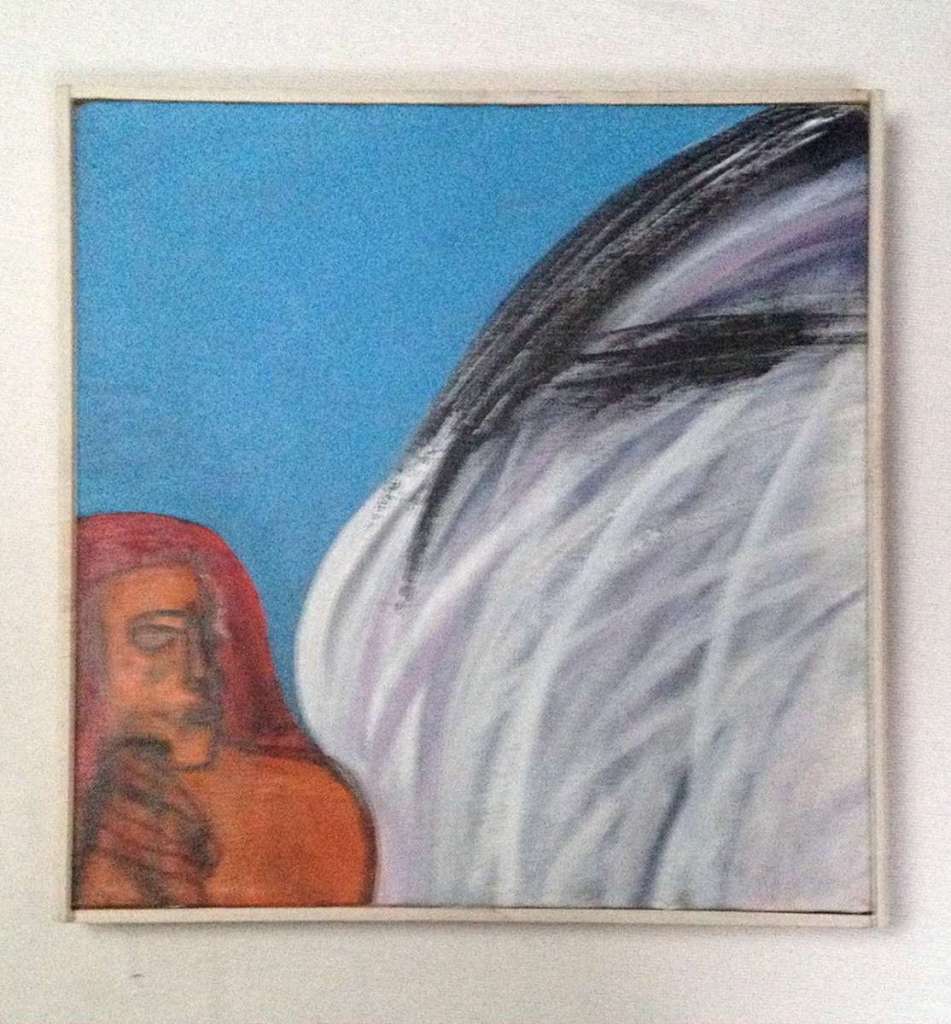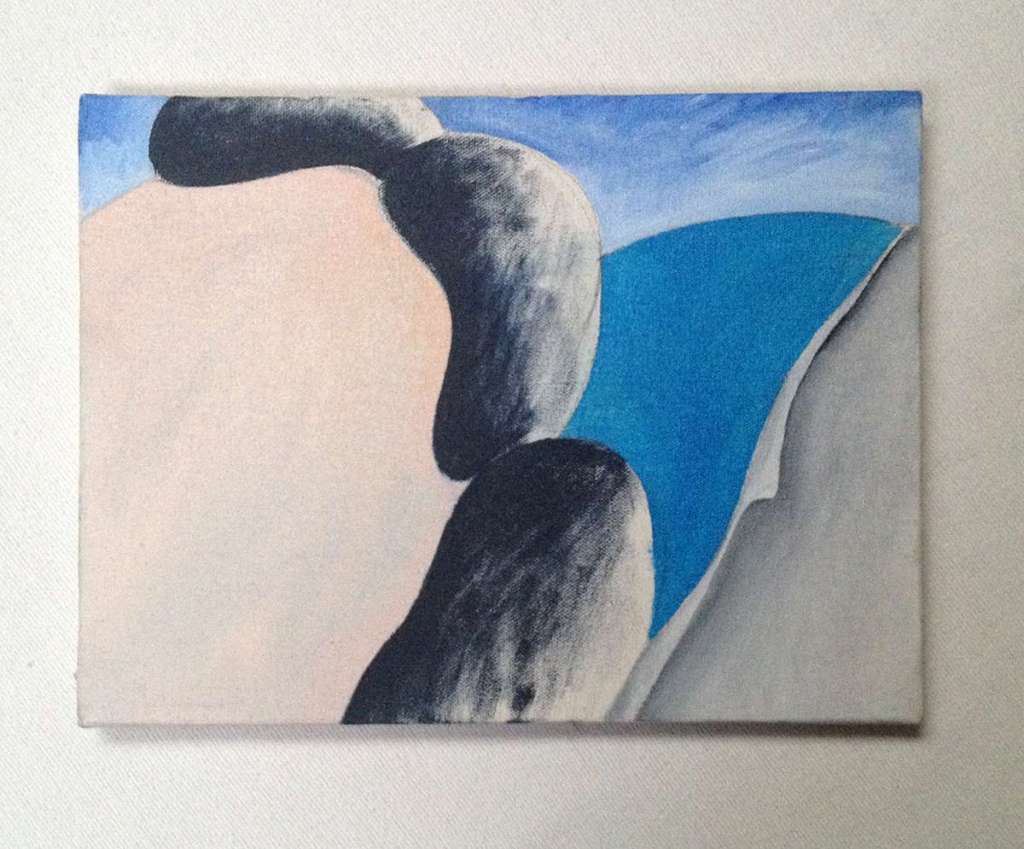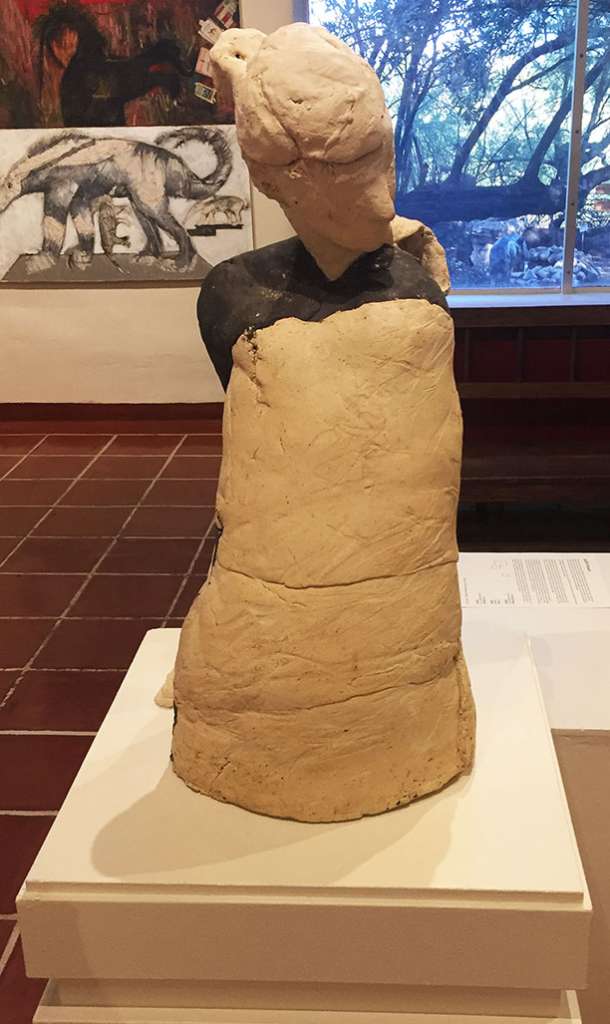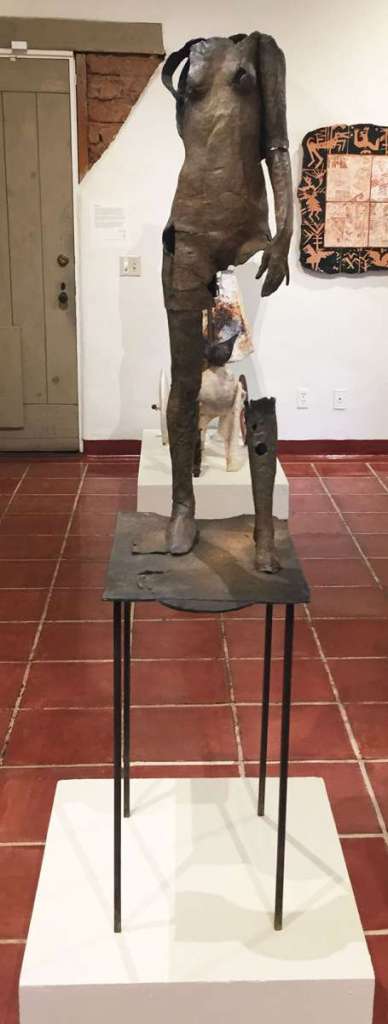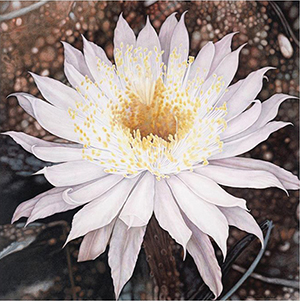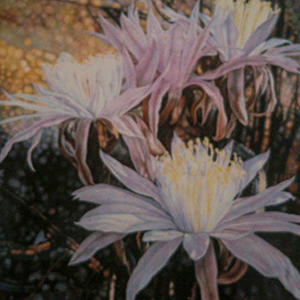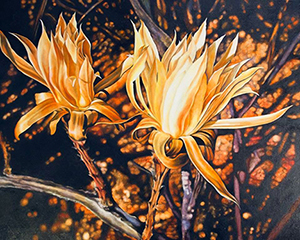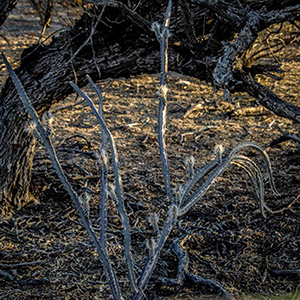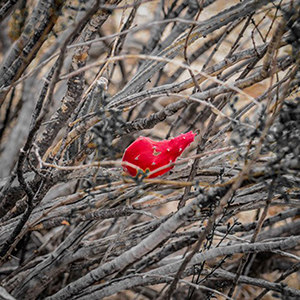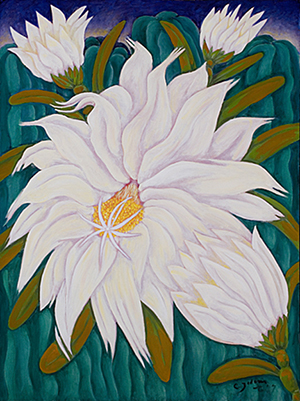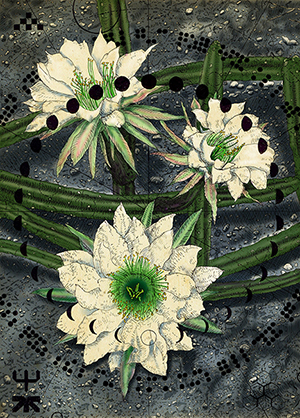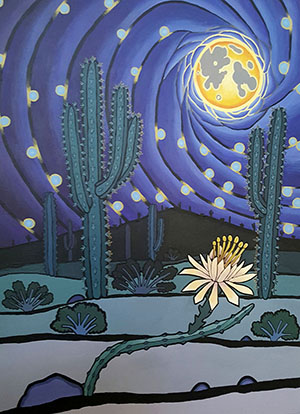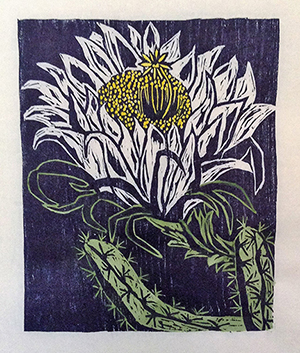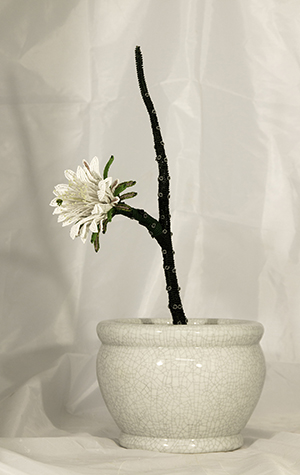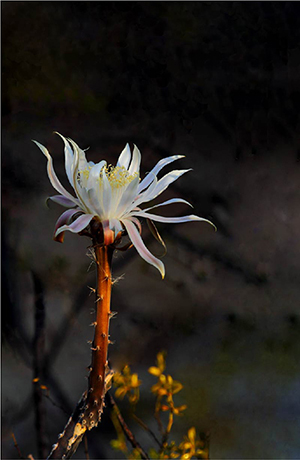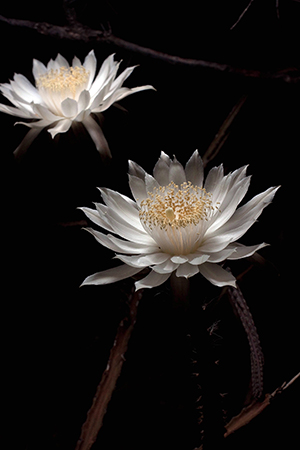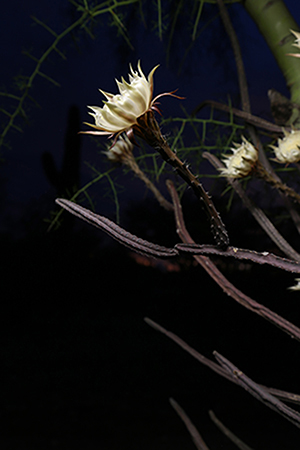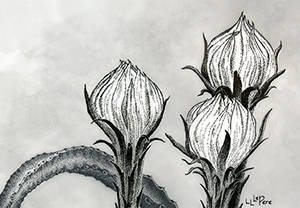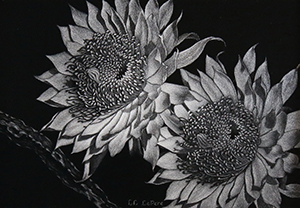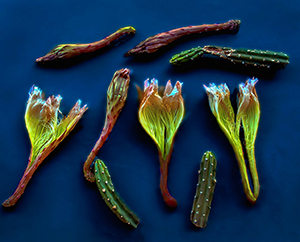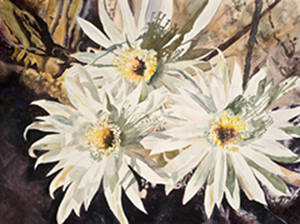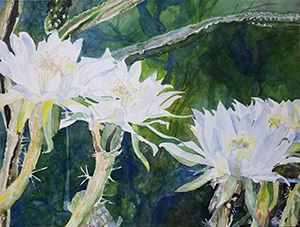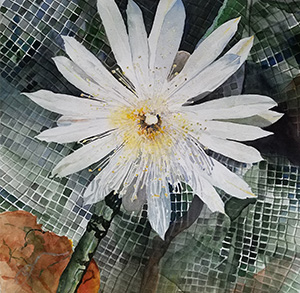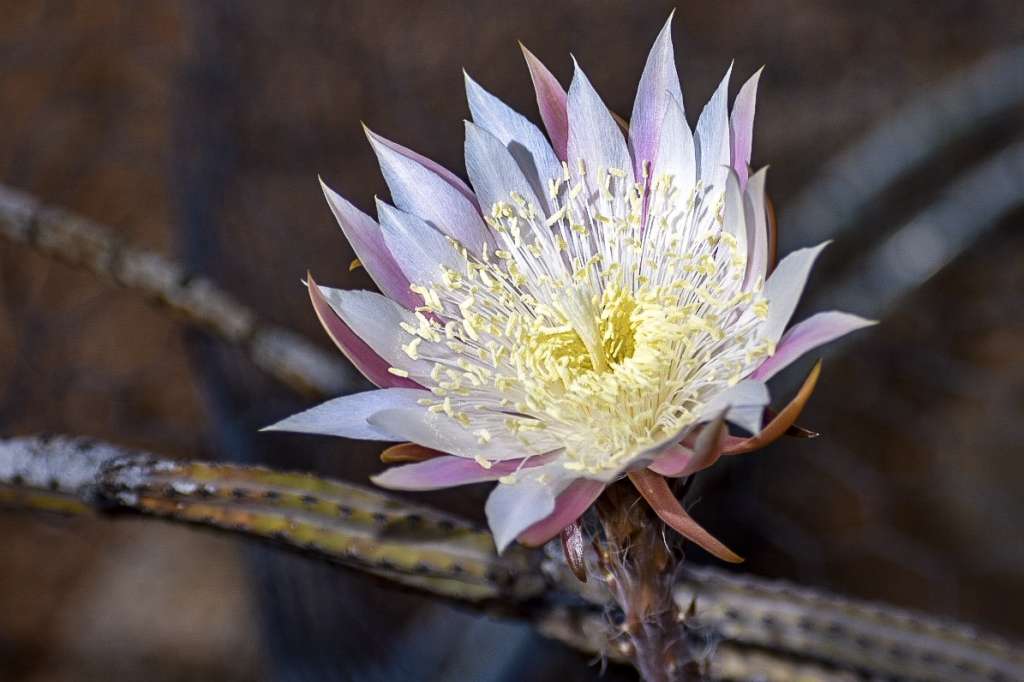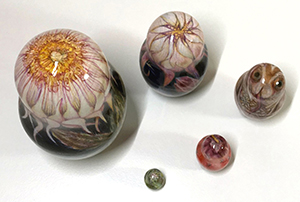The Exhibits Program at Tohono Chul presents visual stories linking the nature, culture and arts of the Southwest. Focusing on the work of regional artists, we display vibrant works of art in a diverse array of thematic group exhibits. The charming adobe Exhibit House, built as a private home in 1937, is an ideal environment for visitors to view Southwestern artworks. Explore our past exhibitions below.
THE ELEMENTS: FIRE
Main Gallery | August 25, 2022 – November 9, 2022
To view the exhibition, please click below:
[expand title=”See More” rel=”fiction”]
FIRE is the third exhibition in the series, The ELEMENTS. The series investigates how artists utilize the elements of earth, air, fire, and water as medium, process, and subject. And how, when seen as a subject, these elements reflect some of the social, economic, political, and environmental issues Arizona currently faces.
FIRE is here. EARTH and AIR have come and gone. WATER will follow.
The crux of each installment is to contemplate human presence and responsibility (or lack of); move toward, hover, and dig at the intersection of art and science, all the while remaining focused on medium, process, and subject; never losing sight of the beauty, wonder, and essence before you.
Approximately 70 pieces of art by over 50 artists including:
David Adix, Jo Andersen, Debbie Angel, Carolee Asia, Sue Bergman, Nicholas Bernard, Rebecca Bish, Barbara Jo, Brian Bystedt, Troy and Lauren Cammack, Veta Carney, Sasha Case, David Collis, James Cook, Vickie Donkersley, Karina Fassett, Patti Gardiner, Bonnie Gibson, Steve Grater, Lyn Hart, V. Highton, Tracy Ann Holmes, Bryan Hooker, Stu Jenks, Bettina, Margit Kagerer, Patricia Katchur, Albert Kogel, David Knorr, Kate Long Hodges, Ruthie Marchand, Anne Muñoz, Catherine Nash, Rachel Nelson, Katherine Nesci, Angela Puffer, Lyle Rayfield, Josh Schachter, Timothy Schirack, Carrie Seid, Monique van Gent Sidy, Ted Springer, Diane Taylor, Matthew Valiquette, Victoria Westover, Ira Wiesenfeld, Dennis Wunsch and Quilt for a Cause
Image | Anne Muñoz | Perfect Storm | quilted batik
[/expand]
ALL FIRED UP!
Welcome Gallery | August 25 – November 9, 2022
an invitational exhibition that surveys the work of Arizona ceramists: Nicholas Bernard (Scottsdale), Rebecca Bish (Tucson), Sandy Blain (Tempe), Chandra Hershey-Lear (Tucson), Matthew Valiquette (Tucson), and Nan Wollman (Tucson)
Gathering
Entry Gallery | August 5 – 23 October 2022
GATHERING features works on paper Michael Chiago created especially for Tohono Chul’s Saguaro Discovery Trail alongside baskets, folk art, and pottery from our Permanent Collection. The exhibition communicates togetherness and fosters community; while simultaneously recognizing the generous gifts that have enabled us to gather a cohesive collection of nature, art, and culture. A Permanent Collection to be shared by all.
Permanent Collection | New Perspectives VI
Welcome Gallery | June 10 – August 10, 2022
To view the exhibition, please click below:
[expand title=”See More” rel=”fiction”]
The sixth annual Permanent Collection: New Perspectives exhibition features objects from Tohono Chul’s Permanent Collection selected by Tohono Chul Volunteers, guest curators: Phyllis Cavender, Gigi Krammeyer, Len Poliandro, Sunny Stone and Sara Wetegrove.
The Permanent Collection started in 1986 with a donation of sixty-five objects from the Estate of Mrs. Robert Wilson. Mrs. Wilson was the mother of Tohono Chul founder, Richard Wilson. The desire to preserve and exhibit objects is deeply rooted in the Wilson family. Dick’s great, great, great-grandfather was Charles Willson Peale (1741-1827), a portraitist of the Federalist Era and founder of Philadelphia’s Peale Museum, one of America’s first major museums. Roughly a century and a half later, Harold S. Colton and Mary-Russell Ferrell Colton (Dick’s uncle and aunt) founded Flagstaff’s Museum of Northern Arizona. Today, Tohono Chul’s Permanent Collection has grown to include over 350 regional objects ranging from basketry, textiles, and ceramics to sculptural works and paintings.
All the guest curators have dedicated themselves to Tohono Chul and jumped at the opportunity to explore the Permanent Collection and share their knowledge and appreciation of the objects they have chosen.
Meet the Guest Curators, click below:
[expand title=”Meet the Guest Curators” rel=”fiction”]
Phyllis Cavender moved to Tucson in 2003 after retiring from teaching kindergarten and first grade in Weston, MA. She enjoyed the Boston culture and music, so was looking for a replacement when she moved to the Southwest. It was a very big change of scenery, but Phyllis was determined to investigate the desert surroundings and enchanting culture that was before her. For many years, she volunteered at the Welcome Desk and found it to be very enriching. Meeting people from many countries is a joy. Tohono Chul just speaks to you each time you visit and says, “come back”, and you do!
Gigi Krammeyer had lived on the East Coast all her life, she moved to Tucson four years ago to escape grass cutting and leaf raking. The saguaro was all that she knew, but fell in love with the beauty of the desert, its soft greens and greys, its wonders of adaptation to the dry and hot climate. She came to Tohono Chul to learn about arid plants and desert landscaping. Gigi had no idea that Tohono Chul had such a gem of an art gallery, now her favorite. And now, Sonora is my destiny.
Len Poliandro retired to Arizona from New York after spending 26 years building a successful textile design business. Along with being a Docent at Tohono Chul, Len has exhibited his glass and metal art in various exhibitions at Tohono Chul since 2015. He traces his transition from an entrepreneur to an artist to 1992 when he and his wife joined the Frank Lloyd Wright School of Architecture as Fellows for one year. In that fertile creative environment, he learned to use his hands to create objects as a form of communication, a way to articulate what he often finds difficult to express with words.
Sunny Stone returned to Tucson in 2004 having worked and lived in several different cities for 20 years. She was astonished at the growth of the city and of amount of desert lost to new housing developments and commercial buildings. Another surprise was to find the Haunted Book Store gone and the few trails she had once walked had become several trails. It would be several more years of working as a substitute teacher before she retired for the second time and decided to enroll in the docent program at Tohono Chul in 2011. She has been active in one capacity or another ever since and especially loves volunteering in the Exhibit House and the opportunity to learn more about the unique exhibits the curators bring into fruition.
Sara Wetegrove is originally from Corpus Christi, Texas and was a career stay at home mom and homemaker. She was raised with an appreciation for other cultures and how those cultures expressed themselves. Sara was also brought up in nature and was taught an unending love of flora and fauna. Being a Docent at Tohono Chul is the perfect place where she can return to what she loves. Volunteering in the Gardens and the Exhibit House affords me the opportunity to share my love and enthusiasm for art, culture, and nature with visitors from all walks of life and from all over the world. Tucson is a one-of-a-kind beauty and she cannot imagine living anywhere else.
To view our virtual exhibition, please click below:
[expand title=”View Exhibition” rel=”fiction”]
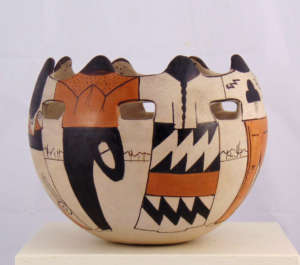
Friendship Pot
Angea Family
ceramic
Gift of Vicki and Neil Donkersley
2005.4.1
Selected by Phyllis Cavender
“The many men and women dancing figures looks like a celebration of unity. They represent strength, love of life and the togetherness we all wish for within a family circle. I love the circle! The people face each other and share the joy of singing. Take note of the clothing and details on each individual. One man has his food in the air; look carefully at the Tohono O’odham symbols at the bottom of the pot. This piece reminds me of an inclusive family hug that says, “Hold us together forever”.”
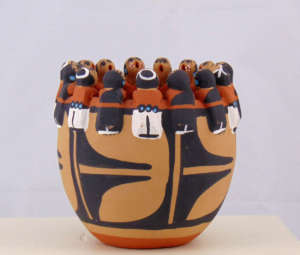
Pueblo Friendship Pot
Helen Sando-Garcia
ceramic
Gift of Harold Fischer
2005.8.4
Selected by Phyllis Cavender
“In my estimation, there is nothing better than an authentic storyteller. I believe the Pueblos passed the abilities of singing and chanting stories to their young charges. Native American children must love the storytellers because they bring exciting stories, messages of friendship and a new interest in their culture. I love the closeness of the circle and one feels the joy of singing stories. Young children love to imitate, they are practicing their future as storytellers on the turtle in the middle. The gentle turtle is a symbol of quiet nature to observe along with the faces of the beautiful young children.”
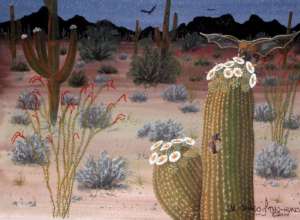
Desert at Night
Michael Chiago
watercolor on illustration board
Commissioned with funding from the Tucson/Pima Arts Council
2003.2.4
Selected by Gigi Kammayer
“I chose this watercolor by Michael Chiago because he captures, with such charm, the lives of the Tohono O’odham people and their intimate relationship with the Sonoran Desert. This beautiful watercolor depicts the desert at night, a special time for the pollination of the saguaro flower. The saguaros large white tubular flowers appear in May and early June. Nectar-feeding long-nosed bats time their annual migration from Mexico in order to pollinate these nocturnal flowers. The flowers attract them with their sturdy open petals and pumpkin-like odor. They are filled with abundant energy-rich nectar and protein-rich pollen. Birds and insects will visit any flowers left untouched by bats the following day. Pollinated flowers mature into oval green fruit which ripen into juicy red fruit. The pulp is very sweet and used for making wine.
Michael Chiago was born and lives on the Tohono O’odham reservation. In addition to being an illustrator, Tohono Chul was awarded a grant from the Pima County Arts Council to commission Chiago to create a narrative of the lifecycle of the saguaro connected with the Tohono O’odham. These works can be seen along the Saguaro Loop Trail.”
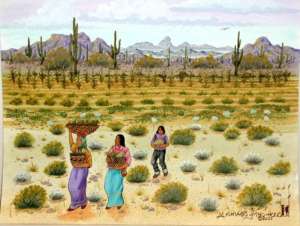
Vegetable Harvest
Michael Chiago
watercolor on illustration board
Commissioned with funding from the Tucson/Pima Arts Council
2003.2.9
Selected by Gigi Kammayer
“I chose this watercolor by Michael Chiago because of the way he captures the lives of the Tohono O’odham people and their relationship with the Sonoran Desert. This colorful watercolor depicts two women and a boy carrying home traditional baskets filled with vegetables and fruit from the fall harvest. These vegetables are planted in spring, taking advantage of the rains and their water-preserving irrigation system. The fruits of the saguaro provided them food until the crop was ready for harvesting. Back at their Ramada, they will prepare and preserve the vegetables and fruit for sustenance.”
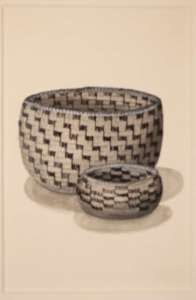
Traditional Woven Wine Baskets
Michael Chiago
ink on paper
Commissioned with funding from the Tucson/Pima Arts Council
2003.2.11
Selected by Gigi Kammayer
“This pen and ink drawing by Tohono O’odham artist, Michael Chiago, depicts the traditional Tohono O’odham baskets. They hold the wine made from the sweet red saguaro fruits harvested in May and June. The basket in Michael Chiago’s drawing is of traditional design while many present-day harvesters have forgone traditional baskets for modern plastic containers.”
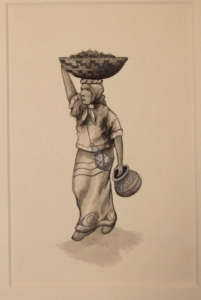
Tohono O’odham Woman
Michael Chiago
ink on paper
Commissioned with funding from the Tucson/Pima Arts Council
2003.2.12
Selected by Gigi Kammayer
“This pen and ink drawing by Tohono O’odham artist, Michael Chiago, depicts a Tohono O’odham woman in a native dress carrying a basket upon her head. Saguaro fruit, the most important ingredient in Tohono O’odham traditional wine, is a versatile and nutritious fruit. Tohono O’odham women have traditionally used the fruit for syrup and jam and its seeds can be ground to make flour. The first step to harvesting the sweet, red fruit is to knock it off the saguaro with a kui’pad, a long stick fashioned from saguaro ribs and topped with a crosspiece of creosote. They never knock down fruit by throwing rocks or hurting the cactus in any way.
Once enough fruit has been gathered, it is carried back to the family Ramada for preparation. The woman in Michael Chiago’s drawing has gathered saguaro fruit and is ready to prepare it. Though she carries the fruit in a coiled basket on her head, many present-day harvesters have forgone traditional baskets for modern plastic containers.”
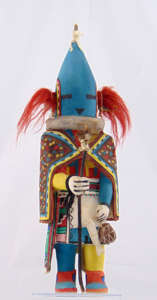
Aholi Kachina
Jimmy Kewanwytewa
painted and carved cottonwood with horsehair, fiber, cotton and string
Gift of the Estate of Mrs. Robert Wilson
86.2.16
Selected by Len Poliandro
“To me, the colors represent happiness. The craftsmanship of the wood, to make wood look like cloth, and paint it in such detail is masterful. The feeling I get from this piece is that Jimmy Kewanwytewa is projecting his own feelings through color and craftsmanship.”
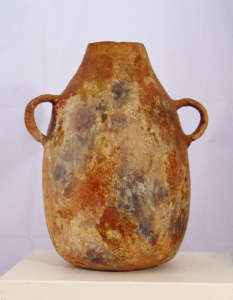
Two-Handled Jar
Unknown Navajo Artist
ceramic with pine pitch
Gift of the Estate of Mrs. Robert Wilson
86.2.59
Selected by Len Poliandro
“All the pieces that I selected, to me, show a connectedness between the people and the desert. Even though they are from different tribes, their craftsmanship exhibits the beauty and one with nature beyond what we can comprehend.”
We see function and beauty connected to the stars and mountains. The wear on this piece means that it has served its function for many years, producing the design of mountains and stars from where it was formed.”
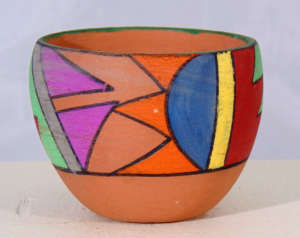
Poster Paint Pot
Unknown Jemez Artist
ceramic
Gift of the Estate of Agnes T. and Don L. Smith
98.1.93
Selected by Sunny Stone
“I chose the Jemez Pottery Bowl and the Zuni Fetish Bowl for their differences. While there was little information to go on, I hoped with research I could add to their history.
The first thing I learned about this little bowl is it was very common. Starting around the 1930s, two tribes, the Jemez and Tesuque, started making similar and inexpensive souvenir items to sell to tourists. They decorated these small pieces with poster paint before firing. Because of this, the paint and the pottery are very fragile. The paint is easily smudged and when exposed to water it can wipe completely away.
For hundreds of years, the Jemez were mostly farmers and created plainware for their use while a few produced a distinctive black on white pottery to trade with their neighbors to supplement the harvest of beans, corn, and squash. Then, during the mid-18th century, pottery making stopped all together and the Jemez traded with Zia Pueblo for most of their pottery needs.
Nevertheless, during the 1960s when interest in Native American Art rose significantly among collectors and tourists, the people of Jemez were stirred to make a higher quality pottery. Since the 1980s, Jemez potters have become very proficient and are now producing a wide variety of forms and types of fine pottery in red, black and tan tones. Traditional Jemez designs include plants, feathers and wildlife.”
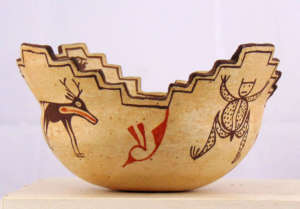
Zuni Fetish Bowl
Unknown Zuni Artist
ceramic with a white slip and black mineral and vegetal paints
Gift of the Estate of Agnes T. and Don L. Smith
98.1.55
Selected by Sunny Stone
“I chose the Zuni Fetish Bowl and the Jemez Poster Paint Pot for their contrast. The idea of how artists choose to bring their ideas into form fascinates me. The examples I have chosen have me thinking that, perhaps, they were made by young artists. I say this because of how simple the Zuni fetish bowl from our permanent collection is compared to other Zuni artists.
The tradition of Zuni pottery making is a rich one, having been practiced for more than a thousand years to produce both functional and ceremonial vessels. However, by the middle of the last century, this art form was dormant, having given way to jewelry making, the main support of the Zuni economy. Over the last fifty years, pottery has been revived and many tribal members are creating wonderful new works of art.
Although little is known about this bowl in the Permanent Collection, the design, with rounded bottom and four stepped sides is familiar to the Zuni. The symmetrical designs of tadpole, frog, bird, and deer with a heart line are used in their tradition. The medium is ceramic with white slip and black mineral/vegetal paints. The fetishes in this bowl are shown in pairs except for a single frog on the bottom.
The Zuni live in the Pueblo Zuni on the river Zuni, a tributary of the Little Colorado, about fifty miles south of Gallup, New Mexico.”
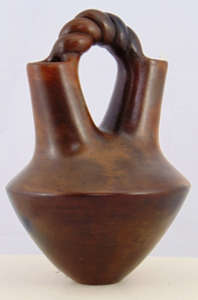
Navajo Wedding Vase
Alice Cling
ceramic
Gift of Richard and Jean Wilson
86.3.1
Selected by Sara Wetegrove
“I fell in love with this vase the minute I laid eyes on it. Something about the finish, the design, the handle, I could think of nothing better than to share it with our visitors.
The Diné (Navajo) artist, Alice Cling, is the creator of this double spout traditional Pitch Glaze vase (also referred to as a wedding vase). It is absolutely rich with design and finish with the twisted handle. Alice was born around 1946 in a Hogan in Cow Springs, Arizona, the Tonalea area of the Navajo Nation. She learned her craft from her mother, Rose Williams, and her aunt, Grace Barlow. They were responsible for revitalizing traditional Diné pottery. A coil potter, Alice was the first Navajo potter to use a smooth river stone to polish her pots rather than the traditional corncob. Her pottery is considered non-utilitarian, representing a huge shift from function to art.
In the family tradition, her daughters are also artists, as are her sisters, Sue Ann Williams, and Susie Williams Crank. Alice lives and works in the Shonto-Cow Springs area of Arizona.
Cling received the Arizona Indian Living Treasures Award in 2006 and has work in the Smithsonian Collection.”
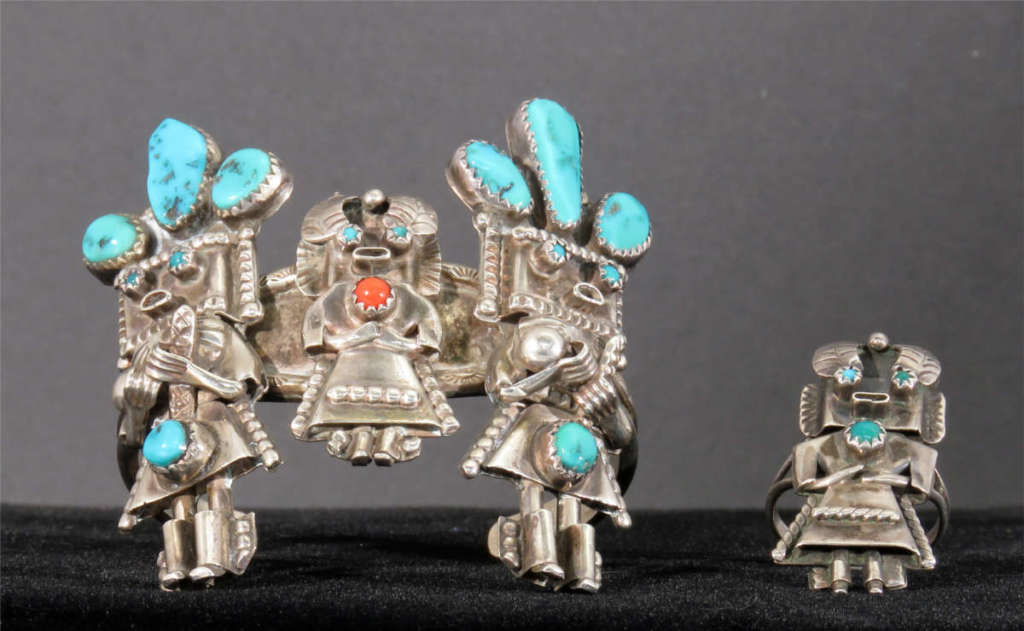
Katsina Design Jewelry Set
Doris Smallcanyon
silver, coral and turquoise bracelet
Gift of Suzy and Bill Mortimer in memory of Glenn and Louise Mortimer
2005.2.10a
Unknown Navajo Artist
silver and turquoise ring
Gift of Suzy and Bill Mortimer in memory of Glenn and Louise Mortimer
2005.2.10b
Selected by Sara Wetegrove
“I chose this beautiful Doris Smallcanyon Yei People bracelet and the ring with no hallmark to indicate its maker simply because I love them. Notice the detail and craftsmanship.
After a lengthy search, I found very little concerning Smallcanyon’s biography except that she was born some time in 1949 and she lives in New Mexico. Doris Smallcanyon is most known for her silver spiritual deity figures set with turquoise and coral: Yei to the Diné, Katsinam to Hopi and Ancient Puebloan Peoples. Many galleries and trading posts throughout Arizona and New Mexico offer her jewelry. She also makes squash blossom necklaces, rings, bolos, etc.”
[/expand]
The Elements – Air
Main Gallery | May 26 – August 10, 2022
To view the exhibition, please click below:
[expand title=”See More” rel=”fiction”]
AIR is the second exhibition in the series, The ELEMENTS. The series will investigate how artists utilize the elements of earth, fire, water, and air as medium, process, and subject. And how, as a subject, these elements reflect some of the social, economic, political, and environmental issues Arizona currently faces.
AIR is next. The exhibition EARTH came first, it featured the work of 41 Arizona artists. FIRE and WATER will follow. The sequence of the two remaining projects will be determined by the number and quality of the entries received.
The crux of each installment is to contemplate human presence and responsibility (or lack of); move toward, hover, and dig at the intersection of art and science, all the while remaining focused on medium, process, and subject; never losing sight of the beauty, wonder, and essence before you.
The Artists for AIR are:
David Adix, Michael Afsa, Carolee Asia, Kristie Atwood, Imo Baird, Bill Baker, Jan Bell, Alexandra Berger Clamons, Dennis Boyd, Katherine Burdick, Olivia Carey, David Christiana, Shari Coia, James Cook, Rick DeMont, Debra Goley, Liz Halsted, Dan Hansen, Lyn Hart, Tracy Ann Holmes, Brian Hooker, Kate Hoover, Erinn Kennedy, Irene Klar, William Lesch, Mark Mahaffey, Tom Martin, Paul Mirocha, Farraday Newsome, Len Poliandro, Jeff Reich, Kay Ross, Josh Schachter, Saralee Schneck, Dana Senge, C.J. Shane, Aimee Smythe, Lisa Swanson, Roger Ulrich, Paul Waid, Shelly White, Janet Windsor, and Nan Wollman
image . Brian Hooker . Drifting in Blue . archival pigment print
[/expand]
Queen of the Night
June 3 -July 31, 2022
To view the exhibition, please click below:
[expand title=”See More” rel=”fiction”]
She is called the Queen of the Night, La Reina de La Noche, or the Night Blooming Cereus and every summer, for one night only, whatever she may be called, Peniocereus greggii becomes the Belle of the Ball, the superstar of the Sonoran Desert. The Cinderella-like cactus looks like a dead stick for most of the year but transforms herself in the early summer months, blooming alongside many plants in the area and then closes forever by morning’s light.
Tohono Chul possesses 400 Peniocereus greggii, the largest private collection in the world. Many of these curious cacti were found growing in the park with others being donated over the years, some being saved from the bulldozer’s blade. The number of flowers blooming in one night has been as many as 174 on 69 plants. As beautiful and enchanting as the blooms of the Night Blooming Cereus are, what happens in the dry desert dirt and in the nighttime sky is as fascinating as the wondrous white blooms. Maintaining and sustaining the plant below ground is a turnip-like tuberous root and up in the sky, the tireless pollination of the Hawk Moth. The whole cycle is a marvelous story of courage, endurance, perseverance.
30 years ago, in June of 1992, Tohono Chul held its inaugural Bloom Night. Docent, Betty Carras provided a vivid recollection of the night: “Watching carefully, we could actually see the opening spurts of the blossoms. Slowly, but inexorably, the bud became a flower. Ghostly white, it gradually opened its funnel-shaped blossom—becoming more aromatic as it increased in size. By the time its slender white petals were almost fully opened and the flower nearly five inches across, it was extremely fragrant. The velvet-like embrace of warm night air, the magic of a sweet-scented evening and the distant chorus of singing coyotes made it truly a night to remember.” It was a casual affair outside the shop with a little over 20 people bearing witness. One plant produced six flowers while another plant produced one. From that evening a Tucson tradition was born. Since that first string of phone calls by a dedicated few, word has spread and now with each Bloom Night, over a thousand visitors experience something absolutely mysterious and incredibly magical.
[/expand]
Tom Baumgartner | Codex Sonora
February 11 – extended through June 5, 2022
To view the exhibition, please click below:
[expand title=”See More” rel=”fiction”]
Deserts harbor mysteries, from lost civilizations to rarely seen creatures. They invite reverence, awe, and not a little fear. They spawn legends of ghosts, jackalopes, lost treasures. And, of course, they are places where occupants of extraplanetary spacecraft are locked away in caves inside mountains and government laboratories, carefully hidden from view at sites such as Area 51 and Roswell.
Imagine that the pilot of one of those crafts set it down in the middle of the Sonoran Desert, an alien in an alien landscape. Imagine further that our pilot—who is also artist and shaman—retreated to a quiet corner of an abandoned adobe out somewhere in the rocks and sand and, amazed, combined the most modern of graphic technologies with a found crow quill pen and India ink to record observations of the lifeforms and landscapes he (or she, or it) encountered along the way.
Codex Sonora is that record. It’s fittingly mysterious, made of extraordinary portraits accompanied by eldritch, nearly indecipherable text, along with elusive graphs and symbols and strange diagrams that point outward to the stars. Timeless and enchanting, it’s the Sonoran Desert’s answer to the Voynich manuscript and the Codex Seraphinianus, both eccentric and enchanting.
Tom has painted in oil and drawn with ink for 30 years with a BFA from the School of the Art Institute of Chicago. He has lived in Tucson for 20 years and is actively involved with local arts organizations and founder of Wee Gallery. A life-long nature lover, his art focuses on the desert landscape, automatic writing, and aesthetics of science. Tom is currently Creative Director for AlphaGraphics in Tucson.
[/expand]
10 x 10 | A Fundraiser
March 4 – May 29, 2022
To view the exhibition, please click below:
[expand title=”See More” rel=”fiction”]
10 x 10 is an invitational exhibition with the many artists who make Tohono Chul‘s galleries such a unique experience. 10 x 10 features a wide range of sculpture and paintings, prints, photographs, and mixed-media works no larger than 10 inches in any dimension. Each artwork is priced at $100 and can be taken home immediately upon purchase. With over 400 pieces by 68 artists, artwork on display will change periodically over the course of the exhibition, with new works constantly being revealed. The curators will be available Monday – Friday to show additional works that are waiting in the wings.
cropped image left to right | Shelley Rothgeb | Ralph Prata | Lex Gjurasic
Warm thanks to the following artists:
David Adix, Jo Andersen, Cheri Anderson, Tom Baumgartner, Sandy Blain, Barbara Jo, Brian Bystedt, Veta Carney, Nancy Charak, Morgiana Correa, Diana Creighton, Vanessa Dearing, Judy Derickson, Linda Ekstrum, Jeffrey Falk, Jo Falls, Karen G. Fisher, Linda Friedman, Susie Gillatt, Lex Gjurasic, Annie Gordon, David Griffin, Lyn Hart, Cat Hill, Tracy Ann Holmes, Brian Hooker, Kate Hoover, Wendy Islas, Jerry Jacobson, Stu Jenks, Margit Kagerer, Lauri Kaye, Erinn Kennedy, Albert Kogel, William Lesch, Susan Libby, Kate Long Hodges, Annie Lopez, Rae Mahaffey, Michael Mason, Jan Mayer, Matt Mays, Lydia Miszuk, Katherine Monaghan, Anne Muñoz, Mary Nation, Mary Ellen Palmeri, Curt Pradelt, Ralph Prata, Lyle Rayfield, Shelley Rothgeb, Dee Ruff, Tamara Scott-Anderson, C.J. Shane, Aimee Smythe, Christy Lou Sturman, Holly Swangstu, Matthew Valiquette, Virginia Vovchuk, Paul Waid, Helen Walthier, Beata Wehr, Robin Westenhiser, Bobbie Wilson, David Windsor, Janet Windsor, Jim Waid and Karen Wright
[/expand]
Roy J. Kurtz Collection of American Indian Art
February 11 – May 16, 2022
To view the exhibition, please click below:
[expand title=”See More” rel=”fiction”]
Tohono Chul’s Permanent Collection is growing with the acquisition of Roy J. Kurtz Collection of American Indian Art. The Roy J. Kurtz Collection is vast and will provide endless possibilities for Tohono Chul’s Education and Exhibits programs for years to come. This exhibition will provide the first look at this large collection of baskets and American Indian artwork.
“Tohono Chul is a place to be proud of,” Roy said, “I sincerely believe The Collection will reach its true potential at Tohono Chul.” Roy’s gift has filled our hearts with amazement and delight, and we are overjoyed and humbled to carry on his life’s passion and legacy.
[/expand]
Rick DeMont | Elemental Monuments
January 10 – February 27, 2022
To view the exhibition, please click below:
[expand title=”See More” rel=”fiction”]
Rick DeMont’s large-scale watercolors demonstrate his mastery of color, scale, and space. Each composition’s strength is generated by active weavings of saturated hues and joined shapes that conjure shards of intricately patterned mosaic up close and desert vistas from several feet away. Each large sheet of paper, drenched in a tapestry of deep, rich color, with its myriad marks, dots, and strokes is simultaneously a reflection of the pure landscape as DeMont had witnessed and an abstract entrance toward the wonders of the natural world.
Rick DeMont | Pima Canyon from Tohono Chul | watercolor on paper
[/expand]
The Elements – Earth
November 19, 2021 – February 2, 2022
To view the exhibition, please click below:
[expand title=”See More” rel=”fiction”]
EARTH is the first exhibition in the series, The ELEMENTS. The series will investigate how artists utilize the elements of fire, air, water, and earth as medium, process, and subject. And how, as a subject, these elements reflect some of the social, economic, political, and environmental issues Arizona currently faces.
The exhibitions of FIRE, WATER, and AIR will follow. The sequence of the three projects will be determined by the number and quality of the entries received.
The crux of each installment is to contemplate human presence and responsibility (or lack of); move toward, hover, and dig at the intersection of art and science, all the while remaining focused on medium, process, and subject; never losing sight of the beauty, wonder, and essence before you.
The Elements – Earth features 85 works from 41 Arizona artists including:
David Adix, Timothy Arand-McIlrath, Helen Baribeau, Susanna Battin, Tom Baumgartner, Jan Bell, Cathi Borthwick and Sharon Richards, Sasha Case, Nancy Charak, David Christiana, Hanna Coy, Diana Creighton, Patrick Doss, Olivier Dubois-Cherrier, Karen Fisher, Jill Friedberg, David Griffin, Lyn Hart, Tracy Holmes, Brian Hooker, Kate Hoover, Margit Kagerer, David Knorr, William Lesch, Kate Long-Hodges, Susan Lyman, Jan Mayer, Anne Muñoz, Danielle Neibling, Len Poliandro, Curt Pradelt, Shelley Rothgeb, Lyle Rayfield, Dee Ruff, Dana Senge, Matthew Valiquette, Virginia Vovchuk, Paul Waid, Shelly White, and Janet Windsor
Images (detail) | clockwise from upper left | Curt Pradelt, Susan Lyman, Tom Baumgartner, and Cathi Borthwick and Sharon Richards
[/expand]
RALPH PRATA | Whatever it Takes
NNovember 19, 2021 – February 2, 2022
To view the exhibition, please click below:
[expand title=”See More” rel=”fiction”]
“After many years creating concrete sculptures, the 2020 – 2021 pandemic gave me the opportunity and time to experiment with found, recycled and reclaimed materials. Incorporating these found objects and materials with my concrete carvings, gave the sculptures a completely new life and presence.
Most materials were found during the pandemic, in washes, riverbeds, on roadways and hiking trails in the Tucson desert. All pieces were spontaneously created and hand executed. Concrete, wire, screws, nails and epoxy were used in the construction of each piece.
In the stillness of creating, using this discarded material, I try to bring something into existence that will enhance the lives and spirit of all who encounter my work…including myself.”
[/expand]
HOLLY SWANGSTU | Forgotten Soil
November 19, 2021 – January 2, 2022
To view the exhibition, please click below:
[expand title=”See More” rel=”fiction”]
The Entry Gallery Project Space series offers Arizona artists an intimate space for cohesive projects. Tucson artist, Holly Swangstu, employs thin strips of colorful hand-dyed cotton fabric in moody vertical and horizontal compositions that evoke the desert’s light, sky, and landscape.
“I am a landscape painter.
Though fabric is my primary medium, I have always been reluctant to call myself a “fiber artist.” When I work, I consider myself to be drawing and painting. I find joy in exploring line, color, mood, and expression, only I am using torn strips of hand-dyed fabric in lieu of traditional paint or pencil. Like many artistic approaches that utilize alternative media, my painting style is inextricably linked to a specific and rigorous process. The first step in that process is dying the fabric, which I liken to an oil painter grinding her own pigments from raw minerals, then adding the pigment to a binding agent to create the paint.
It is a slow and technical process that ultimately yields the raw materials from which my paintings can then be constructed. Creating the material to paint with is very much its own experience, and often quite apart from the creative act of developing an actual composition. I learned how to sew as a very young child. I spent college years and beyond making my own textiles, using both computerized and handlooms, I am very comfortable with slow and accretive work methods.
Though my art has departed from traditional weaving techniques, it still shares that decidedly tactile, very gradual, layering approach. Much like the frames of the looms I used to rely on, I stretch my strips of fabric across wooden armatures, carefully overlapping each one and allowing for frayed edges to add organic and textural interest. I often refer to the majority of my work as colorscapes; though evocative of the source of inspiration, most typically the sweeping landscapes of the Southwestern United States and Coastal Mexico, they are rarely directly referential to a specific location. My colorscapes are approached with the same attitude that someone else might write in a journal, documenting impressions and memories with an eye towards a personal, underlying narrative.
My goal, however, is never to focus specifically on journalistic detail, but rather to capture the feeling and emotional impact of nature, interpreting it into a largely abstract context.”
Image | Holly Swangstu | Secret Garden | hand dyed cotton on panel
[/expand]
Diane Ganski and Melody Prentice | Dreams of the Dead
September 9 – November 8, 2021
To view the exhibition, please click below:
[expand title=”See More” rel=”fiction”]
Dreams of the Dead spotlights the fun-loving, playful, and funky work of Tucson artists Diane Ganski and Melody Prentice in a special exhibition of jewelry, sculpture and paintings. Having been a big part of the Chiles, Chocolate, and Day of the Dead Festival the last several years we are excited to welcome their Day of the Dead inspired creations to the Exhibit House.
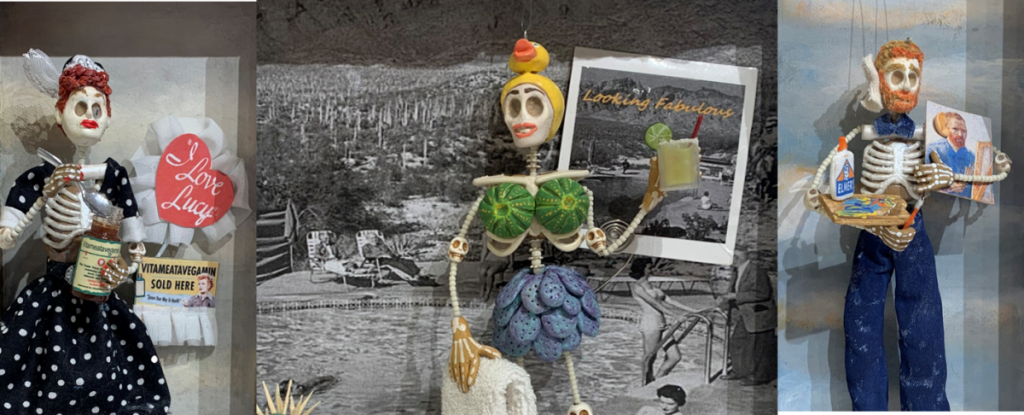
Image Left | Diane Ganski | I Love Lucy Vitameatavegamin | mixed media Image Center | Melody Prentice | Day of the Dead Bathing Beauty with Cactus Bathing Suit at Hacienda Del Sol | mixed media Image Right | Diane Ganski | When Van Gogh Pulls Your Chain | mixed media
[/expand]
Día de los Muertos
September 9 – November 8, 2021
To view the exhibition, please click below:
[expand title=”See More” rel=”fiction”]
The celebration of El Día de los Muertos is a joyful occasion of remembrance, involving feasts and festivities through which death is recognized as a part of the natural process of living. Contemporary celebrations of this holiday bear both ancient traditions and a modern flair and have become a rich part of Tucson’s cultural heritage. This exhibition celebrates the creative ways artists honor and enliven this deeply meaningful holiday through artistic expressions of personal and universal significance.
Arizona artist Manuel Fontes will be joining Tohono Chul’s curatorial team as co-curator for our 2021 Día de los Muertos exhibition. Manuel Fontes studied fine art photography at Phoenix College and earned his B.A. and M.A. in Ecological Anthropology from Arizona State University. He grew up in Southern Arizona celebrating the traditional Mexican Holiday, Día de los Muertos, with his family every year. The Sonoran Desert has always been his home. As an Environmental Scientist, the natural sequence of the Sonoran Desert fascinates him. As an artist, he has been exhibited his work in eleven exhibitions at Tohono Chul since 2015. He tries to capture the lives of rural people and their connection to the land. His work primarily focuses on the lifeways and folklore of the Hispanic Southwest.
Día De Los Muertos features 107 works from 42 Arizona artists including:
Cheri Anderson, Carolee Asia, Jan Bell, Heather Bentz, Alexandra Berger Clamons, Barbara Jo Borch, Jacqueline R. Bradley, Heather Buton, Melani Camacho, Veta Carney, Morgiana Correa, Vanessa Dearing, Linda Ekstrum, Jennifer Eschedor, Jeffrey Falk, Manuel Fontes, Diane Ganski, Susie Gillatt, Annie Gordon, Barbara Hall, Catherine Hanson, Cat Hill, Wendy Islas, Jerry Jacobson, Kathleen Koopman, Chuck LaVoie, Annie Lopez, Gloria Martinez and Pat Manion, Lydia Miszuk, George Penaloza ,Astrid Randall, Claire Roth, Timothy Schirack Patricia Silva, Rachel Slick, Aimee Smythe, Bonita Sur, Lisa Swanson, Megan Welker, Robin Westenhiser and Bobbie Wilson
Images | Megan Welker, Chuck LaVoie, and Cat Hill
[/expand]
Visionary Revisions
August 12, 2021 – November 7, 2021
To view the exhibition, please click below:
[expand title=”See More” rel=”fiction”]
Intuition is defined as “the ability to understand something immediately, without the need for conscious reasoning.” Intuition is innate to the artist, from the self-taught to the master, it comes from the gut. The resourcefulness it breeds is responsible for the discovery of unique materials, the development of unique processes, and the creation of unique works.
VISIONARY REVISIONS focuses on several artists that trust the “spark of intuition,” it celebrates unusual approaches employed by artists that borrow from visionary, outsider, and folk art traditions and whose work elevates reclaimed, repurposed, and recycled materials to the level of the precious.
Please contact the Exhibits Department, if you have any questions or would like to purchase artwork: exhibits@tohonochul.org
Artists:
Mary Bohan, January 19, 1926 – July 26, 2013
Mary was an accomplished writer, painter, and clay artist. She exhibited her paintings in shows throughout New England and participated in Clay and Art Studies in New York City, Woodstock, and Tucson. She was an active member of the Southern Arizona Clay Artists and the Arizona Designer Craftsmen and was an artist-friend of Tohono Chul showing her work in 13 exhibitions from 1989 – 2010. Mary enjoyed traveling across the United States and into Canada and Mexico and across the ocean to Europe. She was an avid photographer, capturing the people and places she visited. Ceramic pieces donated from the Bohan estate.
Royce Davenport
‘ART saves lives.’ That is a saying that has been around for a while. For myself it has always rung true as it has done that very thing in my life on a number of occasions. It has, it seems, forever been the very best tool in my kit. Over time, I have come to realize the power that lies within it. Artistic expression possesses an ability to transcend words and leave us speechless in its contemplation. It moves us closer to a level of communication that somehow remains veiled in our material existence. I can talk to you, you can talk to me, and that lends great value in the passing of our days. Still, when we can meet on some common ground of understanding via a shared visual exchange we have done so from the very center of our being. ART saves lives, because ART is a ‘Weapon of Mass LIBERATION.’
Royce has been actively practicing the ART of Mass LIBERATION since the 3rd grade at P. S. 33. Royce served as an illustrator in the U. S. Navy, ART director for the Tucson Weekly for ten years, and has actively worked at a number of community ART projects based in Tucson as well as in Vail, Arizona where he makes his home. The artwork on display comes from the shop at Rancho Milagrito where Royce has been a creator and purveyor of “high folk art” for over 30 years.
Patrick Hynes
Patrick Hynes received his BFA in painting and printmaking from the University of Arizona School of Art in 1971 after studying with Bruce McGrew, among others. From 1971 to 1972, he studied with Black Mountain college artist and teacher Hazel Larsen Archer at Avalaon College, Tucson, Arizona.
Hynes was the owner and galley director of The Forum Art Gallery in Tucson, 1973-74, where he exhibited Tucson artists in group and solo shows. Throughout the 1980s and 1990s, Hynes worked as a designer and general contractor. His artwork reflects the surrounding desert he lives in, the themes of mythology, nature, and the human form. Patrick currently resides in Tucson, where he draws, paints, and sculpts using a variety of materials.
Ed Larson
Ed Larson has been painting, sculpting, and carving for decades. He is also well known for his Wind Toys and Story Quilts. His Studio, located near Museum Hill in Santa Fe, NM, is a true artist’s workshop. Inside and outside you will see a great variety of Ed’s work ranging from lyrical folk art paintings and wood constructions to paintings of the American West. You will also be treated to Expressionist paintings that reveal something of the inner workings of Wonderful Ed.
Ralph Prata
Creativity has been the inherent drive within me. For over 35 years, I have been creating sculptural concrete carvings. After receiving a degree in applied sciences and arts with an emphasis on commercial art, I began focusing my creative energies on sculpture. Searching for a versatile permanent material to work with, led me to concrete. Formulating my own concrete blocks to carve, these blocks are directly hand carved using traditional sculpting tools. Each work is created spontaneously through an improvisational process and are inspired by music. Since 2014, I have incorporated found, recycled and reclaimed materials into my artwork. The creative approach is the same as my concrete carvings, but the process of combining and adding things together verses carving and subtracting has brought a new element and dimension to my work. The images are dreamlike perceptions of some universal quality of the past, present and future. In the stillness of creating, I try to bring something into existence that will enhance the lives of all who encounter my artwork, including myself
[/expand]
Encompassing Arizona
October 21, 2020 – August 30, 2021
To view the exhibition, please click below:
[expand title=”See More” rel=”fiction”]
Since 1985, Tohono Chul’s Exhibits Program has consistently worked with more Arizona artists than any other organization in the state. Encompassing Arizona is a rotating, revolving, and evolving invitational exhibition that presents a wide variety of artworks and a broad range of disciplines that process from a diverse roster of Arizona artists. Featuring established and emerging artists from across the state, the Main Gallery will be an active space with new work will be installed with great frequency.
[/expand]
Queen of the Night
June 18 – July 25 | 2021
To view the exhibition, please click below:
[expand title=”See More” rel=”fiction”]
She is called the Queen of the Night, La Reina de La Noche, or the Night Blooming Cereus and every summer, for one night only, whatever she may be called, Peniocereus greggii becomes the Belle of the Ball, the superstar of the Sonoran Desert. The Cinderella-like cactus looks like a dead stick for most of the year but transforms herself in the early summer months, blooming alongside many plants in the area and then closes forever by morning’s light.
Tohono Chul possesses 400 Peniocereus greggii, the largest private collection in the world. Many of these curious cacti were found growing in the park with others being donated over the years, some being saved from the bulldozer’s blade. The number of flowers blooming in one night has been as many as 174 on 69. As beautiful and enchanting as the blooms of the Night Blooming Cereus are, what happens in the dry desert dirt and in the nighttime sky is as fascinating as the wondrous white blooms. Maintaining and sustaining the plant below ground is a turnip-like tuberous root and up in the sky, the tireless pollination of the Hawk Moth. The whole cycle is a marvelous story of courage, endurance, perseverance.
Read More
29 years ago, in June of 1992 Tohono Chul held its inaugural Bloom Night. Docent, Betty Carras provided a vivid recollection of the night: “Watching carefully, we could actually see the opening spurts of the blossoms. Slowly, but inexorably, the bud became a flower. Ghostly white, it gradually opened its funnel-shaped blossom—becoming more aromatic as it increased in size. By the time its slender white petals were almost fully opened and the flower nearly five inches across, it was extremely fragrant. The velvet-like embrace of warm night air, the magic of a sweet-scented evening and the distant chorus of singing coyotes made it truly a night to remember.” It was a casual affair outside the shop with a little over 20 people bearing witness. One plant produced six flowers while another plant produced one. From that evening a Tucson tradition was born. Since that first string of phone calls by a dedicated few, word has spread and now with each Bloom Night, over a thousand visitors experience something absolutely mysterious and incredibly magical.
50% of all sales from Queen Of The Night help fund programs at Tohono Chul
Artists
Tom Baumgartner
Cereus Lunix
offset print
framed – 20.75″ h x 14.5″ w
Tom has painted in oil and drawn with ink for 30yrs with a BFA from the School of the Art, Institute of Chicago. He has lived in Tucson for 20 years and is actively involved with local arts organizations, and founder of Wee Gallery. A life-long nature lover, his art focuses on the desert landscape, automatic writing, and aesthetics of science. Tom is currently Creative Director for AlphaGraphics in Tucson.
More
“Flowering plants have symbiotic relationships with pollinators, but I was thinking about the cereus and its relationship with night. The timing of cycles, quiet glowing shadows and moon light being the first light to illuminate the tissue paper thin petals. Overlaid in the background is a dotted diagram of moon craters.”
Ron Cornett
Queen of the Night
acrylic on canvas
40″ h x 30″ w
Ron Cornett has been a resident of Tucson for the last 45 years. He has always had a love of art and trained under photo-realist artist Larry Gerber for three years. Ron then worked in illustration and graphic design for several years until he went back to school to pursue another career in radiology. He also had a foray into the world of comic books and self-published four comic books and had a booth at the San Diego Comic convention for a
More
couple of years.
“I am inspired by the complexity and the beauty of the Sonoran Desert, its flora, fauna, denizens and cultures. The series this piece is from is a study in color and line work. I wanted to take my line work skill from the comic book world and superimpose that against the beautiful colors of the desert at night.”
Darlene Buhrow
Cereusly Sensual
inkjet archival, mesquite frame
Tucson artist, Darlene Buhrow is a collector of sorts. To create her assemblages that transcend into visual stories – she is always camera-ready. She captures doorways, windows, patterns, icons, flora and fauna, which she then catalogs for later use. As she shuffles through her archives, she often finds all the
More
elements that create the next shrine, reliquary or talisman.
She is most interested in how those layers: the delicate weathering of a piece of wallpaper, the gold leaf on a frame/mirror or the age or the color of a piece of paper might influence the interpretation of her work – work that is often a brief moment in time, a vignette in the middle of a much longer narrative.
Erinn Kennedy
Erinn Kennedy paints the sights and scenes of the Sonoran Desert, Erinn is drawn to the unique quality of light found in the Desert Southwest, and how it illuminates the landscape’s natural beauty as well as the man-made structures found in its environment. Erinn use sketches made from direct observation and memory as well as her emotional reactions to a particular place or object. Her aim is to arrive at a finished piece that is balanced, loose and joyful. Utilizing vibrant colors, bold shapes and a sense of play, Erinn creates vistas real and imagined that reflect her love for her desert home.
Paul Hannan
Pavane for the Queen
photographic prints
Ugly sticks. Grey twisted, scabrous, spiny, twigs emerging from an engorged, deformed lump like tuber. To a cactus geek, it is a thing of beauty.
More
Peniocereus greggii var. transmontanus. The Sonoran Queen of the Night. Its beauty is in the flower to most people, but to some, that humble stick or tangle of tortured limbs hiding discretely against the cholla skeletons and dried ambrosias is the treasure, the site for the Queen’s crown. Maybe that is why the plant is so compelling.
This humble, gnarly little cactus produces the bloom that perfumes the desert.
Karen Kubara
A task unending
always the same
no other to it
again, again,
again fill the jug
the desert is dry
bring water to the root
arms know the job
legs know
nothing more to know
body – spirit – mind
one with the doing.
The flow –
flowing through the doing
flowing through the water
flowing through the root
again fill the jug,
no talk
not thinking
sun, walk
water the root
fill the jug, again –
the zen
of attending
night blooming cereus.
Karen Kubara’s first volunteer job at Tohono Chul in 1996 was to water the Night Blooming Cereus, a group of about thirty plants located in the main garden. When Terry McMahon, another Tohono Chul volunteer, arrived the following year, they expanded regular watering to the collection out along the North and South trails. While Terry was planting more Night Blooming Cereus, Karen switched to studying the plants.
More
Ann Nyhan, one of Tohono Chul’s longest serving volunteers and benefactor of the new propagation greenhouse, and Karen were tasked with observing, monitoring and measuring each Night Blooming Cereus bud grow to see if we could learn anything about its bloom cycle. Buds typically begin to form by mid-April, but the date those buds blossom can vary from late May to the middle of July. What triggers them to begin that final, inevitable burst to bloom remains a mystery, but they did identify the predictable signs and measurements that signal blooming will occur in 5-6 days. Karen’s drawing is based on field sketches and notes she made during that study from 2000-2005.
Joan McGann
Queen of the Night and the Sphinx Moth
colored pencil and varnish on wood
put together – 7″ h x 4″ w
Since moving to the Sonoran Desert thirty-eight years ago, Joan McGann’s amazement with desert flora has continued to grow. These glorious plants are true survivors and have adaptations for their climate that intrigued her to draw them. She hopes in some small way her representations of some of these species will help others appreciate and protect our beautiful desert plants.
More
“I received a blank wooden matryoshka from a friend traveling in Russia and thought that the forms leant themselves to the shape of many cactus species. I have completed several groups of these nesting dolls since then. Colored pencil adheres well to the surface of the linden wood, and I finish them with UV archival varnish. While the Peniocereus greggii species is not barrel shaped, I used that form to create the bloom and fruit. I have also included the Sphinx moth because it is an important pollinator for this night blooming cereus.”
Todd Ros
Cereus Cactus Flower
oil on canvas
24″ h x 24″ w
Todd Ros’ paintings can be described as reductive geometric abstracts. Whether working with a wide-ranging color palette or creating variations on a single color, his works of oil on canvas are often rigorously investigated studies on a specific theme. Past series include Film Stills, Fighter Aircrafts and Birds of Arizona. Recently moving from a hardedge approach to a looser and more
More
layered structure, he continues his commitment to abstraction, distilling the desert world that surrounds him into vertical bands of color.
Robin Westenhiser
Moon Bloom
acrylic on birch panel
20″ h x 20″ w
Robin Westenhiser works from her home in Tucson, Arizona with a beautiful view of the Santa Catalina Mountains. She is a collector of things and finds inspiration in her colorful southwestern surroundings, the love of her Sonoran Desert, the mountains that surround the city and our big blue sky. Robin’s close proximity to the border has developed a deep love of Mexico, the colors, the
More
foods, the traditions and the people. She loves to paint in bright colors that make her happy and feel alive! Her paintings make her smile and she hopes they make others smile too!
Karen Wright
Whether photographing in distant lands or in the desert around her, Karen loves to focus on the small details: a single light highlighting an elusive bloom, the contrast of colors in nature or the simple beauty of a small boy’s smile.
From the Tohono Chul Permanent Collection
Kathie Schroeder
Queen of the Night
beads and wire with ceramic pot and sand
gift of Frances Mueller in Memory of Ann Walker Schroeder
2001.1.1
In Kathie Schroeder’s search for a way to hold forever some of the wondrous things this life presents to our visual sense, beadwork has become vehicle, destination and the ride itself. Beads are little bearers of color, light and tactile pleasure. Singly, they offer her their plump, little figures, their individual
More
complexion and veritably, taunt her to weave and work them into some composite creation. Kathie has fallen under this beady spell and is totally enchanted by what she can do with these glorious little phenoms.
Annie Antone
Queen of the Night
white and green yucca with dark and light devil’s claw
gift of Peggy and Michael Hazard
2007.6.1
Annie Antone was born in 1955 in Tucson, Arizona. She is a Native American Tohono O’odham basket weaver from Gila Bend, Arizona and was the first basket maker to sign her work; she weaves a tiny “AA” into the base of her baskets. The Antone family are famous for their work.
[/expand]
PaperWorks: Forming the Effect, Affecting the Form
February – June 13 | 2021
To view the exhibition, please click below:
[expand title=”See More” rel=”fiction”]
PaperWorks: Forming the Effect, Affecting the Form features work by PaperWorks members: Vanessa Dearing, Helen Baribeau, Lyn Hart, Carol Morgan, Bobbie Wilson, C.J. Shane, Judy Derickson, and Jo Anderson. PaperWorks: Forming the Effect, Affecting the Form finds them responding to 2020 being the Sonoran Desert’s driest year on record with each artist reflecting on the affecting effects of drought and deluge.
“Nothing stays the same once the rains arrive. Forms shift and mutate all around us. From the parched browns of our driest season we are transformed into a lush green flower filled landscape. Desert dwellers respond similarly to our rains, as the food source rebounds and many use this time for searching out mates. It is a lively time of change in the Sonoran Desert.”
PaperWorks the Sonoran Collective for Paper and Book Artists provides educational and creative opportunities for all who love and work with and on paper. With over 200 members, the group is an all-volunteer organization that promotes the appreciation and enjoyment of the paper and book arts through ongoing meetings, workshops, and special events.
To learn more about PaperWorks go to: paperworks.info
Artists
Jo Anderson
Jo Anderson is a Tucson artist whose current work involves combining various printmaking and alternative photography methods to create unique or limited edition Artists’ Books.
Helen Baribeau
Helen Baribeau’s interest in art books began when she took a bookmaking class with Judith Golden in the mid-1990’s. Both her interest in glass blowing and Art books led to her back to the U of A, finishing her BFA degree in printmaking. Over the years, she has loved working in ceramics, oils and collage.
Vanessa Dearing
Vanessa Dearing is a Tucson native who started her art journey in watercolor and has since been exploring collage, assemblage, and making original and limited-edition handmade books.
Judy Derickson
Judy Derickson is the former Art and Art History Instructor at St Gregory College Prep School and is an exhibiting mixed media artist in Tucson.
Lyn Hart
Lyn Hart is constantly inspired by the sere, sensual and stimulating place that she calls home. Her work explores the many layers of meaning inherent within a sense of place. This is where she belongs.
Carol Morgan
Carol Morgan has been working as a handmade paper artist since 1998. Making paper from cotton, abaca, hemp or kozo is an ancient craft. She enjoys the labor-intensive process from beating the fibers to creating the art. Sculpting paper into 3-dimensional forms is challenging as well as gratifying.
C.J. Shane
C.J. Shane is a visual artist and writer who lives and works in Tucson, Arizona. Her primary interest is in painting, artist’s books, relief printmaking and handmade paper. The natural world, especially the beautiful Sonoran Desert, continues to be the greatest source of grounding and inspiration in her life and work. She pushes her landscape paintings to the point of abstraction in order to convey the mysterious energy of the desert.
Bobbie Wilson
Bobbie Wilson credits the creative energy of PaperWorks for allowing her to bloom as an artist. Her eyes are open to the infinite possibilities of paper, and repurposing paper into something whimsical and fun. She enjoys the tactile and visual aspects of this simple medium, yet the results are so varied and infinite.
[/expand]
Idea and Execution
November 6 – January 10 | 2020 – 2021
To view the exhibition, please click below:
[expand title=”See More” rel=”fiction”]
Idea and Execution honors seven Arizona artists that have contributed mightily to projects at Tohono Chul over the past six years and who are also part of this year’s Arizona Biennial 2020 exhibition at the Tucson Museum of Art. Their individualized approaches to making art blend equal parts idea and execution; honed over the years through a process of thinking and making, thinking and making, thinking and making – the resulting works are ever-changing, fearless, and flawless.
Artists
David Adix
“The most consistent element throughout my work is the salvation and reuse of materials. I regard the components I use as fossil-like evidence of what humans leave behind. The earth’s attempt to reclaim what has been drawn out of itself can been seen in various degrees in each piece. Each has a story and a history unique unto itself. I choose the materials I use because I enjoy the challenge of creating beauty out of what has been discarded. I see these components very organically. To me they are beautiful vestiges of time.”
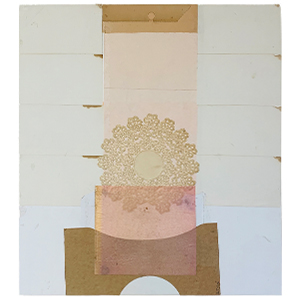
Altar
vintage papers on mat board
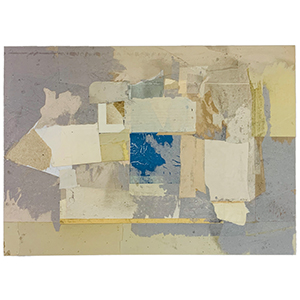
Blue Square
vintage papers on mat board
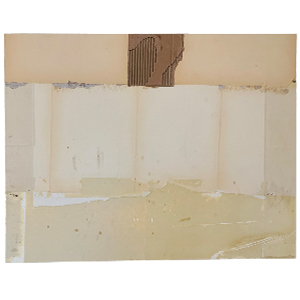
Flap
vintage papers on mat board
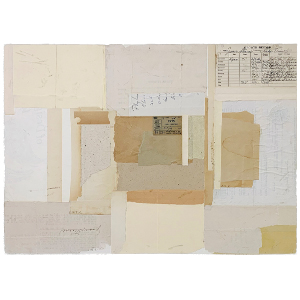
Growth Record
vintage papers on mat board
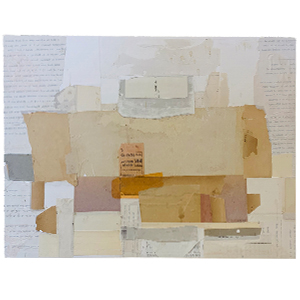
Orange Ticket
vintage papers on mat board
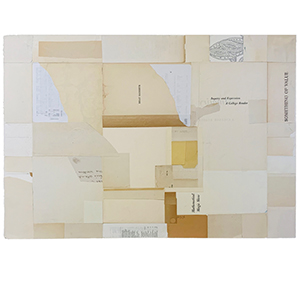
Something of Value
vintage papers on mat board
Barbara Brandel
“I am a painter and a collage and assemblage artist. Previously, I was a fiber artist for 25 years. In each phase of my artworks, I have developed my own ways of working with my materials, and I strive to push boundaries within each genre, while creating beauty.
I am currently working on a series of surreal paintings that are delightful, challenging and mysterious to me. I call the series Fever Dreams. I plan to continue this series for quite some time. Past paintings pay homage to the anonymous artisans whose skill and care created beautiful objects to use in their lives. Many of those objects are now museum treasures.”
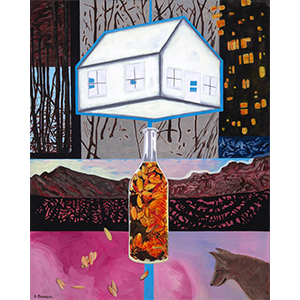
Alignment
acrylic on canvas
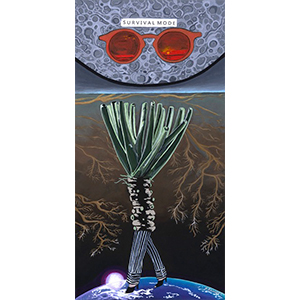
Survival Mode
acrylic and collage on canvas
Kate Breakey
“These two juxtaposed photographs are of recent astronomical events: the total solar eclipse on August 21, 2017, and the total lunar eclipse on January 31, 2018. Because the sun and moon significantly affect all life on earth, these are perhaps the most dramatic events we will ever witness. There is a coincidence about the relationship of the sun and moon. The moon appears to be the same size as the sun because although the sun is 400 times wider than the moon, it is 400 times farther away. The moon was once closer to us and is moving away. We happen to live in a period in earth’s history to experience this beautiful coincidence.
The other beautiful coincidence is my friendship with a poet, Stacey Forbes, who writes about these two events and is my collaborator.”
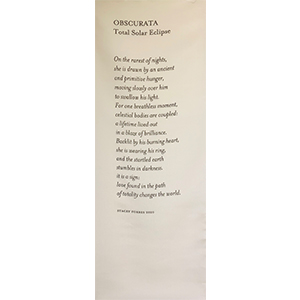
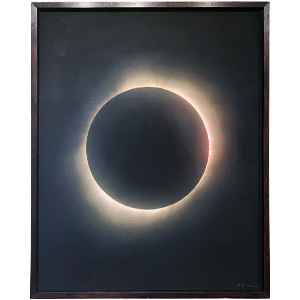
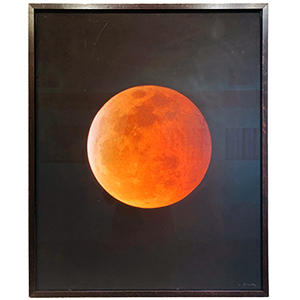
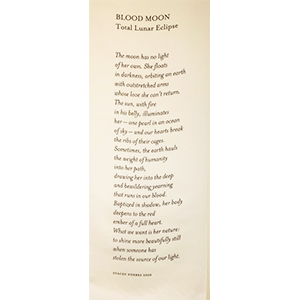
Sun & Moon: A Perfect Match . from the series ‘Beautiful Coincidences’
archival pigment prints and with poems printed on silk
Jeffrey DaCosta
“The PARCEL series is designed as an exploration of the meaning of land and the significance of its designation and control. Photographed entirely in public lands throughout the Sonoran Desert, the images utilize night as a psychological or spiritual filter to reveal the unbridled potential of the raw frontier. In the blackness, the wild and the desire to control the wild, coexist. Light emitting squares in the foreground of each image reference the surveyor’s grid and burn with all the want and need of civilization. These cartographic runes connect to the distant glow of cities lost over the horizon and pose the question of ‘what is inevitable?’ In these works, we are frozen at the crossroads of human will and glance headlong into the mystery of an awesome power just beneath our feet.”

Parcel #2
digital print on metal
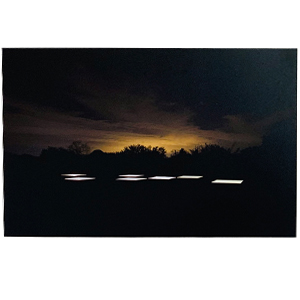
Parcel #3
digital print on metal
Katherine Monaghan
Growing up in the 1970s near NYC with a writer mother and artist father, the arts have always been an extremely fertile component of Katherine’s life. The music, art, fashion and pop culture of the ’70s are woven deeply into the fabric of her work. Monaghan is a mixed media artist who utilizes the medium of rust as a base for most of her large prints. She relates her pattern-based imagery to the rich familial history of the feminine arts of lace making, embroidery, needlepoint and quilting. Monaghan holds a BFA in Illustration and an MFA in Printmaking. Her work has been in exhibitions, publications and in private collections both nationally and internationally.
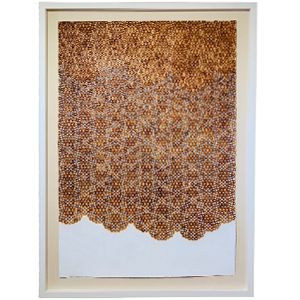
Behind the Clouds
iron oxide and acrylic on paper
Mary Nation
“Prior to moving to Tucson, I spent most of my life living and working in New York City; first, specializing in international finance and then later, as a litigator, concentrating on matters involving complex commercial transactions. I was always a serious amateur photographer and while in New York City was fortunate to study at the International Center of Photography.
Read More
I began my photographic journey in film, which has influenced my work even in this digital age. As I did with film, I approach my photography with quiet deliberation, and am always drawn to light and the interplay between highlights and shadows.
This is why I choose to print my work in black and white. It is elegant in its simplicity and combined with my work in alternate processes, I believe I have found the medium that truly allows me to express why I was drawn to make the photograph in the first place.
Because I am retired, my photography can take center stage. This allows me time to immerse myself in the creative process be it photography or working in the darkroom where alchemy and magic are my best friends.”
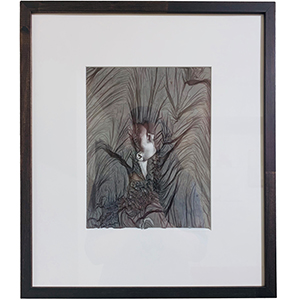
Ballerina
gelatin silver mordançage
Todd Ros
Todd Ros’ paintings can be described as reductive geometric abstracts. Whether working with a wide-ranging color palette or creating variations on a single color, his works of oil on canvas are often rigorously investigated studies on a specific theme. Past series include Film Stills, Fighter Aircrafts and Birds of Arizona. Recently moving from a hardedge approach to a looser and more layered structure, he continues his commitment to abstraction, distilling the desert world that surrounds him into vertical bands of color.
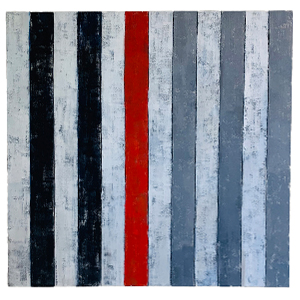
Acorn Woodpecker
oil on canvas

Gila Woodpecker
oil on canvas

Mexican Jay
oil on canvas
[/expand]
Rancho Linda Vista
November 15 – February 5 | 2019 – 2020
To view exhibition information and artist biographies, please click below:
[expand title=”See More” rel=”fiction”]

In 1967, a group of artists decided to create a community in the desert in which to live and create. They settled in the perfect space in the foothills of the Catalina’s near the town or Oracle, renovating an old cattle/guest ranch to meet their needs. Since then, Rancho Linda Vista has been a haven for artists, designers, writers and thinkers. This exhibition will explore the influence and history of this intriguing community and its impact on the arts in Arizona.
For the biographies of the artists in the exhibition, please click here
Artists
Nicolas Baird
I was born in Tucson and moved to Rancho Linda Vista with my parents, Selina Littler and Imo Baird, when I was three years old. An artist and professional biologist, I started seriously making art when I was in high school, taking photographs of the desert around the Ranch and in the foothills of Oracle. This immediate connection with the natural world has been essential to my art practice and has inspired my biological research (which is currently on mammalian evolution). I am interested in dreams, poetry, language, the very large, the very small, and finding new ways of drawing meaning out of mundane experiences. The media I work with includes photography, sculpture, printmaking, writing, painting, and performance, a diversity that grew directly from the support of the Ranch community. Although I currently live in Berlin, I visit regularly and for extended periods. I have always considered the Ranch home.
More
Among my pieces in this show is a constellation made from the ground-up dust of a cow scapula. I found the bone in the hills near the Ranch while on a hike with my father and, when I am away, I thinks often of the clear Milky Way in the sky above Oracle. There is another painting of the sunset after a monsoon from the roof of my parents’ home and the story of a dream carved into clay. On their own, these pieces are disconnected, almost fragments, but here perhaps, surrounded by the art of the community that raised me, the connections become clear.
Imo Baird
It started with a dream, in it I was making a small family of people and animals from old wood. Therefore, the challenge was to start making them in real life. Being neither a carpenter nor engineer, I had problems getting things to stand up right and stay that way. In the years since, I have gradually learned how to do that, but I still like to start with stacking things up, and eventually arrive at some sort of manageable off-balance. Rarely is any piece planned out ahead of time. Meanwhile, the pieces have become a large family, with some relatives more baroque, some more minimal or abstract, but always using discarded materials held together with whatever is nearby. The elements of each piece help determine the form, and parts often remain recognizable within their new structure. Re(con)figuring trash into art, a different kind of useless junque.
More
Although I knew about the Ranch, was acquainted with some of the artists, and had my sole art
class at the UofA co-taught by Ruby Lee (Charles Littler and Pat Dolan), I had only visited RLV a
couple of times. I came to the Ranch with family, as family, married to Charles’ daughter Selina,
and father of his grandson. In the nearly 25 years since, it has become my home, where I have
lived far longer than anywhere else. Selina and I are still in the same house, the one she spent
many of her younger years in; our son Nic’s childhood happened there. Now, I wear several
different hats at the Ranch, I make art and music and have spread out into the wider
community of artists and kindred that has grown up in Oracle. Rambling the surrounding
desert hills is a cherished pastime. However, I work in Tucson, coming down Linda Vista Road
in the afternoon and seeing the west open out is a welcome reward. That is where family is, all
of us there in community keeping the place in good order. The Ranch offers space both
physical and psychic to get work done. There is always more to do.
James G. Davis
Like so many artists before him, James G. Davis was keenly aware of the culture in which he lived. His love for opera, poetry and literature was surpassed only by his love of great art and the tradition behind it. Like the great artists of this century and those past, Davis used all of his cultural awareness combined with a highly personal view of the world to form unique visual statements. With artists eyes he saw the world from his internal perspective and created images that seem to pull at the attention of a viewer, like a homeless beggar catches the corner of our vision on a busy street; a constant reminder of reality as it really exists. It does not stop there either. Davis took us to the brink of fear and the dark passions of the unconscious and then to the other side of reality as seen through the looking glass of our minds eye.
More
However, even amid the loneliness and separations of his figures, there is a glimmer of hope and beauty which he found and conveys so as to push us forward to the next step, the next day, the next level of awareness. It is this latter quality in his work that gives it a universal appeal; that amid the catharsis’ and the enigmas of life, there is hope through perseverance. Davis used the artistic tradition to transcend the ordinary and broke from it to create informed autobiographies that may help us to understand the essence and complexities of the soul of man.
James came to Rancho Linda Vista in 1970 with his wife, Mary Ann. It was a wonderful place to work and raise his family. He taught at the University of Arizona for 20 years mentoring and inspiring many students, several of whom still visit the ranch.
James G. Davis passed away in September 2016. He leaves behind a legacy of picture making that continues to amaze and challenge new generations of viewers.
White Boots: Ghost of the San Manuel Mine
Poem by William Pitt Root
As you know, Jim, I did work underground
in the same mine you’ve imagined
in your studio: half a mile down, taking
wages enough to make it to California
and fool’s gold enough to remind me
I don’t know much after all.
New guys like myself – still thrilled
by the dangers of fire or falling
through the dark into a hole followed
by twenty tons of dusty rumbling ore-,
we all tried to stay alert
each minute of the eight-hour shift.
And for a week or two, alert we were,
then habit made us carless as the rest
so we’d pocket our safety glasses,
let dust masks dangle from our necks
and sometimes catch each other
stepping out across open shafts
without first snapping our lanyards
to the rusty cables overhead.
The buddy system wasn’t much observed,
so like the rest come break time
I’d kick back alone against the stone wall
and light up, flicking my headlamp off
so the dark expanded, flooding gently
through my eyes. In the distance,
sometimes, a solitary hunched figure
projecting its small edge of light
would glide by my line’s entrance
tiny as a fly in a tear of amber
from where I watched, invisible
and isolate as a stone in outer space,
or inner space. Just some guy.
Never saw old White Boots in those days
but often thought how all those men
just lost in the Sunshine Mine
must have felt – poor bastards
who lived long enough to feel,
long enough to lose everything
in their minds but hope
before their air was gone, long after
their light. You’d have to kill your light
to keep from igniting whatever gasses
might be seeping from walls
so dark is where you’d be,
whether by yourself or in the company of others.
In such a dark I had no need of White Boots, my friend
but looking at his image, startling, almost comic,
you’ve drawn from the dark of blinding inks
and your own heart familiar with disaster
I’m reminded now of how it is
the living keep hold of the things
that blind them to those gone –
how gypsies, when a loved one’s dying,
will help the one failing stay just a little longer
by turning a wooden chair upside down
to hold between them. On one leg
a live hand, the dying on another,
until, ready, it falls free. But
the thing is the clasp itself
across that final distance,
how it allows those last things
that need saying to be said.
That’s how it’s always seemed
to me, with art I mean. Whether
it’s paint on canvas or ink on a page,
it’s the chance for what knows it must die in us
to join what knows it will live forever.
And knowledge from such a common depth
only survives in the light as shadow,
as White Boots, imago, as a way, meanwhile,
to stay in touch while the sun burns on.
Mary Anne Davis
I came to Rancho Linda Vista in 1970 with my husband James G. Davis. Our son, Turner, was born the following year. I taught arts and crafts at San Manual High School for 30 years and consider myself an artist/seamstress. The two pieces shown in this exhibition are part of my Quilt series using paper, cloth and sewing techniques.
Pat Dolan
I came to Rancho Linda Vista in 1979 as a visiting artist from Chicago. I stayed for 15 years, began an art partnership Rubylee with Charles Littler that continued till his death in 1991. Charles and I collaborated on site sculpture, performance art, installations and community. During my years living at RLV, I was the board president, began the visiting artist program, hosted yearly
More
Halloween parties for the kids and discovered the beauty of the wild landscape that surrounded RLV. Instead of pigeons, I met many hawks, ravens and owls.
Living at Rancho Linda Vista supported my ongoing practice as an artist. Besides collaborating
with Charles on Rubylee projects, I continued to draw the beauty of the surrounding landscape
in pastels. What I learned living in the community I have also given back in my teaching at The
Drawing Studio. I no longer live at RLV but I feel a part of the larger extended Ranch family.
Besides showing my artwork in the Barn Gallery, I often act as the celebrant of marriages and
celebrations of life of the residents of RLV. My interest in what happens when we die is
reflected in this pastel as well as my connection to the jaguar.
Turner Davis
I have been drawing since I was a little kid. I used to follow my parents, James and Mary Anne Davis, around museums and made rudimentary sketches from canvases of the old masters. I used to watch my father draw and I discovered early on a doorway to parallel worlds scrawled into notebooks. Drawing saved me from the worst of teenage angst and served as a way forward when it seemed there was none. From drawing came painting.
When I am at my best, my pictures skate along a crumbly edge between autobiography and the fantastic. I try to gently examine those places where the pleasure and burden of the body intersect with the lightness of dreams and nightmares.
I believe in being badly proficient and love exploring different styles and iconography.
Matthias Düwel
I first became aware of Rancho Linda Vista through my wife, Emily Stern Düwel. Her parents helped found the ranch, so she spent time there as a child and always felt a strong connection to the place.
10 years before our move to Arizona in 2004, we spent nearly each August on the Ranch, which was a welcome and rejuvenating break from our very busy NYC life. We have gotten to know many of its members.
After 9/11, life in NYC became more stressful, so almost 15 years ago, when a house became available, we applied for it and took a wild leap of faith by moving to Oracle. I was fortunate enough to get a full-time faculty position at Pima Community College in 2005, where I still teach today.
More
Beyond being a serious practicing artist, I do not consider myself as having a specific role within
the Ranch community. I do believe that the work I do at Pima College services a vital need in
the larger community of Southern Arizona. Being an art educator is both challenging and
satisfying at the same time. I am hoping to have opened the eyes of the thousands of students
who have come through my classes. That said, everyone who lives on the Ranch pitches in: I
manage the summer artist residency, help with promotion and hanging shows, and
occasionally fill potholes.
Having lived all my life in large metropolises, our move here was a dramatic change and the first
few years were hard for me as an artist. I felt somewhat lost, but I eventually became quite
aware of developments and the possibilities of expanding on the multitudes and repetitive
excesses found here. The subject of my art started changing from urban destruction to, what is
ultimately even worse, the destruction of our environment. My focus broadened to similar
global phenomena and their repercussions, to issues like the mass diaspora of people brought
on by wars or natural disasters.
Maybe the seeming stability of the Ranch brought the constant instability around us more into
focus.
The 12 pieces from the Irrwanderungen series exhibited here are the most recent
manifestations of these themes. They are concerned with change and the instability brought
on by displacement, and inevitably, a profound loss of hope.
I am not sure what I will leave behind. It is for everyone else to gather the pieces of those who
leave and make sense of it.
David Jaffrey
Ann Woodin, Andy Rush’s wife, was a patient of mine and invited me to dinner at the Ranch. That marked the start of a long and rich friendship with both. I arrived at Rancho Linda Vista in 1975 with two young sons from an ended marriage and just starting a career in clinical acupuncture at the University of Arizona College of Medicine and private practice. I spent lots of time commuting to Tucson, while fathering three sons. Painting and drawing when time permitted over the next 40 years until retirement from my acupuncture practice. During that time I married Ellen, trained in aikido for 15 years, took classes at the Drawing Studio, and travelled internationally for professional development and accompanying Ellen on her anthropological lecturing events.
More
Glenwood was a delightful stop on a motorcycle trip to summer aikido camp. Amazing how time passes when watching a creek flow.
Omote is an imaginary landscape. The title refers to the Japanese word – usually paired with ‘Ura’ and connotes the dichotomy of front or outer; and back or interior, as in the formal front of a house and the more informal messier and intimate reality that lies within. An old Japanese adage is ‘the bigger the front, the bigger the back’.
Marshall Gulch was a great hike and a recalled conversation with Bruce McGrew about painting the light.
Joy Fox
I moved to Rancho Linda Vista in 1968 with Bruce McGrew and our two small children, Shelley and Blake. We were looking for a place where we could raise our children, have space for studios and be in a rural setting. RLV offered all of that including working alongside other artists to preserve Rancho Linda Vista in order to provide its members with an environment conducive to artistic purposes and related endeavors. We began by turning the run-down guesthouses into homes and the barn into studios and a gallery. After over 50 years, we are still working on over 20 historic adobe buildings, a gallery and a number of studios and guesthouses. A village offering a sense of place, family, community and center for the arts.
More
The Rancho Linda Vista Gallery has been in operation for most of those years and has been an important connection with artists from the Ranch, Oracle, Tucson and worldwide. Every year at Christmas, we have a group show of Ranch artists. We also have a guesthouse and studio for artists of all disciplines. It is set aside one month of the year for an artist residency, with stipend, studio and show of their work.
We have become an extended family with those of the second and third generations returning to either live or visit. In 2005, our daughter Shelley and Andy Rush’s daughter Maggie formed the RLV Oracle Art Nonprofit foundation dedicated to supporting cultural projects in our community. They have had many Summer Youth Workshops for local children in the renovated Wilson Barn adjacent to RLV. It serves as studios, gallery, and classrooms for workshops and events. Our community has grown to include our children, those that have lived here in the past and friends visiting through the years.
Kelly Griffith
I began experimenting with photography as a child using a Polaroid camera. Over the many years and countless hours in the darkroom watching images appear like magic, I have come to appreciate that no matter what type of camera you use, it is the personal lens that creates a quality image. The lens I use has been crafted throughout the years by my own life experiences, bias and perspective as a woman who has spent the majority of time in the natural world.
More
It seems like I have always been part of Rancho Linda Vista. I grew up in Oracle and my closest
friends and their artist parents lived on the Ranch. I visited early and often. The Ranch was a safe place for me to explore and express my true nature. As an adult, I returned to the Ranch through marriage. One does not simply marry an individual from the Ranch, one must also be conscious of the fact that you are also marrying into the larger Ranch community as a whole.
I have been living on the Ranch for the past twelve years or so. My primary role is the spouse of a second-generation founding family member. I defer to the experience and wisdom of those who have been engaged with the ideal of art and community long before I held my first Polaroid camera and find my place in small acts of kindness along with a willingness to roll up my sleeves and help wherever I can. I bring my lens and leave behind my footprints and photographs and maybe a few fruit trees and possibly watercolor or two.
Charles Littler
Charles Littler is considered by most members as the founding father of Rancho Linda Vista, even though the community has never been a single mind on any subject including this one. In his mind, Rancho Linda Vista is first, a place. It is an ex-dude ranch on 80 acres of beautiful foothills near Oracle, Arizona. The actual nucleus of our community formed in 1968 as the ETA Trust. A group of ten couples or families who came together to sign the mortgage on Rancho Linda Vista.
More
This mortgage signing, to Charles, was amazingly like a hospital booth (antiseptic but efficient, presided over by trained professionals – in this case lawyers, accountants, agents, secretaries, etc.). The community’s subsequent growth even developed much like a body – losing and adding elements while maintaining a remarkable continuity of shape and style over the years as it evolved.
If they were a bit immature as a community, it may be partly because of the rough time they had in their early years. When they first began moving into the old ranch buildings, all the systems broke down – water, sewage, electricity, gas, etc. They all had to spend the first several years living very primitively while they redid everything (sometimes two or three times before finally getting it right). In their spare time, they remodeled the barns and outbuildings into art studios, and once they saw communal eating would not work on an everyday basis, they started putting kitchens into various houses. While all this elemental but largely invisible work was being done, many of the marriages and even friendships came apart. Alas, by their fifth year together, none of them had much to show as improvements in their lives.
The community did persevere, however. By 1975, they began a new phase of expansion and development. Those marriages that did survive began to strengthen, new relationships to thrive and everyone to prosper. In addition to sponsoring hundreds of arts events, Rancho Linda Vista has also taught themselves how to cooperate and have created various ways of achieving group consensus. Most importantly, they have all come to honor and support each other’s personal aims. These are major accomplishments for any group in the 20th century.
Statement from Rancho Linda Vista booklet, 1988. Charles Littler passed away in 1991.
Selina Littler
There was a period in time when I worked mainly with natural materials, building sculpture from mud, rocks, sticks, hog casing, cotton, leaves, dead bugs and a desiccated bat, maybe a skeleton of an owl. I made imagery that was biographical. Although abstract, it related directly to my life. The spiral stick swirl is symbolic of obsession, fragility, and being bound to a cycle; the double arched piece is about letting go of control, allowing trust to seep in, and giving it up to the world to take care of.
More
There were many of us who grew up on the ranch. I was nine when we moved out of the city and into the desert. We played in cactus, were chased by bulls and javelina, thrown off horses, bottle-fed baby goats and sheep. We were unaware of the rattlesnakes in the bushes, breathed packrat dust, stepped on rusty nails, climbed on and fell off of boulders head first, climbed into bed only to get stung by a scorpion, swam in green scum ponds with broken glass and dead animals at the bottom, stepped on Colorado river toads (by accident), were chased by adults after spying on them through windows, walked into barbed wire fences in the pitch black of night, had our heads bashed into snow forts we’d made ourselves to hide behind after throwing stone-laced snow balls at cars that drove by, swung from windmills fifty feet high, watched filmmakers make their pseudo-porn scenes in the washes, took in stray dogs. Those dogs are long gone, some people too. I left in my early twenties and came back in my early thirties to raise our son, Nicolas. There may not have been as many kids when he lived here but I think he’d agree there would have been no better place to grow up, close to nature, with its volatile beauty all around. Who could not be strongly influenced by Rancho Linda Vista, manifested in the many paintings, drawings, poetry, writings, plays, choreography, photography, sculpture, and lives of those who have been here, spent time here, or just passed through this place?
Bruce McGrew
Bruce McGrew was a Professor Emeritus of Art at the University of Arizona, where he taught from 1966 until his death in 1999. His home base was the art community he helped found, Rancho Linda Vista in Oracle, Arizona. From there, he traveled the world giving lectures, workshops and painting. His watercolors especially express the light and space of the landscape in which he painted. He characterized one of his guiding intentions as “space that retreats, light that advances, and a third mysterious thing that happens between them.”
Danielle Neibling
The work you see is part of an ongoing project. It is simultaneously about the pat dialogue of formalism and another dialogue that takes on strategic thinking of gaming, personal relationships and war. Pairings of forms (a dark and a light) arranged within a grid were initially based on jigsaw puzzle pieces. The gird was both simple and tantalizingly complex to balance.
More
In June 2019, I turned to sculpting versions of the forms I had been painting and drawing with the intention of defining a set of shapes to refer to in a future body of oils. As of yet, I have still not met my own goals for the number and variety of forms.
I am the daughter of Judith Stewart. My children, Maxim and Annabelle, and I live in the nearby Wilson Homestead House, which is a designated part of Rancho Linda Vista history.
Arnold Nelson
I am a medical doctor and an artist. Along with my late wife Marilyn and my family, have lived at the Ranch for almost 50 years. During this time, we have built a collection of art by Rancho Linda Vista artists and friends that now numbers over 600 works. The first piece we acquired was in 1970, a painting by resident artist Bruce McGrew, received in trade for a washing machine.
More
My family has always kept their collection open to the Rancho Linda Vista community and its many visitors. This allows us to enjoy and share a collection that illuminates our extraordinary history, its relationships, and its presence in the larger community. The collection itself is a work in progress that reinforces these connections and stories and renders them visible.
A personal art collection, whether large or small, is in fact an ongoing process of creative
discovery and expression that can profoundly enrich one’s life and relationships. Each piece
has a story connected to it that keeps my many art friends close to me over the years.
Andrew Rush
In the early 60s, Charles Littler, a few others and I met frequently with Hazel Larsen Archer, a former faculty member of Black Mountain College, a well-known early endeavor in community learning in North Carolina. Those conversations eventually led to the founding of Rancho Linda Vista in 1968, largely inspired by Charles.
In 1969, I resigned from my tenured teaching position at the University of Arizona, sold my Tucson property and moved with my family to RLV, literally committing my future to creating a viable community of the arts. In the first 20 years, many students came to the Ranch to study with me. At the same time, my second wife Ann Woodin and I travelled often to study community-based life skills with courses at the Esalen Institute, Green Gulch Zen center, Tassajara, as well as programs like Werner Erhard’s seminars in social dynamics and communication, often sharing our discoveries with our friends at RLV and introducing helpful teachers to the Ranch.
More
Clearly, I can say that our community based and rigorous art practices grounded RLV in a seriousness that has always encouraged me to my best efforts. Because many artists are looking for that in themselves, word of our community has spread for years now, inspiring people from many creative disciplines to visit. So that we at the ranch are blessed by a wide range of visiting artists, poets and musicians who often become life-long friends.
This is an example of a recent new direction in my desert studies, using the grasses, plants and
seeds of the desert where I live, as monoprint material printed with acrylic colors on my etching press in many layers– to create a meditative image that evokes the seasonal micronature of the Sonoran landscape of these northern Catalina Mountain slopes.
Andrew will be exhibiting pieces from his Desert Studies series in the Entry Gallery, December 27 – February 2.
These Intaglio etchings were an experiment from my European travels in which I reconstructed a plate first used as an Italian cityscape by abstractly superimposing a self-portrait etching over the skeleton of the original image.
Emily Stern Düwel
I first encountered Rancho Linda Vista as a ghost ranch. I was barely eight years old and my parents, along with several other artist families, had just purchased the property. It was a gray day and the adobe buildings stood empty and in disrepair. It was a child’s dream come to life. It was also a dream deferred. My family would stay summers on the Ranch but by the fall, we were headed back East, where my father as a composer had better job prospects. Still, summers on the Ranch were glorious: we ran everywhere and anywhere, got up to every kind of mischief, set up secret forts, had close encounters with cactus, and found ourselves lost once or twice.
More
After a 15-year hiatus, a wedding in Tucson offered the chance to reconnect. Starting in the early 1990s, my husband and I would come out each year and stay a few weeks or a month, in either the guesthouse or Ann and Andy’s Bath House. In that time, memories of the past began to give way to new associations, brought about by solo desert hikes, time spent drawing, writing and visiting with others.
Still, sometimes past and present folded into each other. Soon after, we moved permanently to the Ranch, two childhood tokens reappeared. The first was an old piece of plywood, on which years ago I had scribbled in tiny characters, “Private Property. Keep Out!” with requisite skull and cross bones. The other was a crimson-colored butterfly Yo-Yo that disappeared in my 11th year and showed up some 30 years later, in the wash.
My husband and I moved to Arizona from NYC with no job prospects lined up. We did however have a house! It took nevertheless a decade to grow used to the idea of the Ranch as my adult home. In my painting, I spent a couple of years re-encountering the past, working and extrapolating from miniscule video stills and ancient impressions. In time, the encounter with the desert began to feed into my work in a way that drew on and shifted my approach to image making. At first, living here I felt a distinct loss of privacy. Although, in all fairness, as a community we mostly respect each other’s boundaries. It took a while to understand that we each live very individual lives and hold fast to different perspectives and ways of operating or being in the world. While resolving disputes as a community can be a bit of a tussle (and requires a bit of skin thickening to boot), that individuality is, I believe, key to how and why we continue to survive. That and a certain openness to change.
What has Rancho Linda Vista ultimately meant to me? In NYC, we inhabited a delicately wrought bubble: friends were largely our own age, with shared interests, references, and values. I created social history exhibits for people with whom I had little contact, studied civil wars in distant lands. Moving to Arizona has put me smack dab into community, both on the Ranch and beyond. It has forced me to engage more directly and brought on new kinds of awareness, as an eye that must take in a more close-up field of vision. To enter the wilderness that lies just beyond the Ranch, to traverse the ridges and arroyos that abut the Catalinas, is to chance encounters with the unexpected and in that moment to surrender one’s most fast-held parameters.
Jean Stern
My work is concerned with color, form, and the persona in nature. The paintings included in this exhibit were inspired by several trips to Rocky Point made during stays at Rancho Linda Vista, as well as earlier memories of Cayuga Lake in upstate New York. In their interactions with the sea and surroundings, the figures become interchangeable with the natural world.
Judith Stewart
My sculptures are half about materials, and half about form. Clay has a beauty of its own. It holds texture, edge, and rich natural surfaces that can be wonderfully surprising. In hand, a slab of clay is flexible and yielding, naturally tending toward organic contours. Joining one section of clay to another, a human form begins. It is an intuitive way to work, very open to what the clay suggests. At the same time, my empathy for the beauty of the human form, and what it suggests, makes the final decisions.
The demand put upon materials to hold form, and the hope that a human presence will emerge, is for me the fascinating part of making figurative sculpture.
More
“Finding” Rancho Linda Vista, at a time in my life when I was “searching”, was like having good fortune all in one place, at one time. I came to RLV as a guest artist in 1991 and in two weeks knew I wanted to stay. Andy Rush responded to my question “how does one get to stay here?” by saying, “everything happens through people”. I went from being one individual to being one among many. I learned that everyone has an opinion, and that it was not only OK to be wrong, it was a relief not to have to always be right.
RLV has given me a place in the large home that is Rancho Linda Vista, a small house with a mountain to contemplate from my kitchen window, a studio for art, other artists and good people for companions, gallery openings and music in the barnyard, and Ranch meetings where everyone speaks their mind. I live in nature, with ancient granite boulders, parades of wildlife, battles with prickly pear, earth to dig in, a nurturing of manzanitas, buckwheat’s, native grasses, and any small plant that volunteers. Our rules are pay your rent and take care of your house. We do not need a rule that says — Love This Special Place.
One unforgettable experience of this place was being up on the parapet roof of El Deseo, where one can see the far landscapes in all directions. I saw the evening sky with two perfect spheres, the sun going down in a blaze behind the mountains to the west, and the moon rising into the deep blue sky in the east, in perfect balance. It felt like my arms were reaching out, conducting a symphony of nature.
[/expand]
Queen of the Night
June – July | 2007 – 2019
To view exhibition, please click below:
[expand title=”See More” rel=”fiction”]
She is called the Queen of the Night, La Reina de La Noche or the Night Blooming Cereus and every summer, for one night only, whatever she may be called, Peniocereus greggii becomes the Belle of the Ball, the superstar of the Sonoran Desert. The Cinderella-like cactus looks like a dead stick for most of the year but transforms herself in the early summer months, blooming alongside many plants in the area and then closes forever by morning’s light.
Tohono Chul possesses 350 Peniocereus greggii, the largest private collection in the world. Many of these curious cacti were found growing in the park with others being donated over the years, some being saved from the bulldozer’s blade. The number of flowers blooming in one night has been as many as 174 on 69. As beautiful and enchanting as the blooms of the Night Blooming Cereus are, what happens in the dry desert dirt and in the nighttime sky is as fascinating as the wondrous white blooms. Maintaining and sustaining the plant below ground is a turnip-like tuberous root and up in the sky, the tireless pollination of the Hawk Moth. The whole cycle is a marvelous story of courage, endurance, perseverance.
Read More
Tohono Chul possesses 350 Peniocereus greggii, the largest private collection in the world. Many of these curious cacti were found growing in the park with others being donated over the years, some being saved from the bulldozer’s blade. The number of flowers blooming in one night has been as many as 174 on 69. As beautiful and enchanting as the blooms of the Night Blooming Cereus are, what happens in the dry desert dirt and in the nighttime sky is as fascinating as the wondrous white blooms. Maintaining and sustaining the plant below ground is a turnip-like tuberous root and up in the sky, the tireless pollination of the Hawk Moth. The whole cycle is a marvelous story of courage, endurance, perseverance.
28 years ago, in June of 1992, Tohono Chul held its inaugural Bloom Night. Docent, Betty Carras provided a vivid recollection of the night: “Watching carefully, we could actually see the opening spurts of the blossoms. Slowly, but inexorably, the bud became a flower. Ghostly white, it gradually opened its funnel-shaped blossom—becoming more aromatic as it increased in size. By the time its slender white petals were almost fully opened and the flower nearly five inches across, it was extremely fragrant. The velvet-like embrace of warm night air, the magic of a sweet-scented evening and the distant chorus of singing coyotes made it truly a night to remember.” It was a casual affair outside the shop with a little over 20 people bearing witness. One plant produced six flowers while another plant produced one. From that evening a Tucson tradition was born. Since that first string of phone calls by a dedicated few, word has spread and now with each Bloom Night, over a thousand visitors experience something mysterious and incredibly magical.
Learn more about the Queen of the Night, Click Here
Artists
Lyn Hart

Cereus Expectations
“This tapestry was based on a digital photo I took of our Night Blooming Cereus which was purchased at Tohono Chul. Although the photo was very nice, I used my graphic art software to
More
posterize it for the effect I was seeking. I was thinking of the excitement and electricity surrounding the festival every year as everyone holds their breath in anticipation of the bloom. I was also imagining how the moths who visit the blooms might see or sense their luminosity. An interesting note– the light khaki green wool in the stamen and pollen head area was dyed with blooms from a sunflower plant we purchased at Tohono Chul several years ago!”
Lyn Hart has been drawing and painting as long as she can remember. Her interest in textiles and fibers began in her early twenties in Florida where she taught herself to make quilts. Later, in her early thirties, during a summer break from nursing school, she studied Southeastern reed basketry with a local basket maker.
After relocating to Tucson, Arizona in 1997, Lyn worked for a number of years as a labor & delivery and obstetrical research nurse, all the while taking every opportunity to explore and become increasingly enamored with the desert lands of the Southwest. In 2005, she left nursing to focus on her dream of becoming a fiber artist. After taking a natural dyeing workshop taught by a tapestry weaver, she decided to pursue the medium of handwoven tapestry.
In 2006, Lyn began exhibiting her tapestries; in early summer 2007, her home studio was constructed. In 2018, a growing desire to create non-objective series led her to delve into mixed media collage, a genre that shares many of the tactile qualities of working with fiber, but allows for faster exploration and implementation of ideas and inspirations.
Lyn’s work in tapestry has garnered a number of awards, including three National Park artist residencies at Grand Canyon North Rim, Glen Canyon National Recreation Area (Lee’s Ferry), and Zion, earning her the distinction of being the first tapestry weaver to participate in the National Park system’s artist-in-residence program. Her tapestries and mixed media collages, which have also begun to receive rewards, have been exhibited in both local and national venues. Lyn’s passion for and exploration of the Sonoran Desert began when she arrived in Tucson and was enhanced during a several year stint as a volunteer naturalist at Sabino Canyon Recreation Area followed by a yearlong arts fellowship at the University of Arizona’s Desert Laboratory on Tumamoc Hill in 2018, and continues today through her wanderings in the Southwest.
To learn more about Lyn Hart and her work, Click Here
Annie Antone
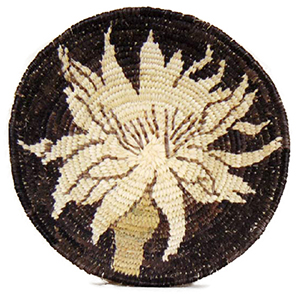
Queen of the Night
The Night Blooming Cereus, also known as Peniocereus greggii and Queen of the Night, resembles a bunch of dead sticks most of the year. Its finger-thin, woody branches grow from a large turnip-like
More
tuberous root. However, during one summer night it transforms with a burst of magnificent white aromatic blossoms.
The Night Blooming Cereus is part of Tohono O’odham legend. It is said that an old woman named Mother White Top journeyed from her home to her daughter’s village because her daughter’s spirit came to warn Mother White Top there was trouble. When she found her daughter, she found her ill and holding a newborn boy. Her daughter begged Mother White Top to take the child home with her because her husband’s people wanted the boy to become a warrior. Mother White Top called upon the spirit I’itoi for help. He sent animals to help her evade the husband’s people as they hunted for the child. Mother White Top sent the child back to her village in the care of I’itoi and she changed herself into withered brown sticks with only white hair to identify her. I’itoi promised for her sacrifice that once a year she would be the most beautiful thing in the desert.
Annie Antone was born in Tucson, Arizona in 1955 and is a Native American Tohono O’odham basket weaver. She learned how to weave baskets from her mother, Irene Antone. Annie began at the age of 19 and sold her first basket for $10. She gave the money to her mother. Currently she lives on the Gila Bend Reservation. Antone only uses plant materials harvested from her homeland, the Sonoran Desert. These include yucca, devil’s claw, and bear grass. Her techniques in making coiled baskets are traditional, but her designs are completely unique. She specializes in highly graphic, pictorial imagery with realistic images of panthers and semi-tractor trailers. Annie was the first basket maker to sign her work; she weaves a tiny “AA” into the base of her baskets. The “AA” can be seen woven in yucca at the base of the Queen of the Night basket. The Antone family are famous for their work. This piece was made for the Park’s show, QUEEN OF THE NIGHT: NIGHT BLOOMING CEREUS.
Su Egen
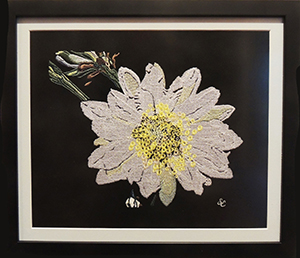
One Night Bloom
“I have always been fascinated by the Night Blooming Cereus, which comes to life when most are asleep. I love to walk late at night and discover these magnificent, pungent, sweet-smelling blooms that display such incredible beauty and magic. I check the status of the plants as I walk during the day and can usually
More
tell what night they will begin to bloom. I began designing this embroidery in the summer and sewed it out in December of 2015 inspired by In Full Bloom. I used four shades of white, for a total of twenty colors. The piece contains 74,472 stitches. The quiet and secretive nature of this flower and the rarity of when it blooms keeps it ever exciting to see, a natural wonder of the desert.”
Su Egen has been a textile artist and weaver for the past forty-six years. Sixteen years ago, she added an embroidery room to her studio where she creates embroidered studies for her tapestries and other original designs to sew out on her embroidery machine. Directions are sent from her via her computer after the design has first been drawn out, then digitized for the machine, instructing the machine regarding which stitch to use, what color, in what order etc. The process is fascinating and enables her imagination to run wild. The thread colors do not come up on the computer accurately so she has to envision what they will look like and after years of working, this procedure out she is able to get the results she seeks. This has opened up a new world of possibilities.
Farraday Newsome and Jeff Reich
Queen of the Night
“This bowl is glazed in the colors of moonlight. A desert hawkmoth, its head buried in the pollen-laden, beautiful white flower of a Queen of the Night cactus, gathers nectar as it concurrently pollinates the flower.
More
This occurs amidst intertwining cactus branches and egg clusters. The drifting watch alludes to biological time, the playing card to chance and random odds, while the eggs, flower and pollination refer directly to fertility and regeneration.”
Farraday Newsome grew up in the Redwood Forest of California. She is the daughter of Barbara Newsome, a businesswoman and master gardener, and George Newsome, a painter, potter and dinnerware designer who earned his degree in ceramics at Alfred State University, studying under Daniel Rhodes. Farraday studied biology as an undergraduate earing a BA from the University of California at Santa Cruz in 1976 and later earned her graduate degree in Art, Ceramics Emphasis, from San Francisco State University in 1987. She currently lives in the Sonoran Desert of Arizona with fellow potter and husband Jeff Reich. Together they run Indigo Street Pottery in Mesa, Arizona. Both also teach pottery at the Mesa Arts Center.
Farraday’s subject matter is drawn primarily from nature and the emotional allusions and metaphors found in nature. Her color work celebrates the light and exuberance of day, while her black-and-white work delves into the shadowy, more emotionally complex realm of night and darkness. Farraday Newsome’s work can be seen at Plinth in Denver and ARC Arizona Contemporary Art in Cottonwood, Arizona, and in the online gallery Artful Home, Wisconsin. Her work is included in many collections, including the Smithsonian American Art Museum, Long Beach Museum of Art, Racine Art Museum’s Wustum Museum in Racine, Wisconsin, Prague Museum of Decorative Arts in the Czech Republic, Ohio Crafts Museum, Rhode Island School of Design Art Museum, and the Arizona State University Art Museum. Her work has been featured in many books and magazines.
Jeff Reich was born in Livonia, Michigan, a suburb of Detroit. His father was an engineer with an eye for detail and his mother was a homemaker who loved to paint and garden. Jeff grew up with interests in architecture and basketball. Early in his college career at the University of Michigan, Jeff moved to Arizona to transfer to the University of Arizona in Tucson. He settled on a major in Arts Education. After taking a ceramics course there, he knew that was his deepest studio art interest. Jeff spent many hours in that studio, befriending his ceramics professor Maurice Grossman, now a retired Professor Emeritus. Maurice is a friend to this day.
When Jeff graduated, he started a home pottery studio and began teaching pottery part-time in Tucson. When he learned of a full-time job opening for lead pottery instructor in Mesa at the Mesa Arts Center, he applied. Rudy Turk, former director of the Arizona State University Art Museum, was part of the hiring panel. Jeff was offered the job, and has been the director of the Mesa Arts Center Ceramics program ever since.
Jeff is an exhibiting studio artist as well. He maintains a home studio, Indigo Street Pottery, with his studio potter wife, Farraday Newsome. Reich’s work is included in numerous public art collections, including the Northern Arizona University Art Museum, the Ceramics Research Center of the Arizona State University Art Museum, the City of Phoenix Contemporary Arizona Ceramics Collection, the City of Mesa Contemporary Art Collection, the Kamm Teapot Foundation, and the Northern Clay Center of Minnesota. Jeff Reich’s work has been featured in Lark Books’ 500 Tile and 500 Cups. He also has been featured in numerous magazines, including Ceramics: Art and Perception, Ceramics Monthly, and Clay Times.
To learn more about Farraday Newsome and Jeff Reich and their work, Click Here
Erinn Kennedy
Still Life with Night Blooming Cereus
“I paint the objects and places that I love and are a part my everyday life. I find inspiration in the Sonoran Desert landscape in and around Tucson, Arizona where I live. I am very interested in its natural beauty, historic manmade structures, and
More
stories left behind. I am equally interested in the atmosphere that surrounds these places and the moods they evoke.
When I see a still life arrangement or an outdoor scene that captures my attention I will make several sketches of it from observation, emphasizing spatial relationships, passages and colors that I find interesting or unexpected. When starting a painting I put these sketches away and work from memory and attempt to capture the beauty and essence of these engaging places and things.”
Erinn Kennedy is a Tucson artist who went to college in Oregon. She has been exhibiting her work throughout Oregon since 1991 and at Tohono Chul in various exhibitions since 2016. Her paintings are in the Microsoft Corporate Collection in Washington and the Portland Art Museum Collection. She often starts a painting with a loose idea about the subject. Erinn use sketches and notes made from direct observation for reference, as well as from memory and her emotional reactions to a place or an object. Her aim is to arrive at a finished piece that is balanced, loose and joyful.
To learn more about Erinn Kennedy and her work, Click Here
Todd Ros
Cereus Cactus Flower
Todd Ros’ paintings can be described as reductive geometric abstractions. Whether working with a wide ranging color palette or creating variations on a single color. His works of oil on canvas are often rigorously investigated studies on a specific
More
theme. Past series include Film Stills, Fighter Aircraft and Birds of Arizona. Recently moving from a hardedge approach to a looser and more layered structure, he continues his commitment to abstraction, distilling the desert world that surrounds him into vertical bands of color.
Todd Ros’ paintings can be described as reductive geometric abstracts. Whether working with a wide ranging color palette or creating variations on a single color, his works of oil on canvas are often rigorously investigated studies on a specific theme. Past series include Film Stills, Fighter Aircrafts and Birds of Arizona. Recently moving from a hardedge approach to a looser and more layered structure, he continues his commitment to abstraction, distilling the desert world that surrounds him into vertical bands of color.
To learn more about Todd Ros and his work, Click Here
Vivian Hutchins
“I have been a desert runner and walker for over twenty years and have been following these plants in the eastside desert, drawing and painting them and watching for when they are ready to bloom. They have been a passion of mine for many years.”
More
Vivian Hutchins is an artist who works mainly in Prismacolor Pencil and oil. Her interest is in what is necessary for us to view something as real. She believes there are patterns in nature and the environment around us that cause us to perceive something as real. The balance between photographic realism and appreciating and focus on order in chaos is always interesting to her.
To learn more about Vivian Hutchins and her work, Click Here
James Burton
“These are part of a sequence of photos of the Peniocereus greggii, Queen of the Night, which I discovered in Sabino Canyon. It took several years, but I finally caught it in bloom. Growing wild, the cactus spends most of its life almost invisible, looking like a dead stick, typically hidden among the branches of desert shrubs such as mesquite and creosote. At the beginning of summer, the stick produces flower buds that develop over a few weeks.
More
Then, for one single night during the year, for about 12 hours, about one tenth of one percent of its annual life cycle, the plant throws out a beauty, both visual and olfactory, that strongly attracts hawk moths and photographers. All the buds in the same area, by means not really known, get the message when the party will be and, not capable of self-pollination, try to bloom on the same night. They then quickly devolve back into obscurity until they fruit.”
James Burton began using a film camera when he was eight and doing his own darkroom work as a child. Later, in college in Tempe, Arizona, he fell deeply in love with the American Southwest. His career as a geologist and archaeologist took him across four continents, but Arizona remained, by far, his favorite place on the planet. When he retired in 2015, he returned to Arizona and found time to use a camera again, together with a computer. This has given him the ability to create digital images that express how he experiences the Arizona desert.
Tom Baumgartner
Cereus Lunix
“Flowering plants have symbiotic relationships with pollinators, but I was thinking about the cereus and its relationship with night. The timing of cycles, quiet glowing shadows and moon light being the first light to illuminate the tissue paper thin petals. Overlaid in the background is
More
a dotted diagram of moon craters.”
Tom Baumgartner is interested in an ancient and futuristic aesthetic that frames the unknowable history of a place and its unknowable future. He likes mystery. He likes mysterious symbols. He likes the futuristic feel of ancient glyphs and the ancient aspects of our modern symbol making. In the digital age of computer interface, symbols embedded in natural scenes hint at an underlying structure, invisible forces, and human influence.
Tom has painted in oil and drawn with ink for 30 years with a BFA from the School of the Art Institute of Chicago. He have lived in Tucson for 20 years and been actively involved with local arts organizations as well as founder of Wee Gallery. A life-long nature lover, his art has a focus on the desert landscape, automatic writing, and aesthetics of science. He is currently the Creative Director for AlphaGraphics in Tucson.
To learn more about Tom Baumgarner and his work, Click Here
Check out Tom’s work available in the gift shop, Click Here
Ron Cornett
Queen of the Night
“I am inspired by the complexity and beauty of the Sonoran Desert, its flora, fauna, denizens and cultures. This piece is from a study in color and line work series. I wanted to take my line work skill from the comic book world and superimpose that against the beautiful colors of the desert at night.”
More
“I am inspired by the complexity and beauty of the Sonoran Desert, its flora, fauna, denizens and cultures. This piece is from a study in color and line work series. I wanted to take my line work skill from the comic book world and superimpose that against the beautiful colors of the desert at night.”
Victoria von Elbe
Night Bloom
Victoria moved to Tucson from Chicago in 2005. Planting the Sonoran Desert’s iconic specimens around her home was an immediate goal upon moving to Arizona. Their shapes provide endless inspiration for her prints and remind her that she does not live in
More
the desert, she lives with the desert. Victoria’s woodblock prints are all printed by hand on the finest Japanese papers in very small editions.
Kathleen Schroeder
Queen of the Night
“This sculpture represents a blooming Peniocereus greggii cactus. The piece consists of a green stem with a single side branch bearing a fully-opened white blossom. Dark green beads surround the stem, studded with small circular motifs
More
motifs to represent the ribs of the cactus. Lighter green and iridescent beads create petioles, and white beads define the petals, with the outer petals containing single length stripes of pale pink beads. Stamens are translucent white beads tipped with pale yellow-green beads. The cactus is set in sand, planted in a white ceramic pot with a crackle glaze.”
Karen Wright
The Transformation
“Blooming just one night, the Peniocereus greggii can be a pleasant surprise in the desert. Backlit by the setting sun, this bloom was one of 23 on a mature plant. As a native of Tucson, I explore the beauty of the desert around her. The colorful sunsets, a splash of Milky Way across clear night skies, electric thunderstorms and delicate flowers all capture my attention. But, my true obsession is the intoxicating bloom of the Peniocereus greggii, or Queen of the Night. First introduced to the plant during Tohono Chul’s Bloom Night, I have diligently photographed at this event for many years and eventually acquired my own cereus. With the use of a single light, the intricate details of the flowers are revealed in my photography.
More
To share my love of this unique plant, I recently published a book titled Queen of the Night: A Rare Beauty. It features close-up images of the elusive flowers paired with information on the life cycle of the plant spanning from identification of the new bud through stages of blooming. It is available at several bookstores throughout Tucson, including at Tohono Chul.
Witnessing the opening of the elusive Night Blooming Cereus, The Queen of the Night, is a wonderful experience. The transformation from an unassuming twig to a beautiful blossom over just a few hours is amazing.”
Karen Wright has been so fortunate to be able to pursue my passion and do something she truly loves. She approaches her photography with an inquisitive eye and a sense of fun. She likes to start with a simple setting that allows the individual’s unique personality to shine, or highlights the special interactions between family & friends. Whether capturing the wonder of childhood, the special bonds of families, or promoting a business image or special event, she invites you to share in her vision of creating unforgettable images that show those fleeting moments we want to remember always.
To learn more about Karen wright and her work, Click Here
Laura LePere
“Like all transitional states, twilight is a time of preparing for what will come. It is often associated with the end of things and thought of as rather sad. But, all endings are also beginnings. In the case of the marvelous Queen of the Night, the buds are full of delightful anticipation. For a moment, let us focus on these Princesses in their own right. Perhaps they bring to mind the domes of Saint Petersburg or white chocolate kisses?
Can there be any more dramatic expression of the hidden beauty of night—and the fleeting nature of all beauty—than these flowers we love so dearly? If our desert resided in Japan, there would be a compendium of haiku; if it were a region of Middle-Earth, surely Galadriel would have composed a song.”
More
Laura LePere took to art early. Classes beginning in grade school led to a regional Scholastic Art Award in her senior year of high school. In college, her artwork was published on the cover of the anthropology department journal and in a professor’s book. Studying archaeology and geology took her outdoors a great deal and gave her a deep appreciation of the natural world in and of itself and as the context of human life. She loves to travel and, after college, spent nearly 10 years living overseas where she was immersed in other cultures. Always fond of animals, in recent years she has become a birder—developing a deeper awareness of birds’ variety, behaviors, and habitats.
With varied experiences, it is no surprise that Laura has worked with many creative media. Her professional background includes 8 years drawing maps by hand and 16 years as a website designer. Creativity for fun has included many types of textile arts as well as jewelry design and mosaics. In 2008, she was introduced to polymer clay and it became a favorite medium. More recently, she has studied traditional 2-D art media while pursuing a Certification in Nature Art, which she received in early 2019, from the Arizona-Sonora Desert Museum Art Institute. Her most recent work combines polymer clay with other media on board, creating low-relief wall pieces.
Laura is a member of the Southern Arizona Arts Guild, the Tucson Polymer Clay Guild, and the International Polymer Clay Association. Her work has been exhibited in juried and invitational shows at diverse venues across southern Arizona and as far afield as Florida. In addition, she has had two solo shows in the Tucson area. She is most honored to have a piece in the Permanent Collection of the Arizona-Sonora Desert Museum.
To learn more about Laura LaPere and her work, Click Here
René Verdugo
Night Blooming Harrisia No. 44
“My primary interest is in abstraction where the visual and internal are synthesized and expressed through movement of forms and intensity of color. Pure and luminous colors dominate. The illusive and transient states of feelings, sensations, and emotions are the fundamental subjects of my photographs.”
Marty Plevel
“My experience with Peniocereus greggii, Night Blooming Cereus cactus, has been to visit Tohono Chul Park on Bloom Night. I have taken many photographs, some with relative success, with the idea to use the images for reference for a watercolor painting. What I discovered a few years ago is that the park is open the following morning when there is light and many of the blooms are still exquisite. Some in full bloom and some on the way to extinction. My watercolor is based on those early morning photographs.”
More
“I have learned that the blooming marches to its own drummer that the plants stall and seem to wait for each other so that pollen from another plant will be available to make seeds! They are not predictable. I will continue to come and see the Queens on whatever night they decide to bloom, and come back in the morning to see them again…”
Marty Plevel grew up in Michigan and have always had an interest and participated in the arts. Her career training was in elementary education with a Bachelor’s degree from Michigan State University and Mrs. the following day. Later, two children and then a Masters from the University of Arizona completed in 1985. Her married life travels have included Michigan, Ohio, California and Arizona, where she has called Tucson home for four decades.
Marty was a pre-school teacher, public school teacher and a docent at the Arizona-Sonora Desert Museum before beginning her formal art training after retiring in 1999. Her first formal instruction came from Tucson artists Nancy Bautzmann and Deanna Thibault, as well as drawing and painting classes at Pima Community College. She has studied with Andy Rush and Paul Mohr at The Drawing Studio, Harry Green at Toscana School and Gallery as well as with nationally known artists Ted Nudall, Frank Webb, Tom Lynch, Carl Purcell, Joseph Fettingis, Sterling Edwards and others in workshops sponsored by the Southern Arizona Watercolor Guild. She is a former board member of SAWG and enjoys teaching watercolor in the River of Words program at a Tucson elementary school.
To learn more about Marty Plevel and her work, Click Here
Susan Fisher
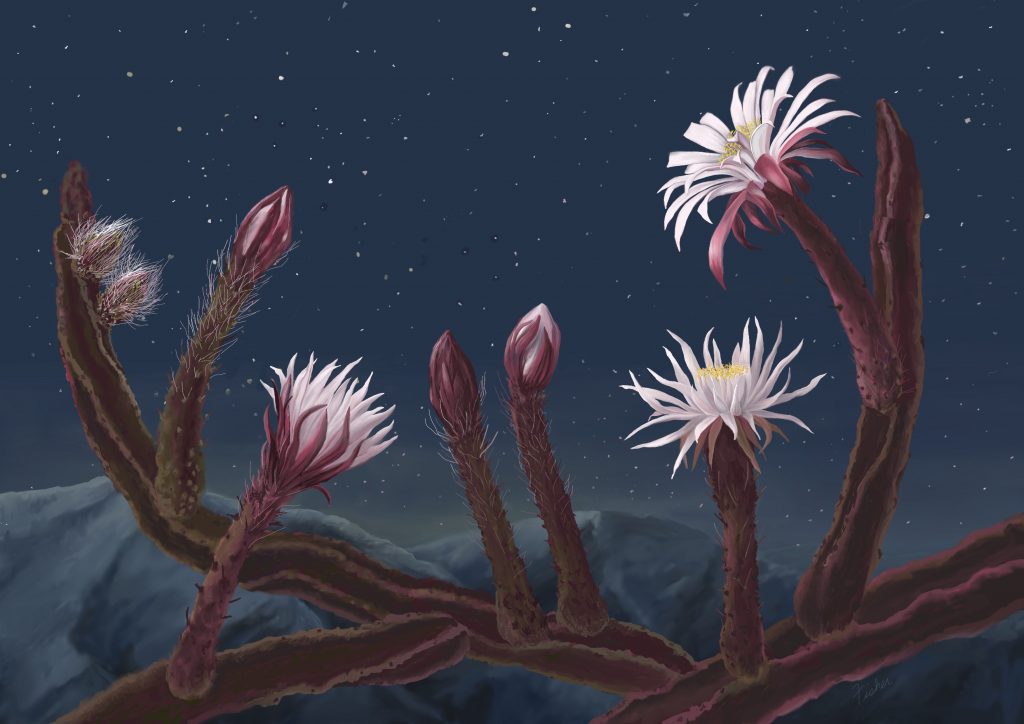
Queen for a Night
“Queen for a Night was made using the ProCreate app and then printed onto metal. I started out painting the blooms using pastels on paper. After several iterations, I switched to a digital drawing
More
format that provided the freedom to alter elements as the work evolved. This image is a fantasy celebration of these intriguing desert plants.”
Susan T. Fisher is the former Coordinator for the Botanical Art and Illustration Program at the Denver Botanic Gardens. She is also the former Director of the Art Institute at the Arizona-Sonora Desert Museum where she created the Nature Illustration Certificate Program. Susan is a past president and former member of the Board of Directors of the American Society of Botanical Artists and Honorary Director of the Rocky Mountain Society of Botanical Illustrators. Her artwork appears in numerous books, florilegia, private collections, and national exhibits including the Hunt Institute for Botanical Documentation.
To learn more about Susan Fisher and her work, Click Here
Wendy Islas
Magic
“Magic was photographed at Tohono Chul during Bloom Night, 2017. The Peniocereus greggi, also known as the Night Blooming Cereus or Queen of the Night, is a wondrous species that graces us with her beauty just one night a year. The magic
More
surrounding this bloom is wondrous. These plants magically communicate to one another to orchestrate a simultaneous bloom that invites the hawk moth to pollinate. Truly, a spectacular and magical moment in nature and one that is just as spectacular to witness and capture. The allure of the Night Blooming Cereus is strong and it just may call you back for more, as it does me.”
Wendy L. Islas served twenty-six years as a probation officer/supervisor, with close to twenty of those years in Pima County. Following her retirement, she rediscovered her love of Arizona, nature and the outdoors. She enjoys hiking, exploring, road trips, camping, and photographing Arizona’s nature and landscapes. She also volunteers her time helping to keep nature wild at organized clean-up events as well as on her own.
Wendy’s photography was included in the Tumacacori National Historic Park’s 2018, ART IN THE PARK exhibit. Wendy also has several photographs in the 2019 Discover Southern Arizona Magazine. Her photography is included as the February 24, 2018, “Photo of the Day” on the Arizona Highways Magazine website and she frequently participates in the Arizona Highway Magazine’s weekly Facebook photography themes. Wendy has also collaborated with the Nogales-Santa Cruz County Chamber of Commerce. As a self-taught photographer, she gleans knowledge from various sources including fellow photographers, research, workshops, and hours of practice.
To learn more about Wendy Islas and her work, Click Here
Joan McGann
Queen of the Night and the Sphinx Moth
“I received a blank wooden matryoshka from a friend travelling in Russia and thought that the forms leant themselves to the shape of many cactus species. I have completed several groups of these nesting dolls since then. Colored pencil adheres well to the
More
surface of the linden wood and I finish them with UV archival varnish. While the Peniocereus greggii species is not barrel shaped, I used that form to create the bloom and fruit. I have also included the Sphinx moth because it is an important pollinator for this night blooming cereus.”
Joan McGann current works in botanical illustration have an emphasis on plants native to the Sonoran Desert, several being protected and endangered species. The forms and textures of cacti and succulents continue to be the most fascinating plant specimens for her drawings. Joan works with graphite pencil, colored pencil, pen and ink, and watercolor.
[/expand]

To receive regular updates of our exhibitions and receptions, subscribe below and when prompted, select the Exhibition Announcements & Receptions email list.
For Artists: To receive emails with exhibition opportunities including calls-for-entries, subscribe below and select the News and Opportunities for Artists email list.

